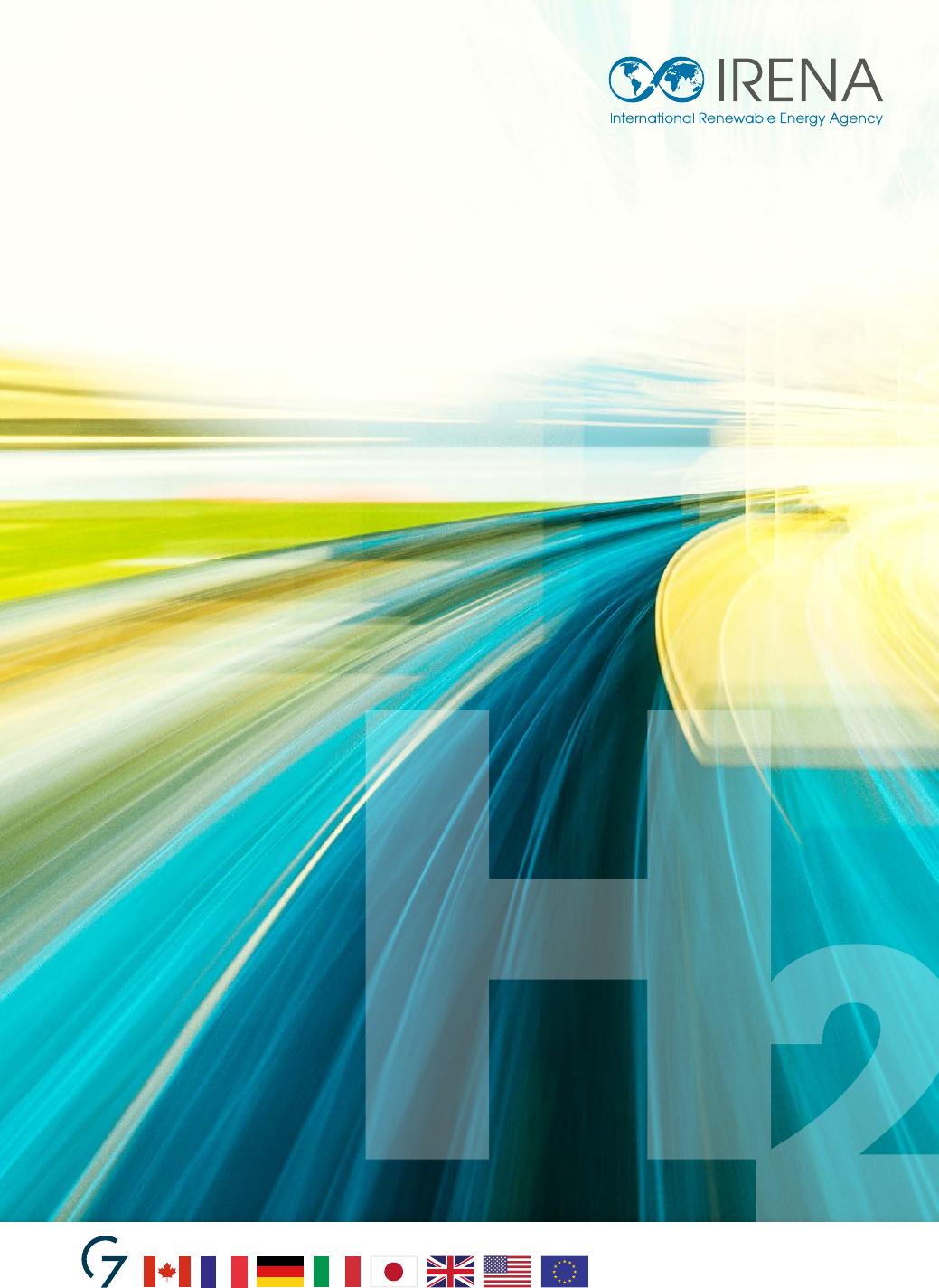ACCELERATINGHYDROGENDEPLOYMENTINTHEG7RECOMMENDATIONSFORTHEHYDROGENACTIONPACT2©IRENA2022Unlessotherwisestated,materialinthispublicationmaybefreelyused,shared,copied,reproduced,printedand/orstored,providedthatappropriateacknowledgementisgivenofIRENAasthesourceandcopyrightholder.Materialinthispublicationthatisattributedtothirdpartiesmaybesubjecttoseparatetermsofuseandrestrictions,andappropriatepermissionsfromthesethirdpartiesmayneedtobesecuredbeforeanyuseofsuchmaterial.ISBN:978-92-9260-479-0Citation:�IRENA(2022),AcceleratinghydrogendeploymentintheG7:RecommendationsfortheHydrogenActionPact,InternationalRenewableEnergyAgency,AbuDhabi.ABOUTIRENATheInternationalRenewableEnergyAgency(IRENA)isanintergovernmentalorganisationthatsupportscountriesintheirtransitiontoasustainableenergyfuture,andservesastheprincipalplatformforinternationalco-operation,acentreofexcellence,andarepositoryofpolicy,technology,resourceandfinancialknowledgeonrenewableenergy.IRENApromotesthewidespreadadoptionandsustainableuseofallformsofrenewableenergy,includingbioenergy,geothermal,hydropower,ocean,solarandwindenergy,inthepursuitofsustainabledevelopment,energyaccess,energysecurityandlow-carboneconomicgrowthandprosperity.www.irena.orgACKNOWLEDGEMENTSIRENAisgratefulfortheexternalreviewsandfeedbackreceivedfromJean-PhilippeBernier(NRCan/Canada),NoamBoussidan(WEF),HélèneChraye(EuropeanCommission),TudorConstantinescu(EuropeanCommission),MarcelloCapra(MinistryofEcologicalTransition/Italy),LauraDroste(DENA),ClarisseDurand(MinistryofEcologicalTransition/France),ChristineFalken-Großer(BMWK/Germany),AaronHoskin(NRCan/Canada),RuudKempener(EuropeanCommission),FlorianKnobloch(BMWK/Germany),MaryMarquez(NRCan/Canada),YuryMelnikov(Consultant),JoséMiguelBermúdezMenéndez(IEA),HeinovonMeyer(PtXHub),MikakoMiki(METI/Japan),FrankMischler(GIZ),DariaNochevnik(HydrogenCouncil),MarionNoel(MinistryofEcologicalTransition/France),MisaOkano(METI/Japan),AlessandroPolito(EuropeanCommission),StefanoRaimondi(MinistryofEcologicalTransition/Italy),ClaudieRoy(NRCan/Canada),MatthjisSoede(EuropeanCommission),KaiTateda(METI/Japan)andHirokiYoshida(METI/Japan);aswellasofficialsattheDepartmentforBusiness,EnergyandIndustrialStrategy(UnitedKingdom),andrepresentativesfromtheUnitedStatesDepartmentofEnergyforreviewingportionsofthisreport.IRENAwouldalsoliketothanktheGermanFederalMinistryforEconomicAffairsandClimateActionfortheirsupportinmakingthisreportpossible.ThereportwasauthoredbyEmanueleBianco,HeribBlancoandBarbaraJinks(IRENA)undertheguidanceofDolfGielen(formerDirector,IRENAInnovationandTechnologyCentre).Additionalvaluablecomments,suggestionsandsupportwereprovidedbyIRENAcolleaguesFranciscoBoshell,UteCollier,JaidevDhavle,BenjaminGibson,StevenGo,FrancescoPasimeniandFaranRana.Designbyweeks.de,Munich.DISCLAIMERThispublicationandthematerialhereinareprovided“asis”.AllreasonableprecautionshavebeentakenbyIRENAtoverifythereliabilityofthematerialinthispublication.However,neitherIRENAnoranyofitsofficials,agents,dataorotherthird-partycontentprovidersprovidesawarrantyofanykind,eitherexpressedorimplied,andtheyacceptnoresponsibilityorliabilityforanyconsequenceofuseofthepublicationormaterialherein.TheinformationcontainedhereindoesnotnecessarilyrepresenttheviewsofallMembersofIRENA.ThementionofspecificcompaniesorcertainprojectsorproductsdoesnotimplythattheyareendorsedorrecommendedbyIRENAinpreferencetoothersofasimilarnaturethatarenotmentioned.ThedesignationsemployedandthepresentationofmaterialhereindonotimplytheexpressionofanyopiniononthepartofIRENAconcerningthelegalstatusofanyregion,country,territory,cityorareaorofitsauthorities,orconcerningthedelimitationoffrontiersorboundaries.3ACCELERATINGHYDROGENDEPLOYMENTINTHEG7FrancescoLaCameraDirector-GeneralInternationalRenewableEnergyAgencyIthasbecomeclearthathydrogenmustplayakeyroleintheenergytransitioniftheworldistomeetthe1.5°CtargetoftheParisAgreement.Inparticular,lowcarbonandgreenhydrogenoffervitalopportunitiesforthedevelopmentofhard-to-decarbonisesectorsthatcannotbeelectrified,orwhichhavenoviablealternativestofossilfuels–suchasindustryandheavytransportincludingaviation,shippingandroadhaulage.Thepotentialofhydrogeniswellunderstood,andhasbeenasubjectofIRENAanalysesandstudiessince2018.Whatismoreimportantnowistoimplementpoliciesandregulatoryframeworks,andtoprovideincentivestoestablishandramp-upanewhydrogenindustry.Giventhatindividualnationsareunabletodothisalone,thefocusmustbeonfosteringclosercollaborationbetweencountriestodevelopthemechanismtoenablenewhydrogenmarkets.TheannouncementbytheGermanG7PresidencyoftheG7HydrogenActionPactinMay2022signalledtheGroup’sintenttostrengthenjointdevelopmentofhydrogenandpower-to-Xvaluechains,andtostreamlinetheimplementationofexistingmultilateralinitiativesthatarecommittedtodeployinghydrogen.TheanalysisundertakenbyIRENAtoassistthedevelopmentoftheHydrogenActionPactresultedintherecommendationspresentedinthisreport.TheseaimtosupporttheeffortsbyG7leaderstoalignpolicymakingandprioritiseactionstoharmonisestandardsandcertification;sharelessonsfromearlyimplementation;balancethefocusonsupplywithdemandcreation;promotehydrogenuptakeinindustrialapplications;andestablishmoretargetedcollaborationwithindustrystakeholdersandcivilsociety.ThisworkwasmadepossiblebytheengagementofdelegatesoftheG7countries,undertheleadershipoftheGermanFederalMinistryforEconomicAffairsandAction(BMWK).TheG7groupofcountrieshastheopportunitytoplayaleadingroleinacceleratingthedevelopmentofaglobalhydrogenmarket.Therecommendationspresentedinthisreportmarkthestartofthisjourneyforthepolicymakersandstakeholderswhowillfacilitateanewhydrogentrade.ItistimeforactionandIRENAremainscommittedtoworkingwithG7leaderstoensureafair,sustainableandsecureenergytransition.FOREWORD4CONTENTS01.G7ANDTHEHYDROGENSECTOR....161.1.Introduction................................................161.2.EnergyandhydrogenoverviewintheG7....................191.3.Country-specificfactsheets................................40CANADA........................................40EUROPEANUNION..............................48FRANCE.......................................56GERMANY......................................65ITALY...........................................73JAPAN..........................................80UNITEDKINGDOM...............................88UNITEDSTATESOFAMERICA....................96EXECUTIVESUMMARY.....................10Figures....................................................06TablesandBoxes..........................................08Abbreviations..............................................09ACCELERATINGHYDROGENDEPLOYMENTINTHEG7502.CROSSSTRATEGYANALYSIS.........1052.1.Policyframing.............................................1062.2.Hydrogenpriorities........................................1072.3.Hydrogenpolicies..........................................1112.4.Hydrogenvalleys..........................................1152.5.Hydrogendefinitionandsupport...........................1152.6.Unevenhydrogendiplomacy...............................1162.7.Differentiatedstagesofdeployment........................11703.RECOMMENDATIONSFORTHEG7....119PILLAR01Aligneffortsonstandardsandcertification........121PILLAR02Collaborateinternationallyandsharelessonsfromearlyimplementation......................123PILLAR03Balancefocusonsupplywithdemandcreation...125PILLAR04Promotehydrogenuptakeinindustrialapplications......................................127PILLAR05Conductoutreachtocivilsocietyandindustrystakeholders.....................................129References.....................................................131Annex–Methodologyforestimatingrenewablepotential........1376ACCELERATINGHYDROGENDEPLOYMENTINTHEG7ACCELERATINGHYDROGENDEPLOYMENTINTHEG7FIGURESFigureS1RecommendationsforG7members.........................................12Figure1.1Primaryenergysupplymixandelectricitymixin2020byG7member.......20Figure1.2Globalhydrogendemandin2020andsharefromG7membersandChina(MtH2)...............................................................22Figure1.3Hydrogenstrategypublishedorunderdevelopment,July2022.............23Figure1.4Hydrogendemandgrowthto2050byG7member(includinguncertainty)...24Figure1.5EstimatedhydrogenproductioncostfromsolarPVforG7membersin2021asafunctionofCAPEXandWACC....................................26Figure1.6G7members’shareofhighvalueinventionsoverthetotalinventionsandcountries’highvalueinventionshareinhydrogentechnologies..............29Figure1.7FlowofinternationalinventionsforG7members............................30Figure1.8SpecialisationindexofG7membersplusChinaconcerninghydrogentechnologyareas,comparingaveragevaluesintheperiods2010-2014and2015-2019..............................................................31Figure1.9Carbonpricinglevel,coverage,andtotalemissionsacrossG7members......33Figure1.10HydrogenCertificationMarketInitiatives....................................36Figure1.11LandtypesandexclusioncriteriaforrenewablepotentialestimationinCanada..................................................................42Figure1.12SupplycostcurveforCanadainalow-costscenarioin2030.................43Figure1.13HydrogenexportsfromCanadaacrossscenariosfor2050..................44Figure1.14LandtypesandexclusioncriteriaforrenewablepotentialestimationintheEuropeanUnion............................................................50Figure1.15SupplycostcurvefortheEuropeanUnioninalow-costscenarioin2030......51Figure1.16TotalhydrogenimportstotheEuropeanUnionacrossscenariosfor2050....52Figure1.17Surveyofhydrogendemandestimatesfor2050inFrance...................57Figure1.18LandtypesandexclusioncriteriaforrenewablepotentialestimationinFrance...................................................................59Figure1.19SupplycostcurveforFranceinalow-costscenarioin2030.................60Figure1.20TotalhydrogenimportstoFranceacrossscenariosfor2050..................61Figure1.21LandtypesandexclusioncriteriaforrenewablepotentialestimationinGermany.................................................................67Figure1.22SupplycostcurveforGermanyinalow-costscenarioin2030...............68Figure1.23TotalhydrogenimportstoGermanyacrossscenariosfor2050...............69Figure1.24LandtypesandexclusioncriteriaforrenewablepotentialestimationinItaly..75Figure1.25SupplycostcurveforItalyinalow-costscenarioin2030....................76Figure1.26TotalhydrogenimportstoItalyacrossscenariosfor2050....................777FIGURESFigure1.27LandtypesandexclusioncriteriaforrenewablepotentialestimationinJapan....................................................................82Figure1.28SupplycostcurveforJapaninalow-costscenarioin2030...................83Figure1.29TotalhydrogenimportstoJapanacrossscenariosfor2050..................84Figure1.30LandtypesandexclusioncriteriaforrenewablepotentialestimationintheUnitedKingdom......................................................90Figure1.31SupplycostcurvefortheUnitedKingdominalow-costscenarioin2030.....91Figure1.32LandtypesandexclusioncriteriaforrenewablepotentialestimationintheUnitedStates.........................................................98Figure1.33SupplycostcurvefortheUnitedStatesinalow-costscenarioin2030........99Figure1.34TotalhydrogenexportflowsfromtheUnitedStatesacrossscenariosfor2050...................................................................101Figure2.1Complementaritybetweenelectrificationandhydrogenacrossenduseapplications................................................................110Figure2.2Policyoptionstodealwiththecostgapforhydrogenderivativesandofftake................................................................112Figure2.3UseofastageapproachinfiveoftheG7members’strategies................117Figure3.1RecommendationsforG7members.......................................120FigureA.1Typesofrenewablepotentialsandapplicableconstraints....................138FigureA.2RangeofWACCbytechnologyandscenario...............................1438ACCELERATINGHYDROGENDEPLOYMENTINTHEG7TABLESBOXESTable1.1.Comparisonofvoluntarymechanismsforhydrogencertification............38Table1.2.Comparisonofmandatorymechanismsforhydrogencertification..........39Table1.3.AnalysisofCanadianhydrogenstrategicdocuments........................45Table1.1.AnalysisofEuropeanhydrogenstrategicdocuments........................53Table1.5.AnalysisofFrenchhydrogenstrategicdocuments...........................62Table1.6.AnalysisofGermanhydrogenstrategicdocuments.........................70Table1.7.AnalysisofItalianhydrogenstrategicdocuments...........................78Table1.8.AnalysisofJapanesehydrogenstrategicdocuments........................85Table1.9.AnalysisofUKhydrogenstrategy...........................................93Table1.10.AnalysisofU.S.hydrogenstrategicdocuments.............................102Table2.1.Statedpolicyframinginthehydrogenstrategicdocumentsandpolicies....106Table2.2.StatedpolicypriorityacrossG7strategicdocuments.......................108Table2.3.Terminologyusedforhydrogenacrossstrategies...........................115TableA.1.Sourcesanddatasetsusedforlandeligibilitycriteria.......................139TableA.2.CAPEXassumptionsforrenewableenergyin2030and2050inG7membersforanoptimisticscenario....................................142TableA.3.CAPEXassumptionsforrenewableenergyin2030and2050inG7membersforapessimisticscenario..................................142Box1.1.TheH2Globalprogramme..................................................729ABBREVIATIONSUNITSOFMEASUREACESadvancedcleanenergystorageBCAbordercarbonadjustmentBEISDepartmentforBusiness,EnergyandIndustrialStrategy(UK)BILBipartisanInfrastructureLaw(US)CADCanadiandollarCAPEXcapitalexpenditureCBAMcarbonborderadjustmentsmechanismCCfDcarboncontractsfordifferenceCCScarboncaptureandstorageCCUScarboncapture,utilisationandstorageCENEuropeanCommitteeforStandardisationCFPcallsforproposalCO2carbondioxideDRIdirect-iron-reducingDoEDepartmentofEnergy(US)DPADefenseProductionAct(US)ECMWFEuropeanCentreforMedium-RangeWeatherForecastsERA5fifth-generationECMWFreanalysisETSemissionstradingschemeEUEuropeanUnionEUReuroFCEVfuelcellelectricvehicleGATTGeneralAgreementonTariffsandTradeGBPUnitedKingdompoundGDPgrossdomesticproductGHGgreenhousegasGWPglobalwarmingpotentialH2hydrogenHAPHydrogenActionPactHINT.COHydrogenIntermediaryNetworkCompanyHRShydrogenrefuellingstationsICAOInternationalCivilAviationOrganizationIDAIndustrialDecarbonisationAgendaIECInternationalElectrotechnicalCommissionIMOInternationalMaritimeOrganizationIPCEIImportantProjectsofCommonEuropeanInterestIPHEInternationalPartnershipforHydrogenandFuelCellsintheEconomyISOInternationalStandardOrganisationIUCNInternationalUnionforConservationofNatureJPYJapaneseyenLCOHlevelisedcostofhydrogenLNGliquefiedfossilgasMCHmethylcyclohexaneNDCnationallydeterminedcontributionNECPNationalEnergyandClimatePlan(France)NH3ammoniaPEMpolymerelectrolytemembranePTXPowertoXPVphotovoltaicR&DresearchanddevelopmentSoTStateoftheTransitionSPPsustainablepublicprocurementTEStotalenergysupplyTFECtotalfinalenergyconsumptionUSDUnitedStatesdollarVREvariablerenewableenergyWACCweightedaveragecostofcapitalWTOWorldTradeOrganizationZEVzeroemissionvehiclebcmbillioncubicmetresCO2eqcarbondioxideequivalentEJexajoulegCO2grammeofcarbondioxideGJgigajouleGtgigatonneGWgigawattkgkilogrammekgCO2kilogrammeofcarbondioxidekgH2kilogrammeofhydrogenkmkilometrekm2squarekilometrektCO2eqkilotonneofcarbondioxideequivalentktH2kilotonneofhydrogenkWkilowattkWelelectrickilowattkWhkilowatthourLlitrem3cubicmetreMMBtumetricmillionBritishthermalunitMtmilliontonneMtCO2milliontonneofcarbondioxideMtH2milliontonneofhydrogenMWmegawattNm3/hnormalcubicmetreperhourt/dtonneperdaytCO2tonneofcarbondioxideTWterawattTWhterawatthourABBREVIATIONSANDUNITSOFMEASURE10ACCELERATINGHYDROGENDEPLOYMENTINTHEG7EXECUTIVESUMMARY””G7membersarecommittedtonet-zeroemissionsby2050atthelatest.Toachievethis,theywillneedtorelyonrenewableenergy,energyefficiencyandelectrification.Thiswillalsoprovideopportunitiesfordevelopinghydrogenandpower-to-Xproducts,whichhavebecomeprominentinenergypolicydiscoursesince2019,andnowallG7membershaveissuedstrategicdocumentsthatincludeanexpectedroleforlow-carbonhydrogenintheirsocieties.InMay2022,G7membersofficiallylaunchedtheHydrogenActionPact(HAP).Itsobjectivesincludestrengtheningjointactiononpower-to-X,hydrogenandderivatives(especiallyammonia),andstreamliningtheimplementationofexistingmultilateralinitiatives(G7,2022).Theactionsagreedareto:1.Acceleratethedevelopmentoflow-carbonandrenewablehydrogendomesticallyandatglobalscale,withemphasisonhard-to-abatesectors.2.Shaperegulatoryframeworksandstandardstofacilitateproduction,trade,transportanduseoflow-carbonandrenewablehydrogen.3.Securefinancialcommitmentsforthemarketramp-upoflow-carbonandrenewablehydrogen.4.Identifyandclosegapsfortheramp-upoflow-carbonandrenewablehydrogen.5.Exchangebestpracticesonsustainabilitycriteriaandfacilitatedialogueonthegeopoliticalimplicationsofaglobalhydrogenmarket.6.Supporttheroleoflow-carbonandrenewablehydrogenindecarbonisingthenaturalgasandpowersystems.11EXECUTIVESUMMARYG7membersalsorecognisetheimportanceofexploringthemeanstodecarbonisetheirindustrialsectors;inJune2021,theIndustrialDecarbonisationAgenda(IDA)waslaunchedtoenhancecollaborationamongG7membersintheareasofmarketregulation,decarbonisationstandardsdevelopment,investment,procurementstrategiesandjointresearchrelatedtoindustrialdecarbonisation.TheG7groupisalsocommittedtotheimplementationofpoliciesandstrategiesthatalignfinancialflowswiththegoalsoftheParisAgreement.ThesewillindirectlyaffectfinancialflowstowardshydrogenR&Dandprojects.Regardingindustrialactivity,theG7groupalsorecognisestheneedtocollaborateondevelopingmeasurementstandardstosettheemissionintensitythresholdofproductionandothersocialandgovernancemetrics.TheseeffortsarealsocloselyalignedwithinternationalinitiativessuchastheBreakthroughAgenda,launchedatCOP26.Thisreportsummarisesthestatusandoutlookforhydrogenintermsoftechnology,costs,strategyandpolicysupportintheG7memberjurisdictions.Themainreferenceusedforpoliciesineachcountryarehydrogenstrategies,togetherwithothercomplementarygovernmentannouncementsandpolicies.Theaimofthereportistwofold:topresentacross-strategyanalysisthatexaminestrends,commonpriorities,differencesandmisalignmentswithintheG7membership;andtoidentifythemainareasinwhichcollaborationamongG7memberscanmakethegreatestdifferenceinadvancinghydrogendeployment.ThereportalsoprovidesfivesetsofspecificrecommendationsthatG7memberscanfollowtoenacttheHAP.Therecommendationsfocusonthehydrogenvaluechainonly;theavailabilityoflow-cost,carbon-free,renewable-basedelectricityisnotincludedbutisacriticalenablingfactorfortheprovisionoflow-carbonandrenewablehydrogen(FigureS.1).12ACCELERATINGHYDROGENDEPLOYMENTINTHEG7FIGURES.1RecommendationsforG7membersIncreaserenew-ablehydrogenresourcesConductoutreachtocivilsocietyandindustrystakeholdersBalancefocusonsupplyanddemandcreationPromoteindustrialuseanduptakeCollaborateandsharelessonsAligneortsonstandardsandcertification01Pillar01:AligneffortsonstandardsandcertificationTheG7isworkingcloselywiththeInternationalPartnershipforHydrogenandFuelCellsintheEconomy(IPHE),whichisdevelopingamethodologyforcertifyingemissionsfromhydrogenproductionandtransportthatwillbeusedasinputtodevelopaninternationalstandardfromtheISO.TheG7canleadtheprogressincertificationofhydrogenbydrivingtheefforttoagreeonacommonmethodologytomeasuregreenhousegas(GHG)emissionsacrossthevaluechainforconsolidationunderaninternationalstandard.Recommendation1.1:Establishcommonsustainabilitycriteriafortradedandsupportedhydrogen.Recommendation1.2:Alignmethodologiesforhydrogencertification.Recommendation1.3:Spearheadeffortstosetharmonisedtechnicalstandards.13EXECUTIVESUMMARY0203Pillar02:CollaborateinternationallyandsharelessonsfromearlyimplementationG7membersareamongthefirstmoversinthenewhydrogensector,withspecificpoliciesandincentivesinplace.Thispresentsanopportunitytosharetheirexperiencestoenableafasteruptakeofbestpractices,includingsustainabilityandsocialaspects.Atthesametime,theG7representsalmost90%ofthepublicR&Dbudgetforhydrogenandfuelcells,andabout73%ofinternationalinventionsacrosshydrogentechnologies.ThisprovidestheG7withvaluableknowledgeofhydrogentechnologiesfromwhichothercountrieswillbenefitandwhichcouldleadtotheaccelerationofglobaldecarbonisation.Recommendation2.1:SupportthesustainabledevelopmentofhydrogeninGlobalSouthcountries.Recommendation2.2:Sharelessonslearntasfirstmovers.Recommendation2.3:Implementinnovativeschemessuchasregulatorysandboxesforhydrogenvalleys.Recommendation2.4:Addresstechnologygapsandtransfertechnologyknowledge.Pillar03:BalancefocusonsupplywithdemandcreationThecurrentfocusofpolicymakersisonthesupplysideofhydrogengeneration;butwithoutofftake,projectsremainriskyanddevelopmentlimited.Inaddressingthis,G7membershaveanopportunitytoadoptnewpoliciestosupportboththesupplyandthedemandforgreenhydrogen.WithintheG7framework,membersshouldsignaltheircommonintentthroughclearsupportwithprioritisationforspecificendusesandcreateabulkdemandforhydrogeninthemostcriticalhard-to-decarbonise(commonlyknownas‘hard-to-abate’)applications.Recommendation3.1:Prioritisehard-to-abateindustrialapplicationsforhydrogendemand.Recommendation3.2:Agreeoncommonactionstodecarboniseshippingandaviation.Recommendation3.3:Co-ordinatesupplyanddemand.Recommendation3.4:Planthescale-upoffinancing.14ACCELERATINGHYDROGENDEPLOYMENTINTHEG70504Pillar04:PromotehydrogenuptakeinindustrialapplicationsThegreenhydrogenindustrialsectorisstillinitsinfancy–notyetcost-competitivewithgreyhydrogen.Assuch,itisagoodcandidatefornew,adaptiveindustrialpolicymaking.Industrialpoliciescanbedefinedasarangeofpolicyinterventionsaimedatguidingandcontrollingthestructuraltransformationprocessofaneconomy.TheG7members,whichaccountforsomeofthemostindustrialisedcountriesintheworld,thushavetheopportunitytoactasapivotforthehydrogenmomentumneededtoadoptanewsetofindustrialpoliciestosupportthetransformationofindustryatlarge.Recommendation4.1:Testandimplementnewpoliciesfortheuptakeofgreenproducts.Recommendation4.2:Addresscarbonleakageandcreatealevelplayingfield.Recommendation4.3:Supportdisruptiveandstep-changingtechnologies.Pillar05:ConductoutreachamongcivilsocietyandindustrystakeholdersAwarenessisasteppingstonetowardcreatingpublicacceptance.Thisisessentialinsecuringthelegitimacyofthepoliciesandpublicinvestmentchoicesrelatedtoanewproductsuchashydrogen,andinavoidingoppositionandresistancetoitsuptake.Acceptancehingesonpolicyfairness,meaningthatthepolicycostsandbenefitsaredistributedequitably.Citizenparticipationisessentialforpublicacceptanceandcanbeenabledbyaunifiedmessageonthefutureofhydrogen,viadirectengagementandbyprovidingclearinformationongreenproducts.Recommendation5.1:Adoptaunifiedmessagearoundhydrogenandincreaseawareness.Recommendation5.2:Involvecivilsocietyinthegovernanceofthehydrogensector.Recommendation5.3:Introduceandsponsoraninternationaleco-labelforhydrogen-basedproducts.EXECUTIVESUMMARYTheapplicationofsuchrecommendationsmayrequiretheadaptationoflocalpoliciesandplans.Thisisnotunusualinpolicymaking.Agoodpracticeisindeedtomaintainflexibilityinpolicydesignandtohavestrategiesthatareabletoreacttochangesinmarketsituationsandnewtechnologicaldisruptions.Asthegreenhydrogensectorisboundtoevolverapidly,thepoliciesregulatingitarecertaintochange.Promptlysharinglessonslearntcanbekeyinmakingsuchchangessuccessfulandacceleratinghydrogendeployment.Forallrecommendations,G7membersmayneedtofindthemostsuitableinitiativesandplatformstotakesomeoftheactionsforward.TheIRENACollaborativeFrameworkonGreenHydrogen–theintergovernmentalplatformwiththewidestglobalmembershipcoverage–canserveastheplatformforinformationsharingandcollaborationonallissuesrelatedtogreenhydrogen.Finally,theserecommendationsareintendedaslong-termcommitmentsbetweenG7membersandpotentialhydrogentradingpartners.Theiradoptionandapplicationwillrequireanimplementationprocessthatincludesmonitoringandevaluationinordertoensuretheireffectiveness.15©Vertigo3diStock.com16ACCELERATINGHYDROGENDEPLOYMENTINTHEG7G7ANDTHEHYDROGENSECTORCHAPTER011.1INTRODUCTIONHydrogenactivitieswithintheG7contextInMay2022,theG7membersofficiallylaunchedtheHydrogenActionPact(HAP).Itsobjectivesincludedstrengtheningjointactiononpower-to-X,hydrogenandderivatives(especiallyammonia),andstreamliningtheimplementationofexistingmultilateralinitiatives(G7,2022).Theactionsagreedwere:1.Acceleratethedevelopmentoflow-carbonandrenewablehydrogendomesticallyandatglobalscale,withemphasisonhard-to-abatesectors.2.Shapetheregulatoryframeworkandstandardstofacilitateproduction,trade,transportanduseoflow-carbonandrenewablehydrogen.3.Securefinancialcommitmentsforthemarketramp-upoflow-carbonandrenewablehydrogen.4.Identifyandclosegapsfortheramp-upoflow-carbonandrenewablehydrogen.5.Exchangebestpracticesonsustainabilitycriteriaandfacilitatedialogueonthegeopoliticalimplicationsofaglobalhydrogenmarket.6.Supporttheroleoflow-carbonandrenewablehydrogenindecarbonisingthenaturalgasandpowersystems.””17CHAPTER01©AchimWagnerMay2022,BerlinTheG7membersarealreadylookingatthedecarbonisationofindustrialsectors.InJune2021,theIndustrialDecarbonisationAgenda(IDA)waslaunchedtoenhancecollaborationamongG7membersintheareasofmarketregulation,decarbonisationstandardsdevelopment,investment,procurementstrategiesandjointresearchrelatedtoindustrialdecarbonisation(G7,2021a).Thisispartofabroaderdecarbonisationportfolioforindustrythatincludesenergyefficiency,circulareconomy,electrification,heatuse,wastereductionandcarboncaptureutilisationandstorage.TheG7membersarealsocommittedtoglobaleffortsbysupportinglow-andmiddle-incomecountriesthroughfinancialandtechnicalco-operation(G7,2021b).TheIDAhasalsorecognisedinitialemissionsthresholdsforlow-carbonandzero-emissionsteel,withthesebeing50kilogrammes(kg)to400kgofcarbondioxide(CO2)equivalentpertonneand40kgto125kgCO2equivalentpertonneforcementproduction(G7,2022).Theprecisethresholdvaluedependsontheamountofscrapuseandtheclinker-to-cementratio,respectively.Thesethresholdscanserveasastartingpointforfurtherdiscussion(G7,2022;IEA,2022a)TheIDAinitiativealsoincludesmarket-orientedapproachestosettheconditionsforalevelplayingfieldthatfostersfreeandfairtradethatpreventscarbonleakage(G7,2021a).TheG7groupisalsocommittedtotheimplementationofpoliciesandstrategiesthatalignfinancialflowswiththegoalsoftheParisAgreement(G7,2021b).Thesewillindirectlyaffectfinancialflowsforhydrogen.Regardingindustrialactivity,theG7membersalsorecognisedtheneedtocollaborateindevelopingmeasurementstandardsfortheemissionintensity(G7,2021b)ofproductionandothersocialandgovernancemetrics.EffortsbytheG7membersarealsocloselyalignedwithinternationalinitiatives.TheBreakthroughAgenda,launchedatCOP26,isoneofthemostrecentandoverarchingoftheseandaimstobringmultiplestakeholderstogether.Theinitiativeisendorsedby45governmentsandisinitiallyfocusedonfivesectors(called‘GlasgowBreakthroughs’):power,roadtransport,steel,hydrogenandagriculture(COP26,2021a).TheHydrogenBreakthroughisendorsedby35countriesandtheEuropeanCommissionandhasasitsmainstatement,“Affordablerenewableandlowcarbonhydrogenisgloballyavailableby2030”.Progressinthesesectorswillbeacceleratedthroughfourkeypriorities,thefirstofwhichisareportontheStateoftheTransition(SoT),whichprovidesanoverviewofthestatus,progress,gaps,opportunitiesandbenefitsofenhancedcollaboration.RecommendationsfromtheSoTreportarefocussedinfourareas:HYDROGENINTHEG718ACCELERATINGHYDROGENDEPLOYMENTINTHEG7demandcreation,internationalstandardsandcertification,innovation,andfinancing.Follow-upoftheSoTreportincludesbringingtogethergovernments,non-stateactorsandinternationalorganisationsfromleadinginitiatives;co-conveningministerialdiscussionsonthestateofthetransition;andencouragingnewleader-levelcommitments(COP26,2021b).ThereareseveralsynergiesbetweentheHydrogenBreakthroughandtheG7HAP.First,theBreakthroughperformedalandscapemappingofalltheactiveinitiativesagainsttheenablingconditionsthattheyfocusonaspartoftheSoTreport.TheHAPcouldusethismappingtoidentifythemostsuitableinitiativestotakeforwardtheHAPrecommendations.Second,alltheG7membersarepartoftheHydrogenBreakthrough,andthiscanprovideaplatformfortheG7tohaveabroaderinfluence.Intermsofhydrogenflow,forexample,theBreakthroughcoversaround66%ofglobaldemandwhiletheG7accountsforaround28%.Third,afundamentaldriverfortheinceptionoftheBreakthroughiscollaboration,whichisacommongoalfortheG7.ScopeofthisreportAllG7membersarecommittedtonet-zeroemissionsby2050atthelatest.Toachievethis,theywillhavetorelyonrenewableenergy,energyefficiency,electrificationandcarboncapture,storageandutilisation,andlow-carbonhydrogen.Thelatterbecameprominentinenergypolicydiscoursefrom2019,andnowallG7membershavestrategicdocumentspresentingtheexpectedroleoflow-carbonhydrogenintheirsocieties(hydrogenstrategies).Thisreportsummarisesthestatusandoutlookforhydrogenintermsoftechnology,costs,strategyandpolicysupportintheG7memberjurisdictions(Chapter1,Section1.2).Themainreferenceusedforpoliciesineachcountryistheirrespectivehydrogenstrategy(Section1.3).However,somestrategieswerepublishedbeforedevelopmentsintheenergysectorandinitsgeopoliticalstance–aswellasinthehydrogensectoritself–havetakenplace.Therefore,othergovernmentannouncementsandpoliciescomplementingthesestrategieshavealsobeenconsidered,whenapplicable.Across-strategyanalysislooksatestablishingtrends,commonpriorities,differences,andmisalignmentswithintheG7membership(Chapter2).ItalsoidentifiesthemainareaswherecollaborationamongG7memberscanmakethegreatestdifferenceinadvancinghydrogendeployment,whileprovidingspecificrecommendationsthatG7memberscantakeupineacharea(Chapter3).HYDROGENINTHEG7©onurdongeliStock.com19CHAPTER011.2ENERGYANDHYDROGENOVERVIEWINTHEG7TheG7representsabout30%ofglobalenergydemandand25%ofglobalenergy-relatedCO2emissions,whileaccountingforonly13%oftheglobalpopulation.Theaveragegrossdomesticproduct(GDP)percapitaintheG7is60%higherthantheglobalaverage.Incombinationwithaskilledworkforceanddevelopedindustry,thisgivestheG7anopportunitytodemonstrateleadershipinenergysystemtransition.G7membersrepresentabout16%ofglobalsteeldemand(WorldSteelAssociation,2022),about21%ofglobalammoniaproductionand11%ofglobalmethanolproduction(USGS,2022).Displacingfossilfuelsinheavyindustrycanalsoimproveenergysecurity.HeavyindustryinG7representsmorethan15%ofglobalcoaluseandabout10%ofglobaloilandfossilgasuse(IEA,2022a).TheenergystartingpointforeachG7memberisdifferent(seeFigure1.1.1).Whileacommonalityisthatoilrepresentsarelativelylargeshareoftheprimaryenergysupply(between28%and37%),givenitsuseinthetransportsector,otherenergycarriersshowsignificantvariationbetweencountries.Forinstance,coalrepresents28%oftheenergysupplyinJapanwith40%ofthisusedforsteelproduction(IEA,2021a).Incontrast,coalrepresents3.4%ofthesupplymixoftheUnitedKingdom(BEIS,2021a),havingdroppedbymorethan85%inthelastdecade(BEIS,2021a).Nuclearrepresentsalmost42%oftheenergysupplyinFrance.In2020,Canadaexported44%ofitsdomesticenergyproduction(IEA,2022b),whileJapansatisfies88%ofitsenergydemandwithimports(IEA,2021a).Focusingontheelectricitysector,thedifferencesarestarker.In2019,Japanproducedover70%ofitselectricity(IEA,2021a)fromfossilfuels,havingseentheshareoftheseincreaseafterthe2011Fukushimanuclearaccident.Overthelastdecade,nuclearhasrepresentedbetween80%and85%oftheelectricitymixinFrance(IEA,2021b).In2019,hydropowerwasabout60%oftheelectricitysupplyinCanada(GovernmentofCanada,2022).Thelargestshareofwindandsolarphotovoltaic(PV)amongG7membersisinGermany,wherealmostathirdoftotalelectricitygenerationcamefromthisin2021(Burger,2022).TheweightedaverageelectricityCO2emissionsintensityforG7memberswas45%belowtheglobalaveragein2020(273grammesofCO2perkilowatthour[gCO2/kWh]vs506gCO2/kWh).FranceandCanadawerealreadybelow70gCO2/kWhin2020,whenJapanhadthehighestemissionintensity,with466gCO2/kWh.InMay2022,theG7committedtoachievepredominantlydecarbonisedelectricitysectorsby2035(G7,2022).©JaramaShutterstock.com20ACCELERATINGHYDROGENDEPLOYMENTINTHEG7FIGURE1.1Primaryenergysupplymix(right)andelectricitymix(left)byG7member,2020BiofuelsandwasteTotalNaturalgasHydro100%80%60%40%20%0109876543210Primaryenergysupplymix(%)Totalenergysupply(EJ/yr)OtherrenewablesBiofuelsandwasteOilTotalenergysupplyCoalNaturalgasNuclearHydroFranceUnitedKingdomItalyCanadaJapanUnitedStatesEUGermany©kool99iStock.com©HorimonoiStock.com21CHAPTER01FIGURE1.1Primaryenergysupplymix(right)andelectricitymix(left)byG7member,2020(continued)BiofuelsandwasteOtherWindSolargCO2/kWh(2020)CoalNaturalgasNuclearHydro100%80%60%40%20%05004003002001000Electricitymix(%)AverageCO2emissions(gCO2/kWh)BiofuelsandwasteOtherWindSolarCO2emissionsperkWhCoalNaturalgasNuclearHydroFranceUnitedKingdomItalyCanadaJapanUnitedStatesEUGermanyHydrogendemandin2020TheaggregatedhydrogendemandforG7memberswasabout24.2milliontonnes(Mt)ofhydrogen(H2)in2020,representingalmost28%oftheglobaldemand(seeFigure1.2),justaboveChina’stotalconsumption.TheUnitedStates(US)isthelargestconsumerfromtheG7group,with11MtH2.TheEuropeanUnionfollowscloselybehindwithalmost7.7MtH2.Almosttwo-thirdsofthisdemandisforoilrefining,whilethemajorityoftheremainingthirdisfortheproductionofchemicals:ammoniaandmethanol.Whilethisistheaverage,specificcountrieshavesomemoredominantsectors.Forinstance,90%ofthehydrogendemandinJapanisforrefining,whilethesplitiscloserto50/50inGermany.22ACCELERATINGHYDROGENDEPLOYMENTINTHEG7Hydrogendriversand2050demandAhydrogenpolicyorstrategyisinfluencedbytheprioritiesanddriversofthetimeitwasadopted,changingitsframing,objectivesandpoliticalweight.Theinitialinterestinhydrogensolutionsbeforethe2020swasmostlydrivenbyoilpriceshocksandconcernsaboutpeakoildemandorairpollution.Asaresult,mostpoliciesfocusedonfuelcellelectricvehicles(FCEVs)andfuelcellapplicationswithgreyhydrogen.Morerecently,therehavebeentwofundamentaltrendsdrivingtheinterestinhydrogen:first,anincreasedfocusonnet-zeroemissions–bymid-2019,onlyabout16%ofglobalCO2equivalent(CO2eq)emissionswerecoveredbyanet-zerotarget,butthishadincreasedtoalmost83%bymid-2022(NetZeroTracker,2022).Second,thecostsofrenewableelectricitydrasticallydecreasedfrom2010to2021:by88%forsolarPV,68%foronshorewindand60%foroffshorewind(IRENA,2022b).Thefocusonnet-zerohascreatedtheneedtolookatalltheenergyenduses,includingthosewherethereisnoclearsingletechnologicalsolutionandthataredifficulttoelectrify(includingaviation,shipping,steelandchemicals),whilerenewableelectricitycostreductionhasledtorenewablehydrogenbecomingmoreattractive.Thishasledtoarapidgrowthinthenumberofcountrieswithhydrogenstrategies,withmorethan60beingdevelopedorunderdevelopmentFIGURE1.2Globalhydrogendemandin2020andsharefromG7membersandChina(MtH2)38.6%38.6%RestoftheWorldRestoftheWorld23.9%23.9%ChinaChina11.0%11.0%UnitedStatesUnitedStates0.5%0.5%UnitedKingdomUnitedKingdom2.0%2.0%JapanJapan0.5%0.5%ItalyItaly3.0%3.0%CanadaCanada4.9%4.9%EuropeanUnionEuropeanUnion0.9%0.9%FranceFrance1.7%1.7%GermanyGermany24.6%24.6%87MtSource:IRENA(2022a).Note:‘EuropeanUnion’inthisgraphexcludesdemandfromFrance,GermanyandItaly.23CHAPTER01FIGURE1.3Hydrogenstrategiespublishedorunderdevelopment,July2022JapanRepublicofKoreaChileAustraliaColombiaMoroccoOmanKuwaitParaguayUruguayEgyptSaudiArabiaMalaysiaThailandRussianFederationChinaUzbekistanNewZealandUnitedKingdomEuropeanUnionCanadaAlgeriaTunisiaArgentinaBolivia(Plur.Stateof)PeruTrinidad&TobagoUnitedStatesSouthAfricaIndiaUAEBrazilIrelandTürkiyeNorwayNamibiaSingaporeItalySpainPortugalFranceFinlandDenmarkGermanyAustriaNetherlandsBelgiumLuxembourgCroatiaPolandSwedenCzechRepublicSlovakiaHungaryGreeceRomaniaSwitzerlandEstoniaLithuaniaSerbiaCostaRicaElSalvadorPanamaDraftingStrategyRoadmapstageKazakhstanNote:“Strategy”indicatesanofficialfinaldocumentapprovedbythegovernment.“Roadmap”indicatesthepublicationofapreliminarydocument.“Drafting”isforcountriesforwhichthereisanofficialannouncementthatastrategyisbeingdeveloped.Hydrogenpoliciesareevolvingrapidly.Informationonthisfigurehasbeenkeptasdetailedandcompleteaspossibleatthetimeofwriting,howevermorecountriesmayhaveannounced,draftedandpublishedhydrogenstrategies.Disclaimer:Thismapisprovidedforillustrationpurposesonly.BoundariesandnamesshownonthismapdonotimplytheexpressionofanyopiniononthepartofIRENAconcerningthestatusofanyregion,country,territory,cityorareaorofitsauthorities,orconcerningthedelimitationoffrontiersorboundaries.atthetimeofwriting(seeFigure1.3).Theprivatesectorhasnotremainedidle,either,withmorethan1500hydrogen-relatedprojectsbeingannounced,globally,bymid-2022.24ACCELERATINGHYDROGENDEPLOYMENTINTHEG7Inanet-zeroemissionssystemscenario,theroleofhydrogenisdefinedbytheassumptionsforthecompetingdecarbonisationalternatives(namelyrenewableenergy,electrification,energyefficiency,bioenergyandcarboncapturestorageandutilisation),theextenttowhichhydrogenpathwaysareconsidered(ifallthehydrogenderivativesareincludedwithalltherelevantenduses),andhydrogentechnologycostevolution.Consideringthesefactors,hydrogendemandintheG7mayincreasebyfourtoseventimescomparedto2020tosatisfytheneedsofanet-zeroemissionssystemby2050(seeFigure1.4).Currently,hydrogenuseissplitmostlyacrosstwoapplications:refiningandchemicals.By2050,thepictureismuchmorediversethankstoinnovationandtheneedfordecarbonisation.FIGURE1.4Hydrogendemandgrowthto2050byG7memberBasedon:NaturalResourcesCanada,(2020);Guidehouse,(2021);Schelleretal.,(2022);ADEME,(2021);EuropeanCommissionJointResearchCentre,(2019);METI,(2020);Satyapal,(2022);Ruthetal.,(2020);BEIS,(2021b).Note:Hashedpatterndenotesuncertaintyinhydrogendemand.Hydrogendemandincludesproductionofderivatives,wherepossible.Hydrogendemand(MtH2/yr)02040602020205080100120140160180200CanadaFranceItalyJapanGermanyUnitedKingdomEuropeanUnionUncertaintyUnitedStates24.5Mt192Mt25CHAPTER01HydrogenproductionpotentialandcostintheG7Countriesandregionswithhighrenewablepotentialorfossilgasreservescanusetheirresourcestobecomemajorproducersofhydrogen.TheabilityofG7memberstoproducegreen1orblue2hydrogenvarieswidely.AmongG7members,CanadaandtheUnitedStateshavethelargestfossilgasreserves,togetherrepresenting8%oftheglobaltotal(with84%ofthosereservesintheUnitedStates).Thisisenoughtoproduceacumulativeamountof3100MtH2.Withgaspricesatpre-2021levels,bluehydrogenpricescouldhavereachedUSD1.00/kgH2toUSD1.30/kgH2.3Amainconstraintforrenewablehydrogenistherenewableelectricityproductionpotential,whichislimitedbythelandavailabletoinstallrenewablecapacity,thequalityoftheresourceandhowdenselythefacilitiescanbeinstalled(megawatt[MW]/squarekilometre[km2]).Thelargestuncertaintyisthelandavailability.Thetechnicalpotential,asusedinthisreport(seeAnnexformoredetailsonthemethodology),considersthetotallandofaregionandappliesseveralexclusionzones,includingprotectedareas,forests,permanentwetlands,croplands,urbanareas,aslopeof5%(forsolarPV)and20%(foronshorewind),populationdensity(excludingareaswithadensityhigherthan130peopleperkm2),andwaterstress.Furthertechnicalconstraintscouldbeincluded(e.g.distancetoexistingelectricityandgasinfrastructure,ports,roads,demandcentres).Similarly,socio-politicalcriteria(e.g.socialacceptanceofrenewabletechnologies)couldreducethepotentialfurther.Theseadditionalcriteriawerenotusedsinceitcouldleadtoaconservativenumberthatmightnotberepresentativeforsomecountries.Assuch,thepotentialvaluesrepresentanupperboundwithdownsidepotential.Anotherconstraintforrenewablehydrogeniswateravailability.Thewaterrequirementforelectrolysisis18litres(L)to24Lperkilogrammeofhydrogen(kgH2)whenconsideringthewatertreatmentlosses(Lampertetal.,2016).Furthermore,electricitygenerationconsumes0.2L/kgH2to2.1L/kgH2foronshorewindand2.4L/kgH2to19L/kgH2forsolarPV(Jinetal.,2019).Evenwhenconsideringtheworstcaseforwatersupply,desalination,thecostandenergyconsumptionofwatertreatmentisrelativelysmall.Thecostwouldbe,atmost,aroundUSD0.05/kg(lessthan2%thetypicalhydrogencost)andtheenergyconsumptionwouldbeontheorderof1%oftheelectricityusedbytheelectrolyser(Blanco,2021).Lackofaccesstowatercanreducetheamountoflandavailableforrenewablehydrogenbymorethan50%forSaudiArabia,theMiddleEast,NorthAfricaandEastAsia(IRENA,2022b).Forrenewablehydrogen,CanadaandtheUnitedStatesaretheG7memberswiththelargestpotential–70and100times,respectively,oftheirexpected2030demand.Thisisduetothelargelandareathesecountriespossess.AttheotherextremeisJapan,whichwouldbeabletoproducelessthan3%ofthehydrogenitneedsatacostlowerthanUSD2/kgH2.TherestoftheG7memberswouldbeabletoproducethreetofivetimeswhattheyneedby2030at1Producedthroughelectrolysisusingrenewableelectricity.2Producedthroughreformingofnaturalgascombinedwithcarboncaptureutilisationandstorage.3Notallthishydrogenwouldbeavailableatthesamecostbecausethegasproductioncostwillincreaseastheresourceisexploited.26ACCELERATINGHYDROGENDEPLOYMENTINTHEG7acostlowerthanUSD2/kgH2,butthiswouldquicklydecreaseasdemandrisestowardsits2050value.Anadvantageforrenewablehydrogenisthattheamountofhydrogenthatcanbeproducedbelowacertainthresholdwillincreaseovertimeastechnologiesbecomecheaperandtheproductioncostdecreases.Renewablehydrogendoesnotuseanyfuel,andallthecostscomefromphysicalassets.Thecostofelectricityisthedominantdriver,anditisdefinedbythecapitalexpenditure(CAPEX)andoperatinghoursoftheupstreamrenewablegeneration.Thismakesweightedaveragecostofcapital(WACC)akeyparameterdefiningthehydrogenproductioncost.In2020,WACCacrossG7membersrangedfrom1.95%inGermanytomorethan8%inpartsoftheEuropeanUnion(Croatia)forsolarphotovoltaic(PV).Atthesametime,theCAPEXforsolarPVdifferedbyafactorofmorethantwoacrossG7members,fromUSD694/kilowatt(kW)inGermanytomorethanUSD1693/kWinJapan(IRENA,2022b).Basedonthesefactors,thecheapesthydrogenproductionfromsolarPVamongG7membersisGermany,withUSD4.1/kgH2(seeFigure1.5),despitehavingarelativelylowresourcequality(fullloadhoursoverayeararelessthan15%inthebestlocations)thanothermembers.ThecombinationoflowCAPEXandWACChavealargerinfluenceonthecost.FIGURE1.5EstimatedhydrogenproductioncostfromsolarPVforG7membersin2021asafunctionofCAPEXandWACCNote:BubblesizerepresentsthelevelisedcostofhydrogenproductioninUSD/kgH2.SpainisusedfortheEuropeanUniontoshowthebestcaseintermsofsolarirradiation.SolarPVfacilityisoversizedtooptimisehydrogenproductioncost.GlobalCAPEXfortheelectrolyserisassumedtobeUSD1000/electrickilowatt(kWel)andwiththesamecostratiosbetweencountriesassolarPV.20001500100050000%1%2%3%4%5%6%CapitalcostofsolarPV(USD/kW)Weightedaveragecostofcapital(%)Canada6.7USD/kgEuropeanUnion4.3USD/kgFrance4.0USD/kgGermany4.0USD/kgItaly4.0USD/kgJapan8.9USD/kgUnitedKingdom5.4USD/kgUnitedStates5.6USD/kgCanada6.7USD/kgEuropeanUnion4.3USD/kgFrance4.0USD/kgGermany4.0USD/kgItaly4.0USD/kgJapan8.9USD/kgUnitedKingdom5.4USD/kgUnitedStates5.6USD/kg27CHAPTER01Theelectrolyserneedstooperateatleast2500to3000hoursayeartobeabletoachievethelargestreductioninthecostcontributionfromtheCAPEXcomponent(IRENA,2020).WhencoupledwithsolarPV,thegenerationplantneedstobeoversizedtoreachsuchanumberofoperatinghours,andsomeelectricitywillbecurtailed.ForG7members,theoptimalconfigurationsattheirbestlocationshaveaPVcapacitythatisdoubletheonefromtheelectrolyser,curtailing11%to18%oftheelectricity.AnalternativetoimprovetheoperatinghoursoftheelectrolyseristocombinesolarPVwithonshorewind.TheoptimalconfigurationanddominantrenewabletechnologywilldependonthequalityoftherenewableresourcesandtheCAPEXratiobetweentechnologies.SolarPVneedstobeatleasttwotothreetimescheaperthanonshorewindtocompensatefortheloweroperatinghours.In2021,theglobalaverageCAPEXforonshorewindwasabout1.5timeshigherthanforsolarPV(USD1325/kWasopposedtoUSD857/kW)(IRENA,2022b).AnotheralternativetoimprovetheoperatinghoursoftheelectrolyseristousebatteriescoupledwithsolarPV.In2020,thecostofa4-hourLi-ionutility-scalebatterywasaboutUSD340/kWh(Coleetal.,2021).Thisisnotacost-effectiveconfiguration,butcostscoulddecreasetoaslowasUSD100/kWhby2050.EvenUSD150/kWhwouldbeenoughtohalvecurtailmentandmorethandoubletheoperatinghoursoftheelectrolyser,resultinginuptoa20%reductioninthehydrogenproductioncost.Therearethreeleverstoreducethehydrogenproductioncosts,inadditiontoreducingthecostofrenewableelectricity.First,economiesofscale.Forthestack(coreoftheelectrolyserwheretheelectrochemicalconversiontakesplace),costswilldecreaseasthemanufacturingplantsarescaledup.Thiscandecreasethecostcontributionoffixedcosts(e.g.labour,utilities,building)andprovideopportunitiestotransitiontoautomatedassembly.Thelargestbenefitsofincreasingmanufacturingcapacityarealreadyachievedatacapacityof1gigawatt(GW)/year.Asprojectsscaleup,equipmentcanbelarger,andthedesigncanbestandardised.Thiswillmainlyhaveapositiveimpactontherestoftheequipmentnotincludedinthestack(suchasvessels,compressorsandinverters).Thesecondleverislearningeffectsfromdeploymentthatareincorporatedintothedesign.Thiswillmainlybeforthestack,andestimatesrangefrom11%to18%costreductionforeverydoublingofglobaldeployment.Thethirdleveristhatinnovationscanimprovetheperformanceoftheelectrolyserbyincreasingefficiency,reducingthecostcontributionoftheelectricity,andincreasingtheoutputperelectrolyseralongwithareduceduseofmaterials.©ThomBalShutterstock.comHYDROGENINTHEG7HYDROGENINTHEG728ACCELERATINGHYDROGENDEPLOYMENTINTHEG7IndustrialleadershipandpatentsThestrategiesaccountforthepotentialbenefitthathydrogendeploymentcanprovidetodomesticindustryintermsofeconomicgrowthandjobcreation,whileplacinganemphasisonareaswhereacountrycandeveloptechnologicalleadership.OftheG7members,theEuropeanUnionasawholeandGermanyinparticularaimtobecometechnology(electrolysers)exporters,buildingontheirindustrialdevelopment.Bytheendof2021,roughlyhalfofallelectrolysermanufacturerswerelocatedinEurope4andtheircomponentsuppliersweremostlyEuropean(IRENAandEuropeanPatentOffice,2022;Suursetal.,2020).By2024,Europe,theMiddleEastandAfricaareprojectedtoaccountforabout20%ofelectrolysermanufacturingcapacity,basedonannouncedinvestmentplans(BNEF,2022).Fuelcellmanufacturing,forbothstationaryandtransportapplications,isledbyAsiancountries,whichaccountformorethanhalfoftheglobalmarket,followedbyNorthAmerica.China,Germany,Japan,theRepublicofKoreaandtheUnitedStatesaccountfor89%ofallpatentsforfuelcellsforvehicles.About65000inventions5forhydrogenwerefiledgloballybetween2010and2020.6G7membersaccountedforaround50%oftheseinventions,withabouttwo-thirdscomingfromJapan(Figure1.6).Chinahasbeenacceleratingpatentactivity,andwhileitrepresentedlessthan12%ofpatentsin2010,itreachedalmost30%ofthecumulativeinventionsby2020.Theoutlookisdifferentwhenconsideringhigh-valueinventions7(topofFigure1.6).Ofthetotalinventionsregardinghydrogen,24%areofhighvalue,andG7membersaccountforabout80%ofthetotal.Asmuchas38%ofhigh-valueinventionsrelatedtohydrogenstoragehavebeendevelopedbyEuropeanUnioncountries,withGermanyaloneaccountingfor20%ofthetotal.Concerningtheotherhydrogen-relatedtechnologies,theUnitedStatescovers31%ofthetotalinventionsinhydrogendistribution,whileJapanranksfirstonfuelcells,with39%ofthetotal(bottomofFigure1.6).4IncludingNorway,whichisneitheraG7membernorpartoftheEuropeanUnion.5Patentfamilyisusedtoproxyaninvention.Apatentfamilygroupstogetherpatentapplicationsthatprotectthesameinvention.Adashboardwithinteractivegraphscanbeaccessedonline(IRENAINSPIREwebtool,n.d.).6Patentdatafor2020arenotcompletebecauseofconfidentialityintheearlystageofthepatentingprocess.7Ahigh-valueinventionisaninventionprotectedinmorethanonepatentoffice.Anequalshareisassignedtoapplicantsandpatentofficesinthepatentfamily.©industryviewsShutterstock.com29CHAPTER01FIGURE1.6ShareofG7members’high-valueinventionsoverthetotalinventions(top)andcountries’high-valueinventionshareinhydrogentechnologies(bottom)200001600012000800040000CountryshareoftotalinventionsFranceUnitedKingdomItalyCanadaJapanUnitedStatesChinaRestoftheworldEUGermany0%25%50%75%100%FranceGermanyItalyJapanCanadaCountryshareofhydrogentechnologyinventionsFuelcellsHydrogenstorageHydrogenproductionHydrogendistributionEuropeanUnionUnitedKingdomUnitedStatesChinaRestoftheworldHighvalueinventionsInventionsNote:HydrogentechnologyisdefinedbymeansoftheCooperativePatentClassification(CPC):Y02E60/34Distribution,Y02E60/50Fuelcells,Y02E60/36ProductionandY02E60/32Storage.30ACCELERATINGHYDROGENDEPLOYMENTINTHEG7Lookingatinternationalinventions,8from2010to2020,about73%ofthesewerefiledbyG7members(leftsideofFigure1.7).Thedrasticdifferenceinthetotalnumberofinventionsisduetoonly2%oftheChineseinventionsbeingprotectedinternationally,representingjust3%oftheglobaltotal.Lookingatwheretheseinventionsareprotected(rightsideofFigure1.7),almosttwo-thirdsareprotectedinthreeG7members’patentoffices:theUnitedStatesPatentandTrademarkOffice(USPTO),theEuropeanPatentOffice(EPO)andtheJapanPatentOffice(JPO).TheChinaNationalIntellectualPropertyAdministration(CNIPA)isthemainnon-G7nationalpatentoffice,with18%ofinternationalinventions.8Internationalinventionsareinventionsprotectedinacountrydifferentfromthecountrywheretheinventionsaredeveloped.FIGURE1.7EstimatedhydrogenproductioncostfromsolarPVforG7membersin2021asafunctionofCAPEXandWACCCanadaCNIPAEPOJPOOthersUSPTOEUFranceGermanyItalyJapanUnitedKingdomUnitedStatesChinaRestoftheworldNote:Thecountriesontheleftarewhereinventionsaredeveloped.Thenational/regionalpatentofficeswhereinventionsareprotectedareontheright:theUnitedStatesPatentandTrademarkOffice(USPTO),theEuropeanPatentOffice(EPO),theJapanPatentOffice(JPO)andtheChinaNationalIntellectualPropertyAdministration(CNIPA).31CHAPTER019TheSpecialisationIndexrepresentspatentingintensityintechnologyforagivencountrycomparedtotheglobalactivity.Itiscalculatedas(i)thecounty’sshareofinventionsrelatedtoahydrogentechnologyoverthetotalhydrogeninventionsover(ii)theglobalshareofinventionsrelatedtothesamehydrogentechnologyoverthetotalhydrogeninventions.FIGURE1.8Specialisationindexforhydrogentechnologyareas,comparingaveragevaluesintheperiods2010-2014and2015-20191.180.160.881.04-0.03-0.180.501.69-0.150.10-0.17-0.34-0.31-0.070.15-0.080.130.37-0.190.890.020.070.39-0.04-0.451.62-0.310.641.00-1.00-0.011.22-0.120.241.160.870.070.06-0.29-0.06-0.09-0.32-0.021.000.21-0.16-0.140.410.74-0.320.06-0.02-0.06-0.310.84-0.81FuelcellsHydrogendistributionHydrogenproductionHydrogenstorageSpecialisationIndex(SI)ofhighvalueinventionsFranceUnitedKingdomItalyCanadaJapanUnitedStatesEUGermanyChinaRestoftheworldAverage2010-2014Average2015-20190.571.050.460.77-0.24-0.25-0.13-0.31-0.27-0.170.400.570.320.60-0.130.32-0.38-0.290000Lookingatthespecialisationindex9forhydrogentechnologies(seeFigure1.8),Japanhadapositiveindexinfuelcells,whilethecountriesoftheEuropeanUnionhadpositiveindicesinhydrogendistribution,productionandstorage,meaningthatthefocusontheseareaswashigherinthesecountriesthantheglobalaverage.TheUnitedStateshadthehighestindexinhydrogendistribution,whileChinashowsapositiveindexonhydrogenproductiononly.32ACCELERATINGHYDROGENDEPLOYMENTINTHEG7CarbonpricingHydrogeniscurrentlyusedinindustrialapplications,andthissectorwillrepresentmajordemandgoingforward(includingnewapplicationssuchassteel).Carbonpricingcanbeafundamentalincentiveforthetransitionoftheseindustrialassetstolow-carbonproduction.Atthesametime,industry(togetherwithpower)isoneofthesectorswiththewidestcoverageacrossemissionstradingschemes(ETS).In2021,therewere68carbonpricinginstruments(36carbontaxesand32ETS)covering23%ofglobalgreenhousegas(GHG)emissions,generatingaboutUSD84billionofrevenue(WorldBank,2022a).AllG7membershavesomeformofcarbonpricingimplemented(seeFigure1.9).Canadahasafederalbackstopthatservesasthestandardforprovincesandterritoriesthatdonothaveacarbonpriceinplace.Ithastwocomponents,achargeonfuels(basedoncarboncontent)andanoutput-basedpricingsystemforemissions-intensiveandtrade-exposedindustrialfacilitieslargerthan50kilotonnes(kt)ofCO2eqperyear.Thepricefor2022isCAD50/tonne(t)ofCO2(USD36/tCO2),increasingCAD15(USD10.85)peryearuntilitreachesCAD170.00/tCO2(USD123/tCO2)in2030.Japanimplementedacarbontaxin2012coveringtheemissionsfromcombustionofallfuels.Consideringexemptions,itstillprovidesthewidestGHGcoverageamongG7members,covering75%ofnationalemissions.Atthesametime,thepricelevelisthelowestamongG7membersataroundUSD2/tCO2in2022.GermanyintroducedanationalETSforheatingandtransport(exceptforaviation)in2021coveringthebulkofemissionsnotcoveredundertheEUETS(Wettengel,2019).ThepricerisesfromEUR25.00/tCO2(USD24.35/tCO2)in2021toEUR55.00/tCO2(USD53.75/tCO2)in2025,aperiodafterwhichtherewillbeauctionswithapricecorridor(Wettengel,2019).InFrance,carbontaxispartofdomestictariffsforenergyconsumptionofallfossilfuels.Thetaxwasintroducedin2014withasetannualincreaseofEUR10.00/tCO2(USD3.74/tCO2),buttheincreasesweresuspendedin2019,leadingtoalevelofEUR45.00/tCO2(USD43.8/tCO2)bymid-2022.ItalyhastheEUETSwithoutanadditionaldomesticcarbonprice.TheUnitedStateshasseveralregionalandstate-levelcarbonpricingstateinitiatives,butthereisnosuchregulationatthefederallevel.TheEUETSwasintroducedin2005andisthelargestcarbonmarketintheworld,representing41%(USD34billion)oftheglobalcarbonpricingrevenuesofUSD84billionin2021(WorldBank,2022a).Itcoverspowerandheatgeneration,energy-intensiveindustries,andaviation,10whichrepresentabout40%ofregionalGHGemissions(WorldBank,2022b).TheEUETSisnotlimitedtotheEU,asitalsoincludesIceland,LiechtensteinandNorway.Fromitsintroductionuntil2020,emissionsfellby43%.InJuly2021,aspartoftheFitfor55package,proposalsweremadetoexpandtheEUETStocoverroadtransportandbuildings.TheUnitedKingdomhashadsomeformofcarbonpricingfor20years.ThecurrentETSwasintroducedin2021toreplacetheUnitedKingdom’sparticipationintheEUETS.TheinitialUKETScapwasset5%lowerthanitsnationalshareoftheEUETScap(givingacapof156MtCO2in2021).10FlightswithintheEuropeanUnion,Iceland,Liechtenstein,Norway,Switzerland,andtheUnitedKingdom.33CHAPTER01However,theintentionhasalwaysbeentoresetthiscaptobeconsistentwithanet-zerotrajectoryassoonaspossible,andtheUKgovernmentproposedinits2022consultationthatthiswouldbedonein2024.TheETShasafloorpriceofGBP(UnitedKingdompounds)22/tCO2(USD25/tCO2)knownastheauctionreservepriceandacostcontainmentmechanism11aimedatimprovingpricestability.InadditiontotheETS,theUnitedKingdomalsohasacarbonpricesupportwhichtaxesfossilfuelsusedspecificallyforpowergenerationandisaimedatreducingtheemissionsfromtheUnitedKingdom’selectricitysupplybyimprovingthefinancialviabilityofrenewablegenerationcomparedtocoal-firedpower.FIGURE1.9Carbonpricinglevel,coverage,andtotalemissionsacrossG7membersGHGcoverage(%oftotalemissions)FranceGermanyUKETSUKCarbontaxEUJapanUS(California)US(Oregon)US(Washington)US(Massachusetts)US(RGGI)Canada(Federal)Canada(Federal)FranceGermanyUKETSUKCarbontaxEUJapanUS(California)US(Oregon)US(Washington)US(Massachusetts)US(RGGI)Canada(Federal)Canada(Federal)0%10%30%50%70%20%40%60%80%90%020406080100120Carbonprice(USD/tCO2)Source:WorldBank(2022b).Note:BubblesizerepresentsthetotalGHGemissionscoveredbyeachscheme.Canadahastwoschemesatafederallevel:abackstopcarbontaxandanoutput-basedpricingsystem.11Itistriggeredwhentheaverageallowancepriceisdoubletheaveragepriceoftheprecedingtwo-yearperiodformorethanthreeconsecutivemonths.Somepotentialactionsinresponseincludereleasingadditionalallowances(e.g.fromthemarketreserve)orchangingthedistributionofallowancestobeauctioned.34ACCELERATINGHYDROGENDEPLOYMENTINTHEG7ThetotalcarbonrevenuesestimatedforG7membersfor2022areintheorderofUSD64billion(WorldBank,2022b).OverhalfofthisamountcomesfromtheEUETS,followedbyFrance(13%),Germany(12%)andtheUnitedKingdom(10%).FortheEUcountries,atleasthalfoftherevenuesmustbeusedforclimateandenergy-relatedpurposes.From2013to2019,78%oftherevenueswereusedforthatpurpose(EuropeanCommission,2020).SomeofthemechanismsintroducedforPhase4oftheETS(2021-2030)aretheInnovationFundandtheModernisationFund.InGermany,alltheincomefromcarbonpricinggoestotheEnergyandClimateFund,whichpromotesclimateprotectionmeasures.From2016to2020,abouthalfofthebudgetwasusedforbuildingretrofits,followedbycompensationforelectricity-intensivecompaniesforelectricitypriceincreasesduetoemissionstrading(10%to15%)andelectromobility(6%to12%)(Haaseetal.,Velten,BrannerandReyneri,2022:25).PartofthefundswereusedtoreducetheEEGsurchargeusedtofinancetheexpansionofrenewablesin2021(Umweltbundesamt,2022).Francespentabout100%ofitsETSrevenuesfrom2013to2017onclimateaction,mainlythroughabuildingretrofittingprogramme.After2018,theestablishedcapofEUR550(USD536)million12wasreached,andthesurpluswasallocatedtothenationalbudget.ForItaly,36%oftheETSrevenueswereusedforclimateactionoverthe2013to2020period(fluctuatingbetween0%in2013toa70%peakin2017)(Haaseetal.,2022).12For2019and2020,thecapwasreducedtoEUR420million,increasingtheshareofrevenuesallocatedtothestatebudgetto42%.©thelamephotographerShutterstock.com©Vertigo3diStock.com35CHAPTER01TechnicalstandardsandcertificationschemeslandscapeTherearetwotypesofstandards:technicalstandardsthatrefertothedesign,manufacturing,operation,safetyandtestingofequipment;andstandardsrelatedtotheenvironmentalimpactandemissionsfromhydrogenproduction,transportanduse.Mostofthehistoricalfocushasbeenontechnicalstandards,whileemissionsstandardshavebeenamorerecenttrendoverthepastfewyears,apartfromintheEuropeanUnion.TechnicalstandardsOver120technicalstandardshadbeendevelopedupto2021:64%ofthemfocusedonhydrogenuseand40%wereassociatedwiththetransportsector.Over95%ofstandardisationworkisconductedthroughthreeorganisations:theInternationalStandardOrganisation(ISO),theInternationalElectrotechnicalCommission(IEC)andtheEuropeanCommitteeforStandardisation(CEN)(IRENA,2022c).Gapshavebeenidentifiedandpre-normativeresearchhastobeconductedtoinformthefurtherdevelopmentofthesestandards(IPHE,2021a).Ashydrogenanditsderivativesareusedinnewapplicationsandonalargerscale,newstandardswillneedtobedeveloped.Thesewillhavetocoverdesign,operationandsafetyintheuseofhydrogenanditsderivativesacrossnewapplicationsinthemaritimeandaviationsectors,aswellasinsteelproduction.Closecollaborationisneededbetweenbodieswithhydrogenknowledgeandstandard-settingbodiesinthesesectors,suchastheInternationalMaritimeOrganisation(IMO)andtheInternationalCivilAviationOrganisation(ICAO).Thereiscurrentlyalackofwidelyaccepteddirectmeasurementatlowdetectionthresholdsforhydrogenleakageateachstepalongthevaluechain;initialestimatesarebasedonfossilgasleakageratesextrapolatedtohydrogen,basedoncompoundproperties.Thisleadstoahighlevelofuncertainty,whichrequiresfurtherresearch.Hydrogenhasashort-livedwarmingeffect(10to20years)thatisnotfullycapturedinthestandard100-yeartimehorizonusedforglobalwarmingpotential(GWP100)(OckoandHamburg,2022).RecentestimatesindicatethathydrogencouldhaveaGWP100of11+/-5andGWP20of33(Warwicketal.,2022).CertificationschemesandstandardsCertificationisessentialtoenabledifferentiationofproductcharacteristics,suchashydrogenorammoniaorotherfuelsmadefromrenewableenergy.Therearetwodistinctcategoriesofcertification:objective(relatedtomethodologiestoquantifyemissions)andsubjective(relatedtospecificcriteriathatdefineifaproductoractivityissustainable).Foranobjectiveschemetobeeffective,certificationschemesmusthavethesamemeaningacrossjurisdictions.Commonlyagreedmethodologiesbetweenthecertificationschemesneedtobeidentifiedtomeasuretheemissionsofhydrogenproduction,transportandenduse.Thisincludesspecifyingwheretheboundarieslieforemissionsquantification,allocationmethodsforco-products,spatialandtemporalresolutionofthemeasurements,productspecifications,conversionfactors,emissionfactorsfromenergysupply,fugitiveemissions,andotherconditionsandvalues.Achievingconsistencyensuresthattherearenounaccounted-foremissionsandthatthereisacommonunderstandingoftheemissionsinherentinthecertificationduringtransferof36ACCELERATINGHYDROGENDEPLOYMENTINTHEG7custodyofthecertificate.Effortsinthisdirectionareongoingbytheinternationallevel(IRENA,forthcoming).AleadingexampleisthemethodologyfromtheInternationalPartnershipforHydrogenandFuelCellsintheEconomy(IPHE)thatfocusesonproductionpathways(IPHE,2021b).Thisisbeingfollowedupin2022byasimilarmethodologyforthetransportationstep.Alternative,subjectivecertificationschemesarerelatedtothespecificcriterianeededtodefineifaproductoractivityissustainable.Thesecouldalsobeusedtodiscoverifcertainhydrogenactivitieswillbesupported.TheseschemescanincludethresholdsforGHGemissions(varyingovertime),additionalityofrenewableenergyusedforelectrolysis,andspatialandtemporalcorrelationbetweenelectricityandhydrogenproduction.Hydrogenitselfcannotconveyinformationonhowitwasproducedoritscarbonfootprint.Therefore,certificationiscrucialfortransparencyandtopromotetheconsumptionoflow-carbonhydrogenandproducts.Transparencyofinformationisalsocrucialforcross-bordertrading:standardisationofthecertificationschemescanthereforesupportthedevelopmentofhydrogentradingandacceleratetheemergenceandestablishmentofaninternationalmarket.Figure1.10belowshowsthedifferentinitiatives(voluntaryandmandatory)thathavebeenintroduced,orareunderdevelopment,forhydrogencertification.FIGURE1.10HydrogencertificationmarketinitiativesSource:IRENA(forthcoming).indevelopmentMANDATORYMARKETCaliforniaAirResourcesBoardLowCarbonFuelStandardEuropeanCommissionRenewableEnergyDirective(REDII)UKDepartmentforBusiness,Energy,andIndustrialStrategyLowCarbonHydrogenStandardUKDepartmentofTransportRenewableTransportFuelObligationUSDepartmentofEnergyCleanHydrogenProductionStandardVOLUNTARYMARKETAichiPrefectureLowCarbonHydrogenCertificationAustralianGovernmentHydrogenGuaranteeorOriginCertifHyGreenandLow-CarbonHydrogenCertificationCEN-CENELECJointTechnicalCommittee6ChinaHydrogenAllianceStandardandAssessmentforLowCarbonHydrogen,CleanHydrogen,andRenewableHydrogenEnergyGreenHydrogenOrganisationGH2StandardSmartEnergyCouncilZeroCarbonCertificationTÜVSÜDCMS7037CHAPTER01ByAugust2022,threestandardshadbeendraftedbycountriestodefinewhattypeofhydrogencouldreceivestatesupport.TheUKDepartmentforBusiness,EnergyandIndustrialStrategy(BEIS)LowCarbonHydrogenStandard,forexample,defines‘low-carbon’hydrogenasthatwhereGHGemissionsuptothepointofproductionwerelessthan2.4kgofCO2/kgofH2.Ifhydrogenisusedfortransport,inordertoreceivesupport,itmustcomplywiththeUKRenewableTransportFuelObligation,whichdifferentiatesfuelsbasedonthefeedstockand,inthecaseofnon-biologicalfuels,basedontheoriginoftheelectricityused.BoththeEuropeanUnionandtheUnitedStatesaredevelopingtheirownstandards.Inaddition,CaliforniahasinplaceaLowCarbonFuelStandardwhichalsopromotestheuseofhydrogentoreducetheemissionsinthetransportsector.Voluntaryschemesarecertificationschemesadoptedbyindustrytoprovethesustainabilityoftheirproducts.ByAugust2022,fourvoluntaryschemeshadbeendevelopedforhydrogen,withafifthinpilotphase(seeTable1.1).TheseschemesarebeingdevelopedwithintheG7jurisdictions(EuropeanUnionandJapan)andbeyond(AustraliaandChina).Althoughsomevoluntaryschemesandtheirstandardshavebeendevelopedusingthesameorsimilarmethodologies,thereareseveralsignificantdifferences.Severaloftheschemeshavenotsetanemissionsthreshold,butlimittheirscopeinassessingthehydrogenfootprint.Forthosevoluntaryschemeswithathreshold,thesamerangesvarywidely(between1kgCO2/kgH2and4.9kgCO2/kgH2forgreenhydrogenpathways).Anotherdifferenceamongvoluntaryschemesistheboundarysetting(meaningtheendpointwheretotalemissionsareaccountedfor).Onlytwoschemesincludeemissionsuptothepointofconsumption.Differencesalsoexistinthevalidationprocessforrenewableenergyuse,requirementforrenewableenergyadditionalityandchainofcustodymodels.Avoluntaryscheme,byitsnature,isnotboundtocomplywithnationalstandardsorusedtodetermineifthehydrogencommoditycanreceivestatesupport.Instead,collaborationbetweengovernmentsandprivatestakeholderscanmakehydrogencertification(currentlyvoluntary)alignwithnationalstandardsandbecomesuitableforcross-bordertrading.©CoronaBorealisStudioShutterstock.com©petrmalinakShutterstock.com38ACCELERATINGHYDROGENDEPLOYMENTINTHEG7TABLE1.1ComparisonofvoluntarymechanismsforhydrogencertificationSource:IRENA(forthcoming).TitleLabelEmissionsthreshold(kgCO2eq/kgH2)BoundaryPowersupplyrequirementforelectrolysisHydrogenproductionpathwayChainofcustody(CoC)modelAustraliaSmartEnergyCouncilZeroCarbon,CertificationSchemeRenewableH2NothresholdUnclearChinaChinaHydrogenAllianceStandardandAssessmentforLow-carbonHydrogen,CleanHydrogen,andRenewableHydrogenEnergyRenewableH24.9NotspecifiedCleanH24.9NotspecifiedLow-carbonH214.5notapplicableNotspecifiedEuropeanUnionCertifHyGreenandLow-CarbonHydrogenCertificationGreenH24.4B&CLow-carbonH24.4B&CGermanyTÜVSÜDCMS70GreenH2(non-transport)2.7B&CGreenH2(transport)2.8MassJapanAichiPrefectureLow-carbonHydrogenCertificationLow-carbonH2NothresholdB&CInternationalGreenHydrogenOrganisationGreenHydrogenStandardGreenH21.0NotspecifiedIncludesupstreammethaneTopointofproductionTopointofuseElectrolysisFossilSMR/ATRwithcarboncaptureBiogasSMRGO+additionalityGOrequiredNoGO/additionalityspecifiedSolar,windorhydroNuclearGrid(orunspecified)PowersupplyrequirementsBoundaryHydrogenproductionpathwayspecified39CHAPTER01TABLE1.2ComparisonofmandatorymechanismsforhydrogencertificationSource:IRENA(forthcoming).Classifiedinthemandatorymarketsareschemeswhichprovidearegulatorybasisforclassifyinghydrogen.Theseschemessetabenchmarkwhichhydrogenproductionmustfollowinordertogetgovernmentsupportthroughcreditsorsubsidies.Thechallengewithclassifyingtheseschemesisthatwhilesomeareindustryoperated,othersmayhaveexplicitgovernmentsupport.Itcanalsobethecasethatwhilesomeschemesaregovernmentoperated,thestandardstheyproducearenotmandatory.ElectrolysisFossilSMR/ATRwithcarboncaptureBiogasSMRGO+additionalityGOrequiredNoGO/additionalityspecifiedSolar,windorhydroNuclearGrid(orunspecified)PowersupplyrequirementsBoundaryHydrogenproductionpathwayspecifiedCountry/regionTitleBoundaryandscope(sector)Emissionsthreshold(kgCO2eq/kgH2)PowersupplyrequirementforelectrolysisHydrogenproductionpathwayRegulatorymechanismStatusofregulatorymechanismGovern-mentoftheUnitedKingdomUKHydrogenStrategyEnergy2.4BEISUKLowCarbonHydrogenStandardTobeimple-mentedin2022Certificationschemetobedevelopedby2025Transport3.9UKDept.forTransportRenewableTransportFuelObligation(RTFO)ActiveproposedEuropeanCommis-sionAhydrogenstrategyforaclimate-neutralEuropeTransport3.4EuropeanCommissionREDIIActiveNewDelegatedActofREDIIproposedinMay2022Boundarynotspecified3.0EuropeanCommissionEUTaxonomyActiveproposedFrameworkonly(HydrogenStrategy:EnablingALow-CarbonEconomy).USDepart-mentofEnergyNationalCleanHydrogenStrategyandRoadmapindevelopmentTransport,Energy2.0USDepartmentofEnergyH2Hubdraft(maybeadopt-edbystandardforcleanH2production)Draftguid-ancereleased;StillindevelopmentTransportNothreshold(Certificateissuedbasedonreductionfromannualtarget)CaliforniaAirResourcesBoardLowCarbonFuelStandard(LCFS)-CaliforniaonlyActiveIncludesupstreammethaneTopointofproductionTopointofuse40ACCELERATINGHYDROGENDEPLOYMENTINTHEG71.3COUNTRY-SPECIFICFACTSHEETSHYDROGENSECTORSTATUSStatusofhydrogensectorandrenewablesIn2020,Canadaproducedaround3MtH2.About80%ofthiswasproducedfromfossilgasreforming,withthebalancecomingfromrefineries(asaby-product).Hydrogenusewasalmostequallysplitbetweenrefiningandchemicals(IEA,2022b).ThespecificCO2emissionsfromelectricityproductionwerealreadylow(69gCO2/kWh)(ClimateTransparency,2021a)with60%oftheelectricityproducedfromhydropowerand14%fromnuclear(IRENASTAT,n.d).Variablerenewableswererelativelylimited,with14.3GWofonshorewindand3.6GWofsolarPVbytheendof2021(IRENA,2022d)contributingabout6%ofthegenerationmix.Outlookforhydrogenin2050Canadaiscommittedtoachievingby203040%to45%lessGHGemissionsthanin2005andreachingnet-zeroby2050.AccordingtotheCanadaEnergyRegulator,by2050,domestichydrogendemandisexpectedtohavegrownbyatleastanadditional4.7MtH2,including65%consumedintheindustrialsector(steel,oilsands,chemicals,fertilisers),25%intransport(longdistancefreighttruckingandmaritime),and10%intheresidentialandcommercialsectors(throughblendingforspaceandwaterheating).Ontheproductionside,fossilgaswithcarboncaptureandstorage(CCS)makesup57%ofthesupply,complementedby33%ofoff-gridelectrolysisand9%on-grid.NetcapacityadditionsofwindandsolarPVarebetween100GWand150GW,acrossthedifferentscenarios(CanadaEnergyRegulator,2021).CANADATheexistingschemes,theircommonalities,differencesandactionsfortheshorttermareexploredinmoredetailinaparallelreporttothisone(IRENA,forthcoming).41CHAPTER01Low-carbonhydrogenproductionprojectsIntermsoflow-carbonroutes,a20MWpolymerelectrolytemembrane(PEM)electrolyserstartedoperationin2021inQuebecusinghydropowertoproducehydrogenforexistingindustrialapplications.TherearealsofouroperatingprojectswithfossilgasreformingwithCCS.Thesehaveacumulativecapacityofabout220ktH2/yearcapturingabout3MtCO2/year.Amongtheplannedprojects,an88MWelectrolyserinQuebecwillproduce11.1ktH2/yearforabiofuelplantwithexpectedcommissioningbytheendof2023.A20MWelectrolyserinOntariohasbeenproposed.Thehydrogenwillbeusedforindustrialapplicationsandpowergeneration.Afinalinvestmentdecisionwillbetakeninlate2022,subjecttofederalfunding,withastartingdatein2024.Regardinglow-carbonhydrogen,AirProducts,togetherwiththegovernment,haveannouncedaCAD1.3billion(USD1billion)projectinAlbertathatwillcapture95%oftheCO2fromafossilgasreformingfacility.Hydrogenwillbeusedforexistingrefineriesandpetrochemicalplantsandasliquidhydrogenforroadtransport.Theplantisplannedtocomeonstreamby2024(AirProducts,2021).Otherprojectsandcompaniesinclude:•TEAL,aQuebec-basedcompanyaimingtoproducegreenammoniaviaelectrolysis,whichhassignedanexclusiveoff-takeagreementforgreenammoniawithTrammo,aninternationalmerchandisingandtradingcompanyandmarketleaderinammonia.•EverWindFuels,whichplanstodeveloparegionalhydrogenhubinPointTupper,NovaScotia.Theinfrastructurewillbeexpandedtoincluderenewablehydrogenandammoniaproduction,withamplespaceavailableforonshoreandoffshorewind.•A0.5GWrenewablehydrogen(fromwind)projectinNewfoundlandtoexport0.7Mt/yearto0.9Mt/yearofammonia.Theprojectwouldinitiallycomprise164turbineswithalong-termpotentialoftriplethissize.Itisawaitingenvironmentalassessmentapproval(asofSeptember2022)andwouldstartoperationby2024.ExistingandplannedinfrastructureCanadahasalmost150kilometres(km)ofhydrogenpipelines(80%inAlberta)(Adelphi,2022).Itdoesnothaveanylargeammoniaportstoday,buttherearefederalcommitmentstodevelopfivehydrogenhubsinthenextfiveyears.Provincialhydrogenvalleyswillprovideanewfocusonzero-carbonenergyexports(includingammonia)inBritishColumbia(WestCoast).CanadahastwosmallmethanolterminalsinQuebecandVancouver.Canadahashadhydrogenliquefactionplantssincethe1980s,andithasacumulativeliquefactioncapacityofalmost80tonnesperday(t/d)acrossfiveplants.Thereisa30t/dliquidhydrogenplantscheduledtostartoperationin2024inAlbertawhichwillusethehydrogenforroadtransport.42ACCELERATINGHYDROGENDEPLOYMENTINTHEG7Estimatedrenewablehydrogencostin2021ThecapitalcostsforsolarPVandonshorewindwereUSD1137/kWandUSD1042/kW,respectively,in2021(CanadaEnergyRegulator,2021).TheWACCs(realaftertax)forutility-scalesolarPVandonshorewere4.3%and3%,respectively(IRENA,2022d).Assumingthesamecapitalcostratio(asopposedtotheglobalaverage)fortheelectrolyser,theestimatedlevelisedcostofhydrogenwasUSD6.40kgH2toUSD12.70/kgH2forsolarPVandUSD3.50kgH2toUSD4.80/kgH2foronshorewind.Uptotheendof2021,therehadbeennodeploymentofoffshorewindinCanada.ThelowesttotaldeliveredexporthydrogencostsinCanadaarefromonshorewindviaelectrolysisandfossilgas-derivedhydrogenviagasreformingwithCCS.Renewablehydrogensupplyin2030Intermsofpotential,29%ofCanada’slandiscoveredbyforestsandconsideredtobeexcludedforsolarPVandwindinstallation.About15%ofthelandhasaslopeunsuitableforsolarPVand2%hasaslopeunsuitableforwind,whilethepopulationdensitycriterion(130peopleperkm2)leadstotheexclusionof0.5%oftheland.Thisstillleavesroughly43.5%and56.5%ofthelandavailableforsolarPVandonshorewind(seeFigure1.11).Thiswouldbeenoughtoproducealmost1860MtH2/year(technicalpotential).FIGURE1.11LandtypesandexclusioncriteriaforrenewablepotentialestimationinCanadaSource:IRENA(2022e).Exclusioncriteriaforrenewablepotentialestimation–CanadaLandtypesanddistribution–Canada100%75%50%25%0RpopulationdensityRforPVRforwindExcludedExcludedExcludedby…byslope…byslopeForestShrublandSavannaCropland(incl)Cropland(excl)GrasslandWetlandUrbanSnow/IceBarren43CHAPTER01By2030,capitalcostscouldcomedownby60%forsolarPVandby30%forbothonshorewindandelectrolysisinascenarioalignedwitha1.5°Ctrajectory(IRENA,2022f).Consideringthesecosts,theeconomicpotentialbelowUSD2.00/kgH2wouldbe7.5-608MtH2/yearin203013(seeFigure1.12).SeeAnnexformoredetailsontheassumptionsandmethodologyforthetechnicalpotential.FIGURE1.12SupplycostcurveforCanadainalow-costscenarioin2030Source:IRENA(2022e).Note:TES=totalenergysupplyin2020toputthehydrogenpotentialvaluesintoperspective.SeeAnnexformoredetailsonmethodologyandassumptionfortechnicalpotential.13RangecapturestheuncertaintyinCAPEXandWACCtrendsupto2030byusingtwoscenarioswithoptimistic(thelowestcostestimates)andpessimistic(highcost)values.Technicalpotential(EJ/yr)PessimisticTES2020Optimistic050100150200250300012345Renewablehydrogenproductioncost(USD/kgH2)CANADA©sunokShutterstock.com44ACCELERATINGHYDROGENDEPLOYMENTINTHEG7Hydrogenandammoniatradeoutlookfor2050ThisanalysisisbasedonsolarPVandonshorewind.Ofthesolarresource,95%hasanannualcapacityfactoroflessthan14%,withthebestresources(above17%)inthesouthareasofAlbertaandSaskatchewan.EventhoughonshorewindinCanadaisabout23%cheaperthantheglobalaverage,theadditionaloperatinghoursarenotsufficienttocompensateforthehigherelectricitypriceofothercountries.Thisresultsinrelativelyexpensivehydrogen.Hydropowercouldalsobeconsideredtoproducehydrogen,butithasloweropportunitiesforlearningfromdeploymentanditsaveragelong-termcostsareexpectedtobehigherthansolarPVandonshorewind.HydropowerinCanadathereforewouldnotbeabletocompetewithsolarPVoronshorewindfromotherpotentialexportingregions.Furthermore,Canadaisnotclosetoanypotentiallargeimporter.ThelargestclosedemandisintheUnitedStates,butithasenoughdomesticresourcestoavoidimports.Thecombinationofthesefactorsresultsinalimitedhydrogenandammoniatradebasedoneconomicsacrossthescenariosevaluated(IRENA,2022f).However,geopoliticalfactorssuchasbilateralandtraderelationships,preferenceforpathways,andthecurrentstatusofthehydrogenindustrymighthavealargerinfluencethaneconomicsinshapingthefuturetradeflows(IRENA,2022a).FIGURE1.13HydrogenexportsfromCanadaacrossscenariosfor2050Source:IRENA(2022e).Note:Estimatedhydrogendemandin2050forCanadaisintheorderof20MtH2/year.00.20.40.60.81.0JapanammoniaMiddleEastammoniaMexicoH2pipeExports(MtH2/yr)PessimisticgenerationPessimisticgasplantsOptimistic45CHAPTER01TABLE1.3AnalysisofCanadianhydrogenstrategicdocumentsCategoryPrioritylevelTargetsPoliciesSUPPLYGreenhydrogenRUSD4-9.5/kgby2025RUSD1.16-2.71/kgby2050Production:R20Mtby2050BluehydrogenOtherhydrogenDISTRIBUTIONShipsTrucksPipelinesStorageBlendingEND-USESteelmakingConsumption:R4Mtby2030R20Mtby2050PetrochemicalOtherindustryShippingAviationTrainsTrucksBusesCarsR5millionby2050PowergenerationResidentialheatingOtherR30%ofH2inTFECby2050R350000jobsby2050AdoptedAnnouncedGrantsGrantsTaxaResearchanddevelopmentR&DTradpolicExternalconsultationStrategplannGrantsTax-ationResearchanddevelopmentR&DResearchanddevelopmentTradpolicExternalconsultationStrategplannGrantsGrantsTaxationTaxationQuoResearchanddevelopmentR&DTradepoliciesExternalconsultationStrategies/planningStrategies/planningGrantsTax-ationResearchanddevelopmentR&DStandardsStandardGrantsGrantsTaxationTaxationResearchanddevelopmentTradepoliciesTradepoliciesTradepoliciesExternalconsultationStrategies/planningJobsandTrainingStrategies/planningTpJobsTrainStandardsGrantsGrantsTaxaResearchanddevelopmentR&DTradpolicExternalconsultationStrategplannGrantsTax-ationResearchanddevelopmentR&DR&DGrantsGrantsTaxaResearchanddevelopmentTradpolicExternalconsultationStrategplannGrantsResearchanddevelop-mentExternalconsul-tationExternalconsultationResearchanddevelopmentGrantsGrantsTaxaResearchanddevelopmentR&DTradpolicExternalconsultationStrategplannGrantsTax-ationResearchanddevelopmentR&DR&DGrantsGrantsTaxaResearchanddevelopmentTradpolicExternalconsultationStrategplannGrantsResearchanddevelop-mentExternalconsul-tationExternalconsultationResearchanddevelopmentGrantsGrantsTaxaResearchanddevelopmentR&DTradpolicExternalconsultationStrategplannGrantsTax-ationResearchanddevelopmentR&DR&DGrantsGrantsTaxaResearchanddevelopmentTradpolicExternalconsultationStrategplannGrantsResearchanddevelop-mentExternalconsul-tationExternalconsultationResearchanddevelopmentGrantsGrantsTaxationTaxationQuoResearchanddevelopmentR&DTradepoliciesExternalconsultationStrategies/planningStrategies/planningGrantsTax-ationResearchanddevelopmentR&DR&DStandardsStandardGrantsGrantsTaxationTaxationResearchanddevelopmentTradepoliciesTradepoliciesTradepoliciesExternalconsultationStrategies/planningJobsandTrainingStrategies/planningGrantsTaxationResearchanddevelop-mentTradepoliciesExternalconsul-tationStrategies/planningExternalconsultationResearchanddevelopmentTpJobsTrainStandardsGrantsGrantsTaxationTaxationQuoResearchanddevelopmentR&DTradepoliciesExternalconsultationStrategies/planningStrategies/planningGrantsTax-ationR&DGrantsGrantsTaxationTaxationResearchanddevelopmentTradepoliciesTradepoliciesTradepoliciesExternalconsultationStrategies/planningJobsandTrainingStrategies/planningGrantsTaxationResearchanddevelop-mentTradepoliciesExternalconsul-tationStrategies/planningExternalconsultationResearchanddevelopmentTpJobsTrainStandardsHighpriorityPriority/mentionedLow/nopriorityPOLICYANALYSIS46ACCELERATINGHYDROGENDEPLOYMENTINTHEG7Thefederal“HydrogenStrategyforCanada”(hereafter:Canadianstrategy)waspublishedinlate2020,underthepremisethatCanadapossessesmanycomparativeadvantagesintheproductionofhydrogen.Theseinclude:establishedenergyandclean-technologysectors;proximitytokeyglobaltrademarkets;alargeandhighlyskilledenergysectorworkforce;growingdomesticdemandforhydrogen;strongsupplychains;andcriticalinfrastructure.ThestrategyprovidestheperspectiveofnumerousCanadianstakeholdersfromacrossgovernmentsandindustry,aswellasindigenousorganisations,non-governmentalorganisations,andacademia.Thestrategyincludes32recommendations,fourforeachofeightpillars:1)strategicpartnerships;2)de-riskinginvestments;3)innovation;4)codesandstandards;5)enablingpoliciesandregulations;6)awareness;7)regionalblueprints;and8)internationalmarkets.TheHydrogenStrategySteeringCommitteehasbeencreatedtoestablishpriorities,guideactions,shareknowledgeandtrackresultstodeliverontherecommendationsoutlinedintheCanadianstrategy.Ithasalsobeentaskedwithensuringactionsevolvetomeetthechangingmarketconditions,overtheshort,mediumandlongterm.Inaddition,theprovincialgovernmentsofAlberta,BritishColumbia,OntarioandQuebecadoptedtheirhydrogenstrategiestosupportlocalindustry.Whiledifferentinsomeforms,theseprovincialstrategiesalignwiththefederalonebybeingexportoriented.Indeed,theCanadianstrategyisbullishinpositioningthecountryasamajorhydrogenexporter.IttargetsG7members(theEuropeanUnion,JapanandtheUnitedStates)andothermajoreconomies(ChinaandtheRepublicofKorea)aspotentialtradepartners.Therationaleforthisexport-orientedstrategyrelieson:1.existingfossilgas,energyandgreyhydrogenindustries2.existingenergytraderelationships(Canadaisthesixthlargestfossilgasexporterintheworld)3.richnessinfeedstockstoproducehydrogen(bothfromfossilfuelsandfromrenewableelectricity).Similartootherfossilfuel-richcountries(Norway,theUnitedArabEmirates,theUnitedKingdom),theCanadianstrategyseesinthehydrogenmarketanopportunityforthefossilfuelsectorbyprovidingcarbon-reducedproductsfromfossilgas.Indeed,themajorhydrogenprojectsinCanadaarebluehydrogenprojectsinthefossil-richprovinceofAlbertathatenvisagenationalandinternationaldemandlargeenoughtocreateaneedforbothgreenandbluehydrogenisessentialtoCanada’splans.TheCanadianstrategyproposestargetingfirsttraditionalenduses(thepetrochemicalsector),butitthenexpandsitsscopetoincludenotonlyhard-to-abatesectorslikesteelmakingandmaritimeshipping,butalsomoreelectrifiablesectorssuchasresidentialheating.Ifsuccessful,thiscatch-allapproachcouldbeproposedelsewheretoincreasethetotaldemandforhydrogenandmaketheuseoffossil-basedhydrogennecessary.47CHAPTER01AlthoughCanadaisopentopromotingbluehydrogen,itsstrategymentionstheneedtotransitiontoanincreasingpercentageofgreenhydrogenandtobringcarbonintensitydownovertime.Canadaprovidesdetailsofexpectedornecessarycarboncapturerates,setatorover90%.Withthestrategybeingacollectionofdifferentpointsofview,therecommendationscontainedinthestrategyarehigh-levelobjectivesforthegovernment.Asaresult,thestrategylacksspecificindicationsforfundingorspecificpolicies.However,Canadaalreadyprovidessomefundingtoindustryandzeroemissionvehicles(ZEVs)thatcanbetappedbyhydrogentechnologies:nTheCAD8billion(USD6.15billion)NetZeroAcceleratorsupportsprojectsthatenablethedecarbonisationoflargeemitters.Thefundisalsousedtosupporthydrogenprojects:forexample,CAD400million(USD307million)hasbeenusedtosupporttheArcelorMittalDofascoplantoswitchfromcokeblastfurnacestoahydrogendirectreducedironproject.nThe2021CAD1.5billion(USD1.17billion)CleanFuelsFundcanbeusedtode-riskcapitalinvestmentrequiredtobuildneworexpandexistingcleanfuelproductionfacilities,includingfacilityconversions.nTheCleanTechnologyinvestmenttaxcreditschemeprovidesa30%taxcreditonafirm’scapitalinvestmentinnet-zerotechnologies,suchasbatterystoragesolutionsorcleanhydrogen.nCAD1100million(USD847million)wasallocatedinthe2022federalbudgetforZEVpurchaseinthreedifferentfunds.nTheCanadaInfrastructureBankissettoprovidefundingtothenextgenerationofinfrastructure.HydrogencanthentapintotheCAD36billion(USD27.5billion)fundsofthebank.CANADA©OlemediaiStock.com©DiegoGrandiShutterstock.com48ACCELERATINGHYDROGENDEPLOYMENTINTHEG7HYDROGENSECTORSTATUSStatusofhydrogensectorandrenewablesIn2020,theEuropeanUnion(includingtheG7memberstatesFrance,GermanyandItaly)produced7.7MtH2.About87%ofthiswasproducedfromfossilgasreforming,withthebalancecomingasaby-productfromsteel,steamcrackingandchlor-alkali.Refineriesarethedominanthydrogenapplication,with51%ofthedemand,followedbychemicals,with40%(FuelCellsandHydrogenObservatory,2022).SpecificCO2emissionsfromelectricityproductionwerealreadyrelativelylowin2020(230.7gCO2/kWh[EEA,2021])with45%oftheelectricityproducedfromfossilfuels,19%fromnuclearand36%fromrenewables(Eurostat,2022).Variablerenewableshadaninstalledcapacityof86.4GWofonshorewind,7.4GWofoffshorewindand62.2GWofsolarPVbytheendof2021(IRENA,2022d)contributingtoabout20%ofthegenerationmix.Outofthe24EUmembers(thatarenotG7members),two14alreadyhaveover80%ofthegenerationmixfromrenewablesornuclearwhichopenstheopportunityofconnectingtheelectrolysersdirectlytothegrid,insteadoftooff-gridplants.Outlookforhydrogenin2050Asurveyof11scenariosfoundameanhydrogen(derivatives)estimateddemandof35MtH2/yearby2050(mostscenarioslieinthe7MtH2/yearto45MtH2/yearrange)resultinginahydrogen(derivatives)shareoffinalenergydemandbetween11%and19%(EuropeanCommissionJointResearchCentre,2019).TheEuropeanCommissionMixscenarios15reachhydrogenflowsof60MtH2/yearto65.6MtH2/yearby2050(EuropeanCommission,2021).Electrolysercapacityreaches528GWto581GWforhydrogenproductionwithanother80GWto95GWofsyntheticmethaneand40GWto50GWofsyntheticfuels.Hydrogenaccountsfor46%to49%ofthegassupplyby2050,whichstaysatalevelsimilartothe2015level(11.7exajoules[EJ]/yearto13.4EJ/yearin2050asopposedto14.2EJ/yearin2015).About15%ofthepassengervehicles,22%ofthevansand23%to26%oftheheavygoodsvehiclesusefuelcellvehicles.Hydrogenuptakeinindustryisrelativelysmallwithabout8%oftheenergydemandintheformofhydrogenandanother8%assyntheticmethane(EC,2020).EUROPEANUNION14LuxembourgandSweden.15Thesescenariosrelyonbothcarbonpricesignalextensiontoroadtransportandbuildingsandintensificationofenergyandtransportpolicies.49CHAPTER01The2050outlookwillbelargelyaffectedbytheongoingnegotiationsbetweentheEuropeanCouncilandtheParliamentfortheREPowerEUlegislativepackagethatwillrevisethetargetsintheRenewableEnergyDirective.Finalagreementonthesetargetsisexpectedbeforetheendof2022.ExistingandplannedinfrastructureTheEuropeanUnionhasalmost1600kmofhydrogenpipelines(95%inNorthwestEurope)(HyArc,2016).TheNetherlandsisplanningtohaveanationalhydrogennetworkby2027,consistingof85%repurposedfossilgaspipelines,withacapacityof10GWandrequiringaninvestmentofEUR1.5billion(USD1.48billion).TherearetwomainprojectstoexpandthehydrogennetworkintheNetherlands:1)HyWay27targetsadomesticnetworkby2026andaninternationalnetworkwithneighboursby2028-2030;and2)theDeltaCorridor,connectingRotterdamtoNorth-RhineWestphalia(Germany).TheEuropeanUnionhas24ammoniaterminalsand17methanolterminals(DNV,2022).ThePortofRotterdamaimstoimport4.6MtH2/yearby2030(PortofRotterdam,2022).Forammonia,newdedicatedgreenammoniaterminalswillbeavailableby2025.Forliquidorganichydrogencarriers,apilotisplannedfor2023andsmall-scaleimportby2025(IRENA,2022f).TheACEterminalinMaasvlaakte(Netherlands)isexpectedtobereadyby2026toimportrenewableammonia.Forliquidhydrogen,theonlyplantintheEuropeanUnion(outsideotherG7members)isintheNetherlands,a5t/dplantoperatingsince1987(Krasae-in,StangandNeksa,2010).Estimatedrenewablehydrogencostin2021ThecapitalcostsforsolarPVandonshorewindwerefromUSD679/kWtoUSD1155/kWandUSD1110/kWtoUSD2300/kW,respectively,in2021(IRENA,2022f).TheWACCs(realaftertax)forutility-scalesolarPVandonshorewindrangedfrom1.3%(Germany)to5.7%(Lithuania/Romania)(IRENA,2022b).Assumingthesamecapitalcostratio(asopposedtotheglobalaverage)fortheelectrolyser,theestimatedlevelisedcostofhydrogenisUSD4.60/kgH2toUSD9.10/kgH2forsolarPVandUSD6.90/kgH2toUSD9.70/kgH2foronshorewind.EUROPEANUNION©symbiotShutterstock.com50ACCELERATINGHYDROGENDEPLOYMENTINTHEG7Renewablehydrogensupplyin2030Intermsofpotential,about16%ofthelandissuitableforsolarPVand45%foronshorewind(seeFigure1.14).Thiswouldbeenoughtoproducealmost420MtH2/year(technicalpotential).By2030,capitalcostscouldcomedownby60%forsolarPVandby30%forbothonshorewindandelectrolysisinascenarioalignedwitha1.5°Ctrajectory(IRENA,2022f).Consideringthesecosts,theeconomicpotentialbelowUSD2.00/kgH2wouldbe30.8MtH2/yearin203016(seeFigure1.15).SeeAnnexformoredetailsontheassumptionsandmethodologyforthetechnicalpotential.FIGURE1.14LandtypesandexclusioncriteriaforrenewablepotentialestimationintheEuropeanUnionSource:IRENA(2022e).16ThereisnoeconomicpotentialbelowUSD2/kgH2forascenariowithhighercosts(pessimistic).Thepotentialdoesnotconsidercompetitionofresourcesforelectricity,whichmeansthislowpotentialwillbereducedfurther.Exclusioncriteriaforrenewablepotentialestimation–EU27Landtypesanddistribution–EU27100%75%50%25%0RpopulationdensityRforPVRforwindExcludedExcludedExcludedby…byslope…byslopeForestShrublandSavannaCropland(incl)Cropland(excl)GrasslandWetlandUrbanSnow/IceBarrenEUROPEANUNION©RossHelenShutterstock.com51CHAPTER01FIGURE1.15SupplycostcurvefortheEuropeanUnioninalow-costscenarioin2030Source:IRENA(2022e).Notes:TESin2020putsthehydrogenpotentialvaluesintoperspective.SeeAnnexformoredetailsonmethodologyandassumptionfortechnicalpotential.Technicalpotential(EJ/yr)TES2020PessimisticOptimistic012345Renewablehydrogenproductioncost(USD/kgH2)0102030405060Hydrogenandammoniatradeoutlookfor2050TheEuropeanUnionhasalreadysetexplicithydrogenimporttargetsintheREPowerEUinitiative:10MtH2/yearby2030outofwhich4MtH2/yearisfromammoniaandderivatives.WhilealargeshareofthisisexpectedtobeforGermany,theNetherlandsisalreadyaimingtofulfil46%oftheEUtarget.By2050,theEuropeanUnion(excludingotherG7members)couldimport7MtH2/yearto14MtH2/year(seeFigure1.16)representing17%to50%ofthehydrogendemandby2050(EuropeanCommissionJointResearchCentre,2019).Mostoftheseimportswouldbethroughpipelineswithpurehydrogeninsteadofimportinghydrogenderivatives.TheEuropeanUnionalreadyhasanextensivefossilgasnetworkofalmost200000kmoftransmissionpipelinesthatcouldberepurposedtohydrogen,atleasthalvingthecostoftransportinghydrogen.Acrossscenarios,theEuropeanUnionendsupimportingbypipelinefromsoutherncountriesthathavebettersolarresourcesandthatcanachievealowproductioncostwhenthemassivesolarPVdeploymentandlowcapitalcostsareconsidered(IRENA,2022f).ForallpracticaldistanceswithinEuropeandneighbouringcountries(lessthan3000km),repurposedpipelinesremainmoreattractivethanshipping,whichonlybecomesattractivefor7000kmto9000km(IRENA,2022g).52ACCELERATINGHYDROGENDEPLOYMENTINTHEG7FIGURE1.16TotalhydrogenimportstotheEuropeanUnionacrossscenariosfor2050Source:IRENA(2022f).Note:Estimatedhydrogendemandin2050fortheEUis7MtH2/yearto45MtH2/year(JRC,2020).OptimisticCAPEXassumptionsfor2050(globalrange):PV:USD225/kWtoUSD455/kW;onshorewind:USD700/kWtoUSD1070/kW;offshorewind:USD1275/kWtoUSD1745/kW;electrolyser:USD130/kW.WACC:Per2020valueswithouttechnologyrisksacrossregions.CAPEXassumptionsforthepessimistic(Pess.)scenario:PV:USD271/kWtoUSD551/kW;onshorewind:USD775/kWtoUSD1191/kW;offshorewind:USD1317/kWtoUSD1799/kW;electrolyser:USD307/kW.SameWACCreferstoascenariowhereallthecountrieshavethesameriskprofile,resultinginthesameWACC(5%)acrossallcountries.Pess.shipsandPess.gasplantsuseroughlydoublethecostsforthesestepsandconsidertherestofthevalueswithanoptimisticoutlook(singlechange).Pess.generationonlyconsidershigherCAPEXforsolarPVandonshorewind.PVP2X450usesacapitalcostofUSD450/kWforsolarPVandtheelectrolyser.03691215MiddleEastammoniaChileammoniaFranceH2pipeItalyH2pipeNorthAfricaammoniaNorthAfricaSpainH2pipeUnitedStatesammoniaImports(MtH2/yr)SameWACCPVP2X450PessimisticPess.shipsPess.generationPess.gasplantsOptimistic53CHAPTER01TABLE1.4AnalysisofEuropeanhydrogenstrategicdocumentsCategoryPrioritylevelTargetsPoliciesSUPPLYGreenhydrogenR10Mtproduced,6Mtimportedby2030BluehydrogenOtherhydrogenDISTRIBUTIONShipsTrucksPipelinesStorageBlendingR1.3Mtby2030END-USESteelmakingR1.5Mtby2030PetrochemicalR5.5Mtby2030OtherindustryR3.6Mtby2030ShippingR1.8Mtby2030(syntheticfuels)AviationTrainsTrucksR2.3Mtby2030BusesCarsPowergenerationR0.1Mtby2030ResidentialheatingOtherR4MtofH2inimportedammoniaandotherderivatives(2030)AdoptedAnnouncedHighpriorityPriority/mentionedLow/nopriorityGrantsGrantsTaxationTaxationQResearchanddevelopmentR&DTradepoliciesExternalconsultationStrategies/planningStrategies/planningGrantsTax-ationResearchanddevelopmentR&DStandardsStanGrantsGrantsTaxationTaxationResearchanddevelopmentTradepoliciesTradepoliciesTradepoliciesExternalconsultationStrategies/planningJobsandTrainingStrategies/planningJoTStandardGrantsGrantsTaxationTaxationQuotasResearchanddevelopmentR&DTradepoliciesExternalconsultationStrategies/planningStrategies/planningGrantsTax-ationResearchanddevelopmentR&DR&DStandardsStandardsGrantsGrantsTaxationTaxationResearchanddevelopmentTradepoliciesTradepoliciesTradepoliciesExternalconsultationStrategies/planningJobsandTrainingStrategies/planningGrantsTaxationQResearchanddevelop-mentTradepoliciesExternalconsul-tationStrategies/planningExternalconsultationResearchanddevelopmentTradepoliciesTrpoJobsandTrainingJobsaTrainiJoTrStandardsGrantsGrantsTaxationTaxationResearchanddevelopmentR&DTradepoliciesExternalconsultationStrategies/planningStrategies/planningGrantsTax-ationResearchanddevelopmentR&DR&DStandardsGrantsGrantsTaxationTaxationResearchanddevelopmentTradepoliciesTradepoliciesTradepoliciesExternalconsultationStrategies/planningStrategies/planningGrantsTaxaResearchanddevelop-mentTradepolicExternalconsul-tationStratplannExternalconsultationResearchanddevelopmentGrantsGrantsTaxationTaxationQResearchanddevelopmentR&DTradepoliciesExternalconsultationStrategies/planningStrategies/planningGrantsTax-ationResearchanddevelopmentR&DR&DStandardsStanGrantsGrantsTaxationTaxationResearchanddevelopmentTradepoliciesTradepoliciesTradepoliciesExternalconsultationStrategies/planningJobsandTrainingStrategies/planningGrantsTaxationResearchanddevelop-mentTradepoliciesExternalconsul-tationStrategies/planningExternalconsultationResearchanddevelopmentJoTStandardGrantsGrantsTaxationTaxationQResearchandR&DTradeExternalconsultationStrategies/planningStrategies/planningGrantsTax-ationR&DGrantsGrantsTaxationTaxationResearchanddevelopmentTradepoliciesTradeTradepoliciesExternalconsultationStrategies/planningJobsandTrainingStrategies/planningGrantsTaxationResearchanddevelop-mentTradepoliciesExternalconsul-tationStrategies/planningExternalconsultationResearchanddevelopmentJoTStandardR&DGrantsGrantsTaxationTaxationExternalconsultationStrategies/planningJobsandTrainingStrategies/planningGrantsTaxationQuotasResearchanddevelop-mentTradepoliciesExternalconsul-tationStrategies/planningExternalconsultationResearchanddevelopmentTradepoliciesJobsandTrainingPOLICYANALYSIS54ACCELERATINGHYDROGENDEPLOYMENTINTHEG7TwoEuropeandocumentsdedicatedtohydrogen,the2020“Ahydrogenstrategyforaclimate-neutralEurope”(hereafterEUstrategy)andthe2022“REPowerEU”,provideanexampleofhowstrategicdocumentsareinfluencedbypolicyframing.TheambitionwhilewritingtheEUstrategywastomakeEuropeanindustryagloballeaderingreenhydrogenequipmentandzero-carbonheavyindustry.Assuch,itwasanindustrialpolicythatincludedenergytransitionconsiderations.Thestrategyaimedtocreateatleast6GWofelectrolysercapacityby2024,enoughtoproduceupto1Mt/yearofgreenhydrogen.Thatwouldincreaseto40GWinEUcountriesby2030,withanadditional40GWofelectrolysercapacityinsouthernandeasternneighbours(e.g.UkraineorMorocco),fromwhichtheEuropeanUnioncouldimportgreenhydrogen.TheRepowerEUpackageisinsteaddrivenbyenergysecurityconcerns.Itisexplicitlydescribedas“aplantorapidlyreducedependenceonRussianfossilfuelsandfastforwardthegreentransition”.Astheconcernismoreimmediateandpoliticallystrategic,REPowerEUhasmoreambitioustargets.Itaimstoproduce10Mtofgreenhydrogenby2030andimportanother10Mtfromneighbouringcountries.Thisisexpectedtoreplace25billioncubicmetres(bcm)to50bcmoffossilgas(BNEF,2022).©OlemediaiStock.com©Pierre-OlivierShutterstock.com55CHAPTER01Itisestimatedthataround120GWofelectrolyserisneededtomeettheobjectiveofproducing10Mtofgreenhydrogen.Toachievesuchcapacity,electrolysermanufacturersagreedatargetwiththeCommissiontoincreasethemanufacturingcapacitytenfoldto17.5GW/year.Tounlockinvestmentingreenhydrogenuse,theCommissionwillincreasethefundingavailableintheInnovationFundforindustryandelectrolysers.TheInnovationFundmaycover100%oftherelevantcostsinthecaseofcompetitivebidding.Moreover,theInnovationFundmayalsobeabletosupporthydrogenuptakebyindustrythroughanEU-wideschemeforcarboncontractsfordifference(CCfD).Apartfromfunding,theimportantroleoftheEuropeanUnionistoco-ordinatetheregulationbetweenitsMemberStates.Forexample,tospeeduppermittingproceduresforgreenhydrogen,theCommissionputforwardalegislativeproposalonpermittingandarelatedrecommendation.AnotherimportantelementoftheREPowerEUpackageisthecarbonborderadjustmentsmechanism(CBAM),whichcanbedescribedasacarbon-contentimporttariff.AnimportantchallengeforaCBAMisthefactthat,asabordertax,itshouldbecompliantwiththeWorldTradeOrganization(WTO)GeneralAgreementonTariffsandTrade(GATT).Generallyspeaking,theGATTmandatesthattaxationonimportedgoodscannotresultintreatmentthatislessfavourablethanthetreatmentofcomparablegoodsproduceddomestically.However,theGATTexemptscertaincasesfromobligationswheretheyarebasedonenvironmentalprotection;moreover,WTOcaselawsuggeststhataBCAwouldbeallowedifitwerebasedonthecarboncontentofaproductratherthanonthegoods’countryoforigin.However,thisraisesanadditionalchallenge:totrulyaccountforthecarboncontentofaproduct,acertificationscheme(ofhydrogen,materialand/orfinishedproducts)mustbeinplace.TheEuropeanUnionwillthenhavetobeabletosetupatransparentandaccountablecertificationsystem.Exporterswillhavetodemonstratethetrustworthinessoftheirowncarbonmeasurements.Atthesametime,theimportingcountryapplyingtheCBAMwillneedtotrustthecertificatewhilemakingsurenottoundulyfavouranycountryorproducer.©HadrianShutterstock.comEUROPEANUNION©OlemediaiStock.com56ACCELERATINGHYDROGENDEPLOYMENTINTHEG7HYDROGENSECTORSTATUSStatusforhydrogenandrenewablesIn2020,Franceproducedaround0.9MtH2(FrenchGovernment,2020).About79%ofthiswasproducedfromfossilgasreforming,withthebalancecomingasaby-productfromsteel,steamcrackingandchlor-alkali.Refineriesarethedominanthydrogenapplication,with49%ofthedemand,followedbychemicals(35%)(FuelCellsandHydrogenObservatory,2022).In2021,thespecificCO2emissionsfromelectricityproductionwerethelowestamongG7(36gCO2/kWh[RTE,2022])with69%oftheelectricityproducedfromnuclearand12%fromhydropower(RTE,2022).Variablerenewablesarerelativelylimited,with18.7GWofonshorewindand14.7GWofsolarPVbytheendof2021(IRENA,2022d)contributingtoabout10%ofthegenerationmix.Outlookforhydrogenin2050ThereisawiderangeofpotentialoutcomesforhydrogendemandinFrance2050(seeFigure1.17).Demandcouldstayatlevelssimilartocurrentlevelstoreach1.1MtH2/yearby2050inascenariothatismorereliantonCCS,whichmakesitamoreattractiveoptionforindustry.CCSusealsorequiresthedevelopmentofaCO2transportinfrastructurewhichmakesdirectaircapturecoupledwithCCSmoreattractive,relyingmoreonnegativeemissionsandlessonmitigationpathways,suchashydrogen.Thelargestsingleuseisforsyntheticfuelsforaviation(representing0.4MtH2/year)followedbyammonia(0.2MtH2/year)andmobility(0.2MtH2/year).ThepreferenceforCCSalsotranslatesintoathirdofthehydrogenbeingproducedthroughthisrouteandonlyrequiringabout5GWofelectrolysistosatisfythedemand.Attheotherextreme,hydrogencouldreachalmost3MtH2/yeardrivenbyPower-to-Gas(methanation),steelandmethanol.Thisscenariowouldrelymostly(89%)onelectrolysis(requiring29GWofelectrolysis),anditwouldtakeadvantageofFrance’sstoragepotentialinsaltcaverns,developingastoragecapacityof1.65Mt(ADEME,2021).AgroupofgastransmissionsystemoperatorsinEuropealsoassessedpotentialsupplyanddemandfor2050.ForFrance,theestimateddemandisalmost6MtH2/yearby2050,withathirdofthatcomingfromfuelsandhighvaluechemicals,followedbytransport,with1.2MtH2/year(Guidehouse,2021).FRANCE57CHAPTER01Low-carbonhydrogenproductionprojectsByJuly2022,Franceonlyhadsingle-digitMWprojectsforelectrolysis.Lookingahead,theprojectpipelineaddsuptoover1.3GWby2028(BNEF,2022).ThelargestprojectistheHyGreenProvenceprojectthatwilluse1.5terawatthours(TWh)ofsolarPVtoproduce30ktH2/yearofhydrogenformobilityandforinjectioninthegasgridby2028.AirLiquideisalsoplanninga200MWelectrolyserinNormandytobecommissionedby2025toproducehydrogenforrefiningandheavy-dutytransport.H2Visplanningtobuildfourelectrolysersof100MWeachbetween2026and2030.Note:Agencedelatransitionécologique(ADEME[EcologicalTransitionAgency]),EuropeanHydrogenBackbone(EHB),AssociationFrancaisepourl‘HydrogeneetlesPilesaCombustible(AFHYPAC[FrenchAssociationofHydrogenandFuelCells])FIGURE1.17Surveyofhydrogendemandestimatesfor2050inFrance02134675BuildingsPowerIndustrialheatFuelsandHVCPowertogasMethanolSteelAmmoniaPowertoliquidHVORefineryTransportHydrogendemand(MtH2/yr)AFHYPAC(2018)EHB(2022)ADEME(2021)Scenario4Scenario3Scenario2Scenario12.811.076.066.581.732.87©BTWImagesShutterstock.com58ACCELERATINGHYDROGENDEPLOYMENTINTHEG7ExistingandplannedinfrastructureFrancehasalmost300kmofhydrogenpipelines(HyArc,2016),fourammoniaterminalsandthreemethanolterminalsinthewestofthecountry(DNV,2022).Forliquidhydrogen,Franceonlyhasoneliquefactionplant,of10t/d,operatingsince1987(Krasae-in,StangandNeksa,2010).ThecountryisdevelopingtheLacqhydrogenprojectthatwillimporthydrogenfromsolarPVinSpain(4.5GWofelectrolysis)usingarepurposedpipeline.Thehydrogenwillbethenusedforreconversiontopowerinacombinedcycleplantfrom2026.FranceisalsoinvolvedintheMosaHYCproject,whichinvolvesa100kmpipelinebetweenFrance,LuxembourgandGermanyanduses70kmofrepurposedfossilgaspipeline.Thefinalinvestmentdecisionforthisprojectisexpectedlaterin2022,withcommissioningin2026andacapacityof60000tH2by2030.Estimatedrenewablehydrogencostin2021ThecapitalcostsforsolarPVandonshorewindwereUSD808/kWandUSD1850/kW,respectively,in2021(IRENA,2022b).TheWACC(realaftertax)forbothutility-scalesolarPVandonshorewindwas1.8%.Assumingthesamecapitalcostratio(vs.theglobalaverage)fortheelectrolyser,theestimatedlevelisedcostofhydrogenisbetweenUSD3.10/kgH2andUSD6.20/kgH2forsolarPVandUSD5.6/kgH2andUSD7.8/kgH2foronshorewind.Renewablehydrogensupplyin2030Intermsofpotential,almost74%ofthelandiscroplandandonlyafractionofthis17(10%oftheland)isassumedtobeavailableforsolarPV(althoughonshorewindisalsostillpossible).Afurther18%ofthelandiscoveredbyforestsandconsideredtobeexcludedforsolarPVandwindinstallation.Duetoitsslope,about19%ofthelandisunsuitableforsolarPVand3%isunsuitableforwind.Thepopulationdensitycriterion(130peopleperkm2)leadstotheexclusionofalmost14%oftheland.Thisstillleavesroughly3%and53%ofthelandavailableforsolarPVandonshorewind(seeFigure1.18).Thiswouldbeenoughtoproducealmost45MtH2/year(technicalpotential).17Thelandtypedatasetdistinguishesbetweencroplandandcropland/natural.TheformeriscompletelyexcludedfortheinstallationofPV,whilethelatter,beingamosaicof40%to60%cultivatedlandandtheremaindernaturaltrees,shrubsorherbaceousvegetation,isexcludedbyonlya60%fraction.FRANCE©CreativeLabShutterstock.com59CHAPTER01By2030,capitalcostscouldcomedownby60%forsolarPVandby30%forbothonshorewindandelectrolysisinascenarioalignedwitha1.5°Ctrajectory(IRENA,2022f).Consideringthesecosts,theeconomicpotentialbelowUSD2.00/kgH2wouldbe12.7MtH2/yearin203018(seeFigure1.19).SeeAnnexformoredetailsontheassumptionsandmethodologyforthetechnicalpotential.Source:IRENA(2022e).FIGURE1.18LandtypesandexclusioncriteriaforrenewablepotentialestimationinFrance18ThereisnoeconomicpotentialbelowUSD2.00/kgH2forascenariowithhighercosts(pessimistic).Thepotentialdoesnotconsidercompetitionofresourcesforelectricity,whichmeansthislowpotentialwillmostlikelybeusedforelectricity.Exclusioncriteriaforrenewablepotentialestimation–FranceExclusioncriteriaforrenewablepotentialestimation–FranceExclusioncriteriaforrenewablepotentialestimation–FranceExclusioncriteriaforrenewablepotentialestimation–FranceExclusioncriteriaforrenewablepotentialestimation–FranceExclusioncriteriaforrenewablepotentialestimation–FranceLandtypesanddistribution–France100%75%50%25%0RpopulationdensityRforPVRforwindExcludedExcludedExcludedby…byslope…byslopeForestShrublandSavannaCropland(incl)Cropland(excl)GrasslandWetlandUrbanSnow/IceBarren©OlemediaiStock.com60ACCELERATINGHYDROGENDEPLOYMENTINTHEG7Hydrogenandammoniatradeoutlookfor2050Franceiswellinterconnectedbyfossilgaspipelinesthatcouldpotentiallyberepurposedtohydrogen.Thismeansitfacesalowtransportcostpenaltyforimportingandthehydrogenproductiondifferentialislargerwhencomparedtoneighbouringcountries.Thismeans,fromapurecostperspective,Francecouldendupimportingnearlyallitshydrogenandammoniademand.Atthesametime,Francealsoactsasatransitcountrybetweenthesolar-richresourcesinthesoutherncountriesandthelargehydrogenandammoniademandcentresinnorthwestEurope,andtherebyimports2.5to3.5timesitsdomesticdemand(seeFigure1.20),onlytoexport1.5to2.5timesbypipeline.About60%oftheimportsarebypipeline,whiletherestisintheformofammoniathatisdirectlyusedasachemicalfeedstockandfuel.AmmoniatransportisfavouredbytheshortdistancetoNorthAfrica,althoughtherearealsosomeimportsfromChile,ColombiaandtheUnitedStatesacrossscenarios(IRENA,2022f).Source:IRENA(2022e).Notes:TESin2020putsthehydrogenpotentialvaluesintoperspective.SeeAnnexformoredetailsonmethodologyandassumptionfortechnicalpotential.FIGURE1.19SupplycostcurveforFranceinalow-costscenarioin2030001234512345678910Technicalpotential(EJ/yr)Renewablehydrogenproductioncost(USD/kgH2)TES2020PessimisticOptimistic61CHAPTER01FRANCESource:IRENA(2022f).Note:Estimatedhydrogendemandin2050forFranceis5.5MtH2/yearto6.6MtH2/year.OptimisticCAPEXassumptionsfor2050(globalrange):PV:USD225/kWtoUSD455/kW;onshorewind:USD700/kWtoUSD1070/kW;offshorewind:USD1275.kWtoUSD1745/kW;electrolyser:USD130/kW.WACC:Per2020valueswithouttechnologyrisksacrossregions.CAPEXassumptionsforthepessimistic(Pess.)scenario:PV:USD271/kWtoUSD551/kW;onshorewind:USD775/kWtoUSD1191/kW;offshorewind:USD1317/kWtoUSD1799/kW;electrolyser:USD307/kW.SameWACCreferstoascenariowhereallthecountrieshavethesameriskprofile,resultinginthesameWACC(5%)acrossallcountries.Pess.shipsandPess.gasplantsuseroughlydoublethecostsforthesestepsandconsidertherestofthevalueswithanoptimisticoutlook(singlechange).Pess.generationonlyconsidershigherCAPEXforsolarPVandonshorewind.PVP2X450usesacapitalcostofUSD450/kWforsolarPVandtheelectrolyser.FIGURE1.20TotalhydrogenimportstoFranceacrossscenariosfor205003691215SameWACCPVP2X450PessimisticPess.shipsPess.generationPess.gasplantsOptimisticChileammoniaColombiaammoniaNorthAfricaammoniaSpainH2pipeUnitedStatesammoniaImports(MtH2/yr)©olratShutterstock.com62ACCELERATINGHYDROGENDEPLOYMENTINTHEG7TABLE1.5AnalysisofFrenchhydrogenstrategicdocumentsCategoryPrioritylevelTargetsPoliciesSUPPLYGreenhydrogenR1-10MWby2023R10-100MWby2028R6.5GWby2030BluehydrogenOtherhydrogenDISTRIBUTIONShipsTrucksPipelinesStorageBlendingEND-USESteelmakingShareofdecarbonisedandrenewablehydrogeninH2consumption:R10%by2023RUSD20-40by2028PetrochemicalOtherindustryShippingAviationTrainsTrucksR500FCEVsby2023R800-2000by2028BusesCarsR5000FCEVsby2023R20000-50000by2028HRS:R100by2023R400-1000by2028PowergenerationResidentialheatingOtherR50000-150000jobsR6MtofavoidedCO2AdoptedAnnouncedHighpriorityPriority/mentionedLow/nopriorityGrantsGrantsTaxationTaxationQuotasResearchanddevelopmentR&DTradepoliciesExternalconsultationStrategies/planningStrategies/planningGrantsTax-ationResearchanddevelopmentR&DStandardsStandardsGrantsGrantsTaxationTaxationResearchanddevelopmentTradepoliciesTradepoliciesTradepoliciesExternalconsultationStrategies/planningJobsandTrainingStrategies/planningTradepoliciesJobsandTrainingJStandardsGrantsGrantsTaxationTaxationQuotasResearchanddevelopmentR&DTradepoliciesExternalconsultationStrategies/planningStrategies/planningGrantsTax-ationResearchanddevelopmentR&DR&DStandardsStandardsGrantsGrantsTaxationTaxationResearchanddevelopmentTradepoliciesTradepoliciesTradepoliciesExternalconsultationStrategies/planningJobsandTrainingStrategies/planningResearchanddevelop-mentTradepoliciesResearchanddevelopmentTradepoliciesJobsandTrainingJStandardsGrantsGrantsTaxationTaxationQuotasResearchanddevelopmentR&DTradepoliciesExternalconsultationStrategies/planningStrategies/planningGrantsTax-ationResearchanddevelopmentR&DStandardsStandardsGrantsGrantsTaxationTaxationResearchanddevelopmentTradepoliciesTradepoliciesTradepoliciesExternalconsultationStrategies/planningJobsandTrainingStrategies/planningTradepoliciesQuotasJobsandTrainingJobsandTrainingJobsandTrainingStandardsGrantsGrantsTaxationTaxationQuotasResearchanddevelopmentR&DTradepoliciesExternalconsultationStrategies/planningStrategies/planningGrantsTax-ationResearchanddevelopmentR&DR&DStandardsStandardsGrantsGrantsTaxationTaxationResearchanddevelopmentTradepoliciesTradepoliciesTradepoliciesExternalconsultationStrategies/planningJobsandTrainingStrategies/planningResearchanddevelop-mentTradepoliciesResearchanddevelopmentTradepoliciesTradepoliciesQuotasJobsandTrainingJobsandTrainingJobsandTrainingStandardsGrantsGrantsTaxationTaxationQuotasResearchanddevelopmentR&DTradepoliciesExternalconsultationStrategies/planningStrategies/planningGrantsTax-ationResearchanddevelopmentR&DR&DStandardsStandardsGrantsGrantsTaxationTaxationResearchanddevelopmentTradepoliciesTradepoliciesTradepoliciesExternalconsultationStrategies/planningJobsandTrainingStrategies/planningResearchanddevelop-mentTradepoliciesExternalconsul-tationStrategies/planningExternalconsultationResearchanddevelopmentTradepoliciesTradepoliciesQuotasJobsandTrainingJobsandTrainingJobsandTrainingJobsandTrainingStandardsGrantsGrantsTaxationTaxationResearchanddevelopmentR&DTradepoliciesExternalconsultationStrategies/planningStrategies/planningGrantsTax-ationResearchanddevelopmentR&DR&DStandardsGrantsGrantsTaxationTaxationResearchanddevelopmentTradepoliciesTradepoliciesTradepoliciesExternalconsultationStrategies/planningStrategies/planningResearchanddevelop-mentTradpolicExternalconsul-tationStratplanExternalconsultationResearchanddevelopmentGrantsGrantsTaxationTaxationQuotasResearchanddevelopmentR&DTradepoliciesExternalconsultationStrategies/planningStrategies/planningGrantsTax-ationResearchanddevelopmentR&DR&DStandardsStandardsGrantsGrantsTaxationTaxationResearchanddevelopmentTradepoliciesTradepoliciesTradepoliciesExternalconsultationStrategies/planningJobsandTrainingStrategies/planningGrantsTaxationResearchanddevelop-mentTradepoliciesExternalconsul-tationStrategies/planningExternalconsultationResearchanddevelopmentTradepolicieJobsandTrainingStandardsGrantsGrantsTaxationTaxationQuotasExternalconsultationStrategies/planningStrategies/planningGrantsTax-ationR&DGrantsGrantsTaxationTaxationResearchanddevelopmentTradepoliciesTradepoliciesExternalconsultationStrategies/planningJobsandTrainingStrategies/planningGrantsTaxationResearchanddevelop-mentTradepoliciesExternalconsul-tationStrategies/planningExternalconsultationResearchanddevelopmentTradepolicieJobsandTrainingStandardsNationalEnergyandClimatePlan(NECP);HRS=hydrogenrefuellingstations.POLICYANALYSIS63CHAPTER01Franceisamongthefewcountriestohaveupdatedtheirinitialhydrogenstrategy.Thecurrent“NationalstrategyforthedevelopmentofdecarbonisedandrenewablehydrogeninFrance”(hereafter“Frenchstrategy”)isthesecondstrategyafterthe2018hydrogenroadmap.ThefirststrategykickstartedfinancingforthefirstprojectsinFrancewithaninvestmentofUSD102million(EUR100million)throughpubliccallsfortenders.Hydrogenplayedaroleinthe2019NationalEnergyandClimatePlan(NECP).TheNECPwasveryambitiousintheshort-termtargetsforhydrogen,withupto10%ofhydrogenusedforindustrytobedecarbonisedby2023.Moreover,the2019ClimateEnergyAct,whichintroducednumeroustargetsinthesupplyandend-usesectors,introducedatargetforrenewablegasinthegassupplymix,specifyingthat10%ofthegasconsumedshouldberenewableby2030.TheFrenchstrategyispartoftheNationalRecoveryPlanfollowingtheCOVID-19crisis.ItstrengthensthepreviousroadmapandaimstomakeFrancealeadingnationindecarbonisedandrenewablehydrogenproductionby2030.Itsetsveryambitiousgoals:1.toinstallenoughelectrolyserstomakeasignificantcontributiontothedecarbonisationoftheeconomy2.todevelopcleanmobility,inparticularforheavy-dutyvehicles3.tobuildaFrenchindustrialsectorthatcreatesjobsandguaranteesFrance’stechnologicalprowess.TheFrenchstrategyaccompaniessuchobjectiveswithacommitmentforEUR7.2billion(USD7billion)ofinvestmentsforthenextdecade,ofwhich47.2%istobeallocatedbefore2023.Adifferencefromthe2019NECPistherefocus,inthemobilitysector,fromlight-dutytoheavy-dutyvehicles.AnotablefeatofthehydrogensectorpolicymakinginFranceistheuseofcallsforproposal(CFP)toallocatethefunding.CFParemanagedbyADEME,theFrenchgovernmentagencyforecologicaltransition,andhaveregularlybeencarriedoutsince2016.ThecurrentFrenchStrategyannouncednewCFPthatwillbecarriedoutovermultipleyears.ThesenewCFPallocatefundswhicharesignificantlyhigherthaninthepast.TheCFPfor“Regionalhydrogenhubs”(Hydrogenvalley)willbeallocatedEUR275million(USD268million)until2023,whiletheCFPfor“Technologicalbuildingblocksanddemonstrators”(productionandtransportofhydrogen)hasbeenallocatedEUR350million(USD341million).©SpechShutterstock.com64ACCELERATINGHYDROGENDEPLOYMENTINTHEG7Othersupportingmeasuresarethegreyhydrogencarbontax(ContributionClimat-Énergie),equivalenttoEUR86.2/tCO2(USD84/tCO2)(whichissettoincreasetoEUR100/tCO2[USD7.5/tCO2]in2030)andtheelectricitytaxexemptionforelectrolyticprocesses.AnothercharacteristicoftheFrenchstrategyistheplanneduseofnuclearenergyforhydrogenproduction.TheFrenchstrategyisambitiousabouttheuseofelectrolysistoproducehydrogen(with6.5GWofelectrolysersby2030,thehighesttargetamongG7members).Indeed,thecountryalreadyhasapipelineof1.3GWofelectrolyserprojects.However,thecountryfacesthechallengeofproducingenoughnuclearandrenewableelectricitytofuelhydrogenproductionwhiledecarbonisingtherestofitspowerconsumptionandelectrifyingothersectors.From2009to2019,Frenchelectricityconsumptionincreasedby6.5%,from535TWhto570TWh.However,additionalnon-fossilenergyaccountedforonly32TWhin2019,whilerenewableelectricityproductionincreasedby42TWhandnuclearenergydecreasedby10TWh.TherecentdisruptionofnuclearenergyproductionduetomaintenanceandEDF’srecentcutsofFrenchnuclearoutputwilllikelyleadtoacallforanincreasedefforttodeployrenewableenergycapacity.Thiswillbenecessarybothtomaintainthehighlevelofdecarbonisedelectricityandtoachieveelectrificationoftheheating,transportandhydrogensectors.FRANCEFRANCE©TravelpixsShutterstock.com©V_EShutterstock.com65CHAPTER01HYDROGENSECTORSTATUSStatusforhydrogenandrenewablesIn2020,Germanyproducedaround1.7MtH2.About79%ofthiswasproducedfromfossilgasreforming,withthebalancecomingasaby-productfromsteel,steamcrackingandchlor-alkali.Refineriesarethedominanthydrogenapplication,with42%ofthedemand,followedbychemicals(40%)(FuelCellsandHydrogenObservatory,2022).In2021,thespecificCO2emissionsfromelectricityproductionwere355gCO2/kWhwith41%oftheelectricityproducedfromrenewablesand12%fromnuclear(BDEW,2022).Variablerenewableshaveaninstalledcapacityof56GWofonshorewind,7.7GWofoffshorewindand58.5GWofsolarPVbytheendof2021(IRENA,2022d)contributingabout29%ofthegenerationmix.Outlookforhydrogenin2050InMay2021,Germanyraiseditsclimateambition,establishinganet-zeroemissionstargetby2045.Mostofthestudiesprovidinginsightsintothehydrogenoutlookeitherconsiderthenet-zerotargetby2050oreventheprevious80%to95%GHGreductionby2050.Ananalysisof37scenariosacross12studiesledtoahydrogendemandrangefrom0-24MtH2/yearby2050withameandemandof7.2MtH2/year(Scheller,2022).Mostofthestudiesalsofindthatthisgrowthhappensonlyafter2030.Whenlookingatthehydrogen(derivatives)shareby2050,theshareofsyntheticfuelsis,onaverage,higherthanhydrogenitself.Thesharealsoincreasessignificantlybyusingamoreambitiousclimatetarget.Thechangefrom80%to95%GHGreductionby2050leadstoa1.5to3timesincreaseintheshareofhydrogen(derivatives),givinghydrogena10%to20%shareofinfinalenergydemandformostscenarioswithan80%GHGreduction,anda20%to30%shareforscenarioswitha95%GHGreduction.Fornet-zeroemissionscenarios,thehydrogendemandis18MtH2/yearto36MtH2/yearwithanadditional0MtH2/yearto22.5MtH2/yearforsyntheticfuels(Fraunhofer,2021).Onthesupplyside,sinceearly2022,Germanyhasbeenlookingtodrasticallydecreaseitsrelianceongasimports,apositionthatdispenseswiththeoptionofdomesticproductionbasedonfossilgasreforming.Theonlydomesticrouteconsideredisfromrenewables.GERMANY66ACCELERATINGHYDROGENDEPLOYMENTINTHEG7Low-carbonhydrogenproductionprojectsThetotalprojectpipelineforelectrolysisis16.7GW.Thelargestproject(10GW)isAquaVentus,whichaimstoproduce1MtH2/yearusingoffshorewindby2035deployingatleast5GWby2030.Theprojectiscurrentlyattheconceptstage,evaluatingthepotentialforproductionfromoffshorewindandtheintegrationofvariouscomponents(platforms,pipelines,ships,ports).ExistingandplannedinfrastructureGermanyhasalmost390kmofhydrogenpipelines(HyArc,2016),twoammoniaterminalsinthenorthofthecountry,andthreemethanolterminalsinKehl,HamburgandOberhausen(DNV,2022).Forliquidhydrogen,Germanyhastwoliquefactionplantsreachingalmost10t/dofdesigncapacity(Krasae-in,StangandNeksa,2010).Thereare15IPCEI19projectsdedicatedtoinfrastructureaddingupto1700kmofhydrogenpipelines.TheH2erculesprojectenvisionsa1500kmhydrogennetworkstartingconstructionin2026andcontinuinguntil2030.Modellingundertakenbythegastransmissionoperatorsestimatesthata13300kmhydrogennetworkwillbeneededby2050using11000kmofrepurposedfossilgaspipelines(FNBGas,2021).Intermsofterminalsforimportbyshipping,oneoftheGermanenergycompanies(RWE)planstobuildaterminalinthenorthofthecountrytoimport0.3Mtofammoniaby2026,andanotherone(Uniper)planstoconstructanimportterminalforrenewableammonia(potentialforliquidhydrogen)for0.3MtH2by2030.Multipleimportprojectsandfeasibilitystudieswithpartnercountrieshavebeenannounced(seepolicysectionofthisfactsheet).Estimatedrenewablehydrogencostin2021ThecapitalcostsforsolarPVandonshorewindwereUSD694/kWandUSD1800/kW,respectively,in2021.TheWACC(realaftertax)forbothutility-scalesolarPVandonshorewindwas1.3%(IRENA,2022b).Assumingthesamecapitalcostratio(asopposedtotheglobalaverage)fortheelectrolyser,theestimatedlevelisedcostofhydrogenforsolarPVisbetweenUSD3.30/kgH2andUSD6.70/kgH2andforonshorewind,betweenUSD6.30/kgH2andUSD8.80/kgH2.Renewablehydrogensupplyin2030Intermsofpotential,38%ofthelandisaprotectedarea,andisconsideredunavailableforeithersolarorwindtechnology.Almost60%ofthelandiscropland,andonlyafractionofthis20(9%oftheland)isassumedtobeavailableforsolarPV(butonshorewindisstillpossible);32%ofthelandiscoveredbyforests(largelyoverlappingwiththeprotectedareas)andconsideredtobeexcludedforsolarPVandwindinstallation.About11.5%ofthelandhasaslopeunsuitableforsolarPVand0.3%aslopeunsuitableforwind.Thepopulationdensitycriterion(130peopleperkm2)leadstotheexclusionof26%oftheland.Thisstillleavesroughly3%and34%ofthelandavailableforsolarPVandonshorewind,respectively(seeFigure1.21).Thiswouldbeenoughtoproducealmost32MtH2/year(technicalpotential).SeeAnnexformoredetailsontheassumptionsandmethodologyforthetechnicalpotential.19TheImportantProjectsofCommonEuropeanInterest(IPCEI)initiativewaslaunchedforhydrogeninDecember2020;theprojectsarepartoftheEUIndustrialStrategyandaremeanttobridgethegapbetweenresearchanddevelopment(R&D)andcommercialization.20Thelandtypedatasetdistinguishesbetweencroplandandcropland/natural.WhiletheformeriscompletelyexcludedfortheinstallationofPV,thelatter,beingamosaicof40%to60%cultivatedlandandtheremaindernaturaltrees,shrubsorherbaceousvegetation,isexcludedbyonlya60%fraction.67CHAPTER01By2030,capitalcostscouldcomedownby60%forsolarPVandby30%forbothonshorewindandelectrolysisinascenarioalignedwitha1.5°Ctrajectory(IRENA,2022f).Consideringthesecosts,theeconomicpotentialbelowUSD2.00/kgH2wouldbe10MtH2/yearin203021(seeFigure1.22).Source:IRENA(2022e).FIGURE1.21LandtypesandexclusioncriteriaforrenewablepotentialestimationinGermany21ThereisnoeconomicpotentialbelowUSD2/kgH2forascenariowithhighercosts(pessimistic).Thepotentialdoesnotconsidercompetitionofresourcesforelectricity,whichmeansthislowpotentialwillmostlikelybeusedforelectricity.GERMANYExclusioncriteriaforrenewablepotentialestimation–GermanyLandtypesanddistribution–GermanyForestShrublandSavannaCropland(incl)Cropland(excl)GrasslandWetlandUrbanSnow/IceBarren100%75%50%25%0RpopulationdensityRforPVRforwindExcludedExcludedExcludedby…byslope…byslope©A.KiroShutterstock.com68ACCELERATINGHYDROGENDEPLOYMENTINTHEG7Hydrogenandammoniatradeoutlookfor2050MultipledriversfavourhydrogenimportsforGermany.First,thecountryhasalimitedtechnicalrenewablepotentialthatwouldbeenoughtoproduce32MtH2/year,ifallthepotentialwereusedforhydrogenproduction.Second,anexpandinghydrogendemandcouldgrowbymorethanafactorof12by2050forsomescenarios,drivenbyindustrialuse,steel,aviationandshipping(Scheller,2022;Fraunhofer,2021).Third,goodinterconnectionswithneighbouringcountriesthroughfossilgaspipelinescouldpotentiallyberepurposedtohydrogenandleadtolowtransportcosts.ThecombinationofallthesefactorscouldleadtoGermanyimporting60%to100%ofitshydrogenandammoniademand(seeFigure1.23).ThepotentialtradingpartnersareFrance(actingasatradinghubforproductionfromtheIberianPeninsula)andNorthAfricaforimportsbypipeline.Chile,NorthAfricaandtheUnitedStatesarepotentialtradingpartnersSource:IRENA(2022e).Notes:TESin2020putsthehydrogenpotentialvaluesintoperspective.SeeAnnexformoredetailsonmethodologyandassumptionfortechnicalpotential.Costandpotentialbypixelcanbefoundathttps://irena.lcoh.kartoza.com/.FIGURE1.22SupplycostcurveforGermanyinalow-costscenarioin20300123450123456789101112Technicalpotential(EJ/yr)Renewablehydrogenproductioncost(USD/kgH2)TES2020PessimisticOptimistic69CHAPTER01Source:IRENA(2022f).Note:EstimatedhydrogendemandfromseveralstudiesforGermanyin2050is6MtH2/yearto24MtH2/year(Scheller,2022;Fraunhofer,2021).Thisanalysisconsiders7.1MtH2/year.OptimisticCAPEXassumptionsfor2050(globalrange):PV:USD225/kWtoUSD455/kW;onshorewind:USD700/kWtoUSD1070/kW;offshorewind:USD1275/kWtoUSD1745/kW;electrolyser:USD130/kW.WACC:Per2020valueswithouttechnologyrisksacrossregions.CAPEXassumptionsforthepessimistic(Pess.)scenario:PV:USD271/kWtoUSD551/kW;onshorewind:USD775/kWtoUSD1191/kW;offshorewind:USD1317/kWtoUSD1799/kW;electrolyser:USD307/kW.SameWACCreferstoascenariowhereallthecountrieshavethesameriskprofile,resultinginthesameWACC(5%)acrossallcountries.Pess.shipsandPess.gasplantsuseroughlydoublethecostsforthesestepsandconsidertherestofthevalueswithanoptimisticoutlook(singlechange).Pess.generationonlyconsidershigherCAPEXforsolarPVandonshorewind.PVP2X450usesacapitalcostofUSD450/kWforsolarPVandtheelectrolyser.FIGURE1.23TotalhydrogenimportstoGermanyacrossscenariosfor205013524678UnitedStatesammoniaNorthAfricaammoniaUnitedKingdomammoniaFranceH2pipeEuropeH2pipeColombiaammoniaChileammonia0Imports(MtH2/yr)SameWACCPVP2X450PessimisticPess.shipsPess.generationPess.gasplantsOptimisticforammonia,dependingonthescenario(withsimilarlandedcosts).Acommonalityacrossscenariosisthatalltheammoniademandissatisfiedwithimportsbecausetheproductioncostdifferentialduetotherenewablequalityislargerinmagnitudethanthetransportcosts(IRENA,2022f).Similarly,ammoniacrackingisabsentacrossmostscenarios,giventhatGermanyhasthepotentialtoimportlow-costhydrogenbypipeline.Thisismorecost-effectivethanimportingammoniaandtakingthecostandenergypenaltyofcracking.Ananalysisof37scenariosacross12studiesreaching80%to100%GHGreductionby2050(on1990levels)foundanaverageimportrateof67%forhydrogen(witharangeof0%to100%)andanaverageimportrateof90%forsyntheticfuels(Scheller,2022).70ACCELERATINGHYDROGENDEPLOYMENTINTHEG7TABLE1.6AnalysisofGermanhydrogenstrategicdocumentsCategoryPrioritylevelTargetsPoliciesSUPPLYGreenhydrogenR10GWcapacityby2030BluehydrogenOtherhydrogenDISTRIBUTIONShipsTrucksPipelinesStorageBlendingEND-USESteelmakingPetrochemicalOtherindustryShippingAviationR0.5%syntheticfuelsby2026andR2%in2030TrainsTrucksBusesCarsPowergenerationResidentialheatingOtherHighpriorityPriority/mentionedLow/nopriorityAdoptedAnnouncedGrantsGrantsTaxationTaxationQuotasResearchanddevelopmentR&DTradepoliciesExternalconsultationStrategies/planningStrategies/planningGrantsTax-ationResearchanddevelopmentR&DR&DStandardsStandardsGrantsGrantsTaxationTaxationResearchanddevelopmentTradepoliciesTradepoliciesTradepoliciesExternalconsultationStrategies/planningJobsandTrainingStrategies/planningGrantsTaxationQuResearchanddevelop-mentTradepoliciesExternalconsul-tationStrategies/planningExternalconsultationResearchanddevelopmentTradepoliciesTrapoJobsandTrainingJobsaTraininJoTraStandardsGrantsGrantsTaxationTaxationQuotasResearchanddevelopmentR&DTradepoliciesExternalconsultationStrategies/planningStrategies/planningGrantsTax-ationResearchanddevelopmentR&DR&DStandardsStandardsGrantsGrantsTaxationTaxationResearchanddevelopmentTradepoliciesTradepoliciesTradepoliciesExternalconsultationStrategies/planningJobsandTrainingStrategies/planningGrantsTaxationQuotasResearchanddevelop-mentTradepoliciesExternalconsul-tationStrategies/planningExternalconsultationResearchanddevelopmentTradepoliciesTradepoliciesQuotasJobsandTrainingJobsandTrainingJobsandTrainingJobsandTrainingStandardsGrantsGrantsTaxationTaxationQuotasExternalconsultationStrategies/planningStrategies/planningGrantsTax-ationR&DGrantsGrantsTaxationTaxationResearchanddevelopmentTradepoliciesTradepoliciesExternalconsultationStrategies/planningJobsandTrainingStrategies/planningGrantsTaxationQuResearchanddevelop-mentTradepoliciesExternalconsul-tationStrategies/planningExternalconsultationResearchanddevelopmentTradepoliciesTrapoJobsandTrainingJobsaTraininJoTraStandardsR&DGrantsGrantsTaxationTaxationResearchanddevelopmentTradepoliciesTradepoliciesExternalconsultationStrategies/planningJobsandTrainingStrategies/planningGrantsTaxationQuResearchanddevelop-mentTradepoliciesExternalconsul-tationStrategies/planningExternalconsultationResearchanddevelopmentTrapoJoTraStandardsR&DGrantsGrantsTaxationTaxationGrantsTaxationQuResearchanddevelop-mentTradepoliciesExternalconsul-tationStrategies/planningExternalconsultationResearchanddevelopmentTrapoJoTraGrantsGrantsTaxationTaxationQuotasResearchanddevelopmentR&DTradepoliciesExternalconsultationStrategies/planningStrategies/planningGrantsTax-ationResearchanddevelopmentR&DR&DStandardsStandardsGrantsGrantsTaxationTaxationResearchanddevelopmentTradepoliciesTradepoliciesTradepoliciesExternalconsultationStrategies/planningJobsandTrainingStrategies/planningGrantsTaxationQuotasResearchanddevelop-mentTradepoliciesExternalconsul-tationStrategies/planningExternalconsultationResearchanddevelopmentTradepoliciesTradepoliciesQuotasJobsandTrainingJobsandTrainingJobsandTrainingJobsandTrainingStandardsGrantsGrantsTaxationTaxationQuotasResearchanddevelopmentR&DTradepoliciesExternalconsultationStrategies/planningStrategies/planningGrantsTax-ationR&DGrantsGrantsTaxationTaxationResearchanddevelopmentTradepoliciesTradepoliciesTradepoliciesExternalconsultationStrategies/planningJobsandTrainingStrategies/planningGrantsTaxationQuotasResearchanddevelop-mentTradepoliciesExternalconsul-tationStrategies/planningExternalconsultationResearchanddevelopmentTradepoliciesTradepoliciesQuotasJobsandTrainingJobsandTrainingJobsandTrainingJobsandTrainingStandardsGrantsGrantsTaxationTaxationQuotasExternalconsultationStrategies/planningStrategies/planningGrantsTax-ationR&DGrantsGrantsTaxationTaxationResearchanddevelopmentTradepoliciesTradepoliciesExternalconsultationStrategies/planningJobsandTrainingStrategies/planningGrantsTaxationQuotasResearchanddevelop-mentTradepoliciesExternalconsul-tationStrategies/planningExternalconsultationResearchanddevelopmentTradepoliciesTradepoliciesQuotasJobsandTrainingJobsandTrainingJobsandTrainingJobsandTrainingStandardsGrantsGrantsTaxationTaxationResearchanddevelopmentR&DTradepoliciesExternalconsultationStrategies/planningStrategies/planningGrantsTax-ationResearchanddevelopmentR&DR&DStandardsSGrantsGrantsTaxationTaxationResearchanddevelopmentTradepoliciesTradepoliciesTradepoliciesExternalconsultationStrategies/planningJobsTrainStrategies/planningGrantsTaxationResearchanddevelop-mentTradepoliciesExternalconsul-tationStrategies/planningExternalconsultationResearchanddevelopmentStandGrantsGrantsTaxationTaxationQuotasResearchanddevelopmentR&DTradepoliciesExternalconsultationStrategies/planningStrategies/planningGrantsTax-ationResearchanddevelopmentR&DR&DStandardsStandardsGrantsGrantsTaxationTaxationResearchanddevelopmentTradepoliciesTradepoliciesTradepoliciesExternalconsultationStrategies/planningJobsandTrainingStrategies/planningGrantsTaxationQuotasResearchanddevelop-mentTradepoliciesExternalconsul-tationStrategies/planningExternalconsultationResearchanddevelopmentTradepoliciesTradepoliciesQuotasJobsandTrainingJobsandTrainingJobsandTrainingJobsandTrainingStandardsR&DGrantsGrantsTaxationTaxationExternalconsultationStrategies/planningJobsandTrainingStrategies/planningGrantsTaxationQuResearchanddevelop-mentTradepoliciesExternalconsul-tationStrategies/planningExternalconsultationResearchanddevelopmentTrapoJoTraR&DGrantsGrantsTaxationTaxationGrantsTaxationResearchanddevelop-mentTradepoliciesExternalconsul-tationStrategies/planningExternalconsultationResearchanddevelopmentGrantsGrantsTaxationTaxationExternalconsultationStrategies/planningStrategies/planningGrantsTax-ationR&DGrantsGrantsTaxationTaxationResearchanddevelopmentTradepoliciesTradepoliciesExternalconsultationStrategies/planningJobsTrainStrategies/planningGrantsTaxationResearchanddevelop-mentTradepoliciesExternalconsul-tationStrategies/planningExternalconsultationResearchanddevelopmentStandGrantsGrantsTaxationTaxationResearchanddevelopmentR&DTradepoliciesExternalconsultationStrategies/planningStrategies/planningGrantsTax-ationR&DGrantsGrantsTaxationTaxationResearchanddevelopmentTradepoliciesTradepoliciesTradepoliciesExternalconsultationStrategies/planningStrategies/planningGrantsTaResearchanddevelop-mentTrpoExternalconsul-tationStplExternalconsultationResearchanddevelopmentGrantsGrantsTaxationTaxationQuotasResearchanddevelopmentR&DTradepoliciesExternalconsultationStrategies/planningStrategies/planningGrantsTax-ationResearchanddevelopmentR&DR&DStandardsStandardsGrantsGrantsTaxationTaxationResearchanddevelopmentTradepoliciesTradepoliciesTradepoliciesExternalconsultationStrategies/planningJobsandTrainingStrategies/planningGrantsTaxationQuotasResearchanddevelop-mentTradepoliciesExternalconsul-tationStrategies/planningExternalconsultationResearchanddevelopmentTradepoliciesTradepoliciesQuotasJobsandTrainingJobsandTrainingJobsaTraininJobsandTrainingStandardsR&DGrantsGrantsTaxationTaxationGrantsTaxationQuotasResearchanddevelop-mentTradepoliciesExternalconsul-tationStrategies/planningExternalconsultationResearchanddevelopmentTradepoliciesJobsandTrainingPOLICYANALYSIS71CHAPTER01TheGerman“Nationalhydrogenstrategy”(hereafter:theGermanStrategy)wasdraftedin2020aspartoftheGermanrecoveryplanaftertheCOVID-19crisis.Thestrategyisbeingimplementedthroughacommitteeofstatesecretariessupportedbyanationalhydrogencouncil(with25representativesfrombusiness,scienceandcivilsociety).Therewillbeannualreportswithperformanceindicatorsandamainreporteverythreeyearstore-evaluatetheoverallstrategyandadjusttargetsdependingonmarketdevelopments.Moreover,therevisionoftheGermanStrategyistakingplaceatthemomentandshouldbefinishedattheendof2022.ThenewversionwilldefinenewprioritiesfortheuseofhydrogeninthelightofGermany’saimofclimateneutralityin2045andsetsafocusoninternationalactionfields.AkeyelementoftheGermanstrategyistheconsiderationthatdemandandsupplyofgreenhydrogenmustgrowandthereforebesupportedtogether.Actionswillalsobetakentomatchdemandandsupply.Onthedemandside,thestrategyfocusesonapplicationswheregreenhydrogenistheleastinneedofeconomicsupportorwheretherearelimitedchoicesfordecarbonisation(thehard-to-abatesectors),andstrivetoavoidpathdependency.Theseincluderefineries,steel,thechemicalindustry,aviationandshipping.Intheindustrialsector,thestrategyisbasedonreplacinggreyhydrogenwithgreenhydrogeninthechemicalindustryandsubstitutingblastfurnacesfordirectironreductioninthesteelindustry.Topromotehydrogeninindustrialprocesses,thegovernmentwillprovideinvestmentgrantsandlaunchaCCfDprogramme,whichismainlyaimedatthesteelandchemicalindustries.Theotherprioritisedsectoristransport.Shipping,aviation,trains,andheavy-dutyandlight-dutyvehicleswillberecipientsoffutureanalysis,R&Dandfunding.Inparticular,a0.5%quotafor2026anda2%quotafor2030forpower-to-liquidfuelsintheaviationsectorisinplace.TheGermangovernmentisconsideringestablishingademandquotaformaterialssuchasgreensteeltoincreasethedemandforindustrialproductsmanufacturedusinggreenhydrogenandotherlow-emissionprocesses.Topursueitsstrategy,GermanyallocatedEUR9billion(USD9.1billion)tocreateademand-drivenmarketforhydrogen(aspartofthestimuluspackageforeconomicrecoveryfromtheCOVID-19crisis),plusEUR2billion(USD2billion)dedicatedtopartnershipswithcountrieswherehydrogencanbeproduced.Indeed,aninterestingaspectoftheGermanstrategyisitsinternationaloutreach.Thestrategyrecognisesthatthedomesticgenerationofgreenhydrogenwillnotbesufficienttocoverallnewdemand.Atthesametime,theGermanstrategystatesthatoneofitsgoalsistopositionGermanyasaleadingexporterofgreenhydrogentechnologiesworldwideinthefuture.GermanysupportsdomesticcompaniesindevelopinginternationallycompetitiveinnovationsthroughavarietyofR&Dprogrammes(e.g.theHydrogenFlagshipProjects).Moreover,EUR350million(USD356million)hasbeenearmarkedtopromotetheuseofGermantechnologyabroadtocontributetotimelyandtargetedeffortstosetupaglobalmarketforgreenhydrogenandtopreparestructuresfortheimportofhydrogen.72ACCELERATINGHYDROGENDEPLOYMENTINTHEG7Topavethewaytoaninternationalmarket,theGermanstrategycommitstothepromotionofco-ordinatedactionsintheEuropeanUnionandinternationalco-operationbeyondtheEuropeanUnion.Moreover,inrecentyears,Germanyhasbeennotedforitsproactive“hydrogendiplomacy”,seekingpartnershipswithpotentialfuturehydrogenexporters(e.g.Australia,Canada,Morocco,GulfStates,LatinAmerica,Namibia)andintensifyingthedialoguewithkeyfossilexportersontheopportunitiesandchallengesofaglobalhydrogenmarket.Tothisend,Germanysetup“hydrogendiplomacyoffices”inAngola,NigeriaandSaudiArabia.Inaddition,GermanyhasestablishedtheH2Globalprogramme(seeBox1.1).Box1.1TheH2GlobalprogrammeWithoutsufficientdemandforgreenhydrogen,producerslacktheincentivetodeployitatalargeenoughscaletoreducecosts.Thispositionsgreenhydrogenatacostthatcannotgeneratedemandandcreatesachicken-and-eggproblem.Thissituationishastenedbytheforeseeninternationaltradingofhydrogen:communicationandagreementsbetweenimportingandexportingcountriesaddadditionallayersofcomplexity.Germanyhasalreadysignedmemorandumsofunderstandingwithothercountriestoplanfutureimportsofhydrogen.Atthesametime,theGermanH2Globalfundingprogramme,conceptualisedin2020,wasestablishedby16majorplayersinGermanindustrytogetherwiththeGermangovernmenttotacklethesebarriers.TheH2GlobalprogrammeaimstoprocuregreenhydrogenandderivativesfromacrosstheglobeforGermanindustry.Itwilluseadoubleauction-basedmechanismforbothhydrogensupplyanddemand,aimingtomatchthesuppliersthatareabletoprovidethelowestcostwiththeusersthatarewillingtopaythemost.TheH2GlobalprogrammeestablishedanintermediarybodycalledtheHydrogenIntermediaryNetworkCompany(HINT.CO)tosignpurchaseandserviceagreements.HINT.COissupportedwithEUR900million(USD915million)offundingtotemporarilycompensatethedifferencebetweenthehydrogenpurchaseagreementsandsaleagreements.Theminimumprojectsizeforapplicationis100MWofelectrolysiscapacity.Thefirstauctionwillbetargetedatammonia,methanolandsyntheticfuels.Theprogrammeexpectsthatfutureadjustmentstotheregulatoryframeworkwillincreaseindustrialoff-takers’willingnesstopayforgreenhydrogenandthesaleagreementpricewillriseovertime.Astechnologiesdevelop,itisexpectedthatthegapbetweenauctionswillclose,reducingtheoverallsubsidyrequired.ThiswillgraduallyreducetheneedforHINT.COtocompensateforthepricedifferentialuntilapointisreachedwherethedemandandsupplypricesareinlinewitheachother.Atthatpoint,theroleoftheintermediarywouldend.73CHAPTER01HYDROGENSECTORSTATUSStatusforhydrogenandrenewablesIn2020,Italyproducedaround0.5MtH2(FuelCellsandHydrogenObservatory,2022).About89%ofthiscamefromfossilgasreforming,withthebalancecomingasaby-productfromsteel,steamcrackingandchlor-alkali.Refineriesarethedominanthydrogenapplication,with75%ofthedemand,followedbychemicals(20%)(FuelCellsandHydrogenObservatory,2022).In2021,thespecificCO2emissionsfromelectricityproductionwere261gCO2/kWhwith65%oftheelectricityproducedfromfossilfuelsand35%fromrenewables(ISPRA,2022).Variablerenewableshadaninstalledcapacityof11.3GWofonshorewindand22.7GWofsolarPVbytheendof2021(IRENA,2022d),contributingtoabout16%ofthegenerationmix.Outlookforhydrogenin2050By2050,theItaliangovernmentexpectsthathydrogencouldsatisfyupto20%offinalenergydemandwithapplicationsacrosstransport,industry,powergenerationandsomeusefortheresidentialandcommercialsector(whereheatpumpsarenottechnicallypossible).Thepenetrationoffuelcellsforlong-haulheavy-dutytruckscouldreachupto80%(MISE,2020).AstudybySNAM,oneofthethreefossilgastransmissionsystemoperatorsinItaly,estimatesa2050demandof9.5MtH2/yeardrivenbypowergeneration(3MtH2/year)followedbythetransportsector(2.6MtH2/year)andthebuildingssector(2.1MtH2/year)(SNAM,2020).AgroupofgastransmissionsystemoperatorsinEuropealsoassessedpotentialsupplyanddemandfor2050.ForItaly,theestimateddemandisalmost7.4MtH2/yearby2050,withalmosthalfofthatcomingfromindustrialuse,followedbypowergeneration(2.8MtH2/year)andtransport(0.7MtH2/year)(Guidehouse,2021).Thus,acommonalityacrossscenariosconstitutestheuseofhydrogenasseasonalstorageforpowergeneration,whileadrasticdifferenceexistsforindustryandtheresidentialsector.ITALY74ACCELERATINGHYDROGENDEPLOYMENTINTHEG7Low-carbonhydrogenproductionprojectsItalyhasaprojectpipelineofalmost300MWofelectrolysers.ThelargestisthePugliaGreenHydrogenValleyprojectwithatotalcapacityof220MWofelectrolysisacrossthreelocationspoweredby380MWofsolarPV.Oneofthelocationshasalreadystartedtheauthorisationprocess.Thehydrogenwillbeusedforlocalindustries,mobilityandblending.Thereisalsoa20MWelectrolysisprojectintheSarasrefinery,andEnelPower(arenewablescompany)ispartneringwithEni(oilandgas)tobuildtwo10MWprojectsinrefineriesbetween2022and2023.ExistingandplannedinfrastructureItalyonlyhasone,8kmhydrogenpipeline(HyArc,2016).Ithastwoammoniaterminalsandtwomethanolterminalsinthenorthofthecountry(DNV,2022).Italydoesnothaveanyhydrogenliquefactionplants.SNAMhastestedhydrogenblendingofupto10%(volume)andclaimsthat70%ofitsnetwork(atotalof32600kmin2021)iscompatiblewithhydrogen(SNAM,n.d.).Estimatedrenewablehydrogencostin2021ThecapitalcostsforsolarPVandonshorewindwereUSD785/kWandUSD1375/kW,respectively,in2021.TheWACCs(realaftertax)forutility-scalesolarPVandonshorewindwere3.1%and3.3%,respectively(IRENA,2022b).Assumingthesamecapitalcostratio(comparedtotheglobalaverage)fortheelectrolyser,theestimatedlevelisedcostofhydrogenisbetweenUSD4.30/kgH2andUSD8.50/kgH2forsolarPVandUSD7.40/kgH2andUSD10.30/kgH2foronshorewind.Renewablehydrogensupplyin2030Intermsofpotential,about53%ofthelandhasaslopeunsuitableforvariablesolarPVand9%hasaslopeunsuitableforwindenergy.Thepopulationdensitycriterion(130peopleperkm2)leadstotheexclusionof30.5%oftheland;forestscover20%ofthelandandcroplands,58%.Thisleavesroughly3%and36%ofthelandavailableforsolarPVandonshorewind,respectively(seeFigure1.24).Thiswouldbeenoughtoproducealmost19.4MtH2/year(technicalpotential).ITALY©24K-ProductionShutterstock.com75CHAPTER01Source:IRENA(2022e).FIGURE1.24LandtypesandexclusioncriteriaforrenewablepotentialestimationinItalyBy2030,capitalcostscouldcomedownby60%forsolarPVandby30%forbothonshorewindandelectrolysisinascenarioalignedwitha1.5°Ctrajectory(IRENA,2022f).Consideringthesecosts,theeconomicpotentialbelowUSD2.00/kgH2wouldbe10.1MtH2/yearin203022(seeFigure1.25).SeeAnnexformoredetailsontheassumptionsandmethodologyforthetechnicalpotential.22ThereisnoeconomicpotentialbelowUSD2/kgH2forascenariowithhighercosts(pessimistic).Thepotentialdoesnotconsidercompetitionofresourcesforelectricity,whichmeansthislowpotentialwillmostlikelybeusedforelectricity.ITALYExclusioncriteriaforrenewablepotentialestimation–ItalyExclusioncriteriaforrenewablepotentialestimation–ItalyExclusioncriteriaforrenewablepotentialestimation–ItalyExclusioncriteriaforrenewablepotentialestimation–ItalyExclusioncriteriaforrenewablepotentialestimation–ItalyExclusioncriteriaforrenewablepotentialestimation–ItalyExclusioncriteriaforrenewablepotentialestimation–ItalyExclusioncriteriaforrenewablepotentialestimation–ItalyExclusioncriteriaforrenewablepotentialestimation–ItalyExclusioncriteriaforrenewablepotentialestimation–ItalyLandtypesanddistribution–Italy100%75%50%25%0RpopulationdensityRforPVRforwindExcludedExcludedExcludedby…byslope…byslopeForestShrublandSavannaCropland(incl)Cropland(excl)GrasslandWetlandUrbanSnow/IceBarren©FabrizioMaffeiShutterstock.com76ACCELERATINGHYDROGENDEPLOYMENTINTHEG7Source:IRENA(2022e).Notes:TESin2020putsthehydrogenpotentialvaluesintoperspective.SeeAnnexformoredetailsonmethodologyandassumptionfortechnicalpotential.FIGURE1.25SupplycostcurveforItalyinalow-costscenarioin20300123450123456Technicalpotential(EJ/yr)Renewablehydrogenproductioncost(USD/kgH2)TES2020PessimisticOptimisticHydrogenandammoniatradeoutlookfor2050Italycouldactasatransitcountry(likeSpain)betweenNorthAfricaanddemandcentresinnorthwestEurope,andbetweentheIberianPeninsula(withrichrenewableresourcesandvastpotential)andtheeasternEuropeancountries.Thus,acrossscenarios,Italymostlyimportsbetween1.5MtH2/yearand7MtH2/yearbypipelinefromSpainand1MtH2/yearand4.5MtH2/yearintheformofammoniabyshipsfromNorthAfrica(seeFigure1.26).Mostoftheseflowsarere-exportedtotherestofEurope,complementedbysomeadditionaldomesticproductionthatisalsoexported(IRENA,2022f).ITALY©OlemediaiStock.com77CHAPTER01Source:IRENA(2022e).Note:Estimatedhydrogendemandin2050forItalyisintheorderof7MtH2/year.OptimisticCAPEXassumptionsfor2050(globalrange):PV:USD225/kWtoUSD455/kW;onshorewind:USD700/kWtoUSD1070/kW;offshorewind:USD1275/kWtoUSD1745/kW;electrolyser:USD130/kW.WACC:Per2020valueswithouttechnologyrisksacrossregions.CAPEXassumptionsforthepessimistic(Pess.)scenario:PV:USD271/kWtoUSD551/kW;onshorewind:USD775/kWtoUSD1191/kW;offshorewind:USD1317/kWtoUSD1799/kW;electrolyser:USD307/kW.SameWACCreferstoascenariowhereallthecountrieshavethesameriskprofile,resultinginthesameWACC(5%)acrossallcountries.Pess.shipsandPess.gasplantsuseroughlydoublethecostsforthesestepsandconsidertherestofthevalueswithanoptimisticoutlook(singlechange).Pess.generationonlyconsidershigherCAPEXforsolarPVandonshorewind.PVP2X450usesacapitalcostofUSD450/kWforsolarPVandtheelectrolyser.FIGURE1.26TotalhydrogenimportstoItalyacrossscenariosfor2050024681210GermanyH2pipeSpainH2pipeSaudiArabiaammoniaNorthAfricaammoniaUnitedKingdomammoniaFranceH2pipeEuropeH2pipeColombiaammoniaChileammoniaMiddleEastammoniaImports(MtH2/yr)SameWACCPVP2X450PessimisticPess.shipsPess.generationPess.gasplantsOptimistic©RoscoeChuiShutterstock.com78ACCELERATINGHYDROGENDEPLOYMENTINTHEG7TABLE1.7AnalysisofItalianhydrogenstrategicdocumentsCategoryPrioritylevelTargetsPoliciesSUPPLYGreenhydrogenR1GWcapacityby2026R5GWcapacityby2030BluehydrogenOtherhydrogenDISTRIBUTIONShipsTrucksPipelinesStorageBlendingEND-USESteelmakingR2%ofhydrogeninTFECby2030R20%ofhydrogeninTFECby2050PetrochemicalOtherindustryShippingAviationTrainsTrucksBusesCarsPowergenerationResidentialheatingOtherR200000jobsREUR27billioninGDPREUR10billionofinvestmentsR8MtofavoidedCO2by2030HighpriorityPriority/mentionedLow/nopriorityGrantsGrantsTaxationTaxationQuotasResearchanddevelopmentR&DTradepoliciesExternalconsultationStrategies/planningStrategies/planningGrantsTax-ationResearchanddevelopmentR&DStandardsStandardsGrantsGrantsTaxationTaxationResearchanddevelopmentTradepoliciesTradepoliciesTradepoliciesExternalconsultationStrategies/planningJobsandTrainingStrategies/planningTradepoliciesJobsandTrainingJTStandardsGrantsGrantsTaxationTaxationQResearchanddevelopmentR&DTradepoliciesExternalconsultationStrategies/planningStrategies/planningGrantsTax-ationResearchanddevelopmentR&DR&DStandardsStanGrantsGrantsTaxationTaxationResearchanddevelopmentTradepoliciesTradepoliciesTradepoliciesExternalconsultationStrategies/planningJobsandTrainingStrategies/planningGrantsTaxationResearchanddevelop-mentTradepoliciesExternalconsul-tationStrategies/planningExternalconsultationResearchanddevelopmentJoTStandardGrantsGrantsTaxationTaxationQResearchanddevelopmentR&DTradepoliciesExternalconsultationStrategies/planningStrategies/planningGrantsTax-ationResearchanddevelopmentR&DR&DStandardsStanGrantsGrantsTaxationTaxationResearchanddevelopmentTradepoliciesTradepoliciesTradepoliciesExternalconsultationStrategies/planningJobsandTrainingStrategies/planningGrantsTaxationResearchanddevelop-mentTradepoliciesExternalconsul-tationStrategies/planningExternalconsultationResearchanddevelopmentJoTStandardGrantsGrantsTaxationTaxationQuotasResearchanddevelopmentR&DTradepoliciesExternalconsultationStrategies/planningStrategies/planningGrantsTax-ationResearchanddevelopmentR&DR&DStandardsStandardsGrantsGrantsTaxationTaxationResearchanddevelopmentTradepoliciesTradepoliciesTradepoliciesExternalconsultationStrategies/planningJobsandTrainingStrategies/planningGrantsTaxationQuotasResearchanddevelop-mentTradepoliciesExternalconsul-tationStrategies/planningExternalconsultationResearchanddevelopmentTradepoliciesTradepoliciesQuotasJobsandTrainingJobsandTrainingJobsandTrainingJobsandTrainingStandardsGrantsGrantsTaxationTaxationQuotasResearchanddevelopmentR&DTradepoliciesExternalconsultationStrategies/planningStrategies/planningGrantsTax-ationResearchanddevelopmentR&DStandardsStandardsGrantsGrantsTaxationTaxationResearchanddevelopmentTradepoliciesTradepoliciesTradepoliciesExternalconsultationStrategies/planningJobsandTrainingStrategies/planningTradepoliciesQuotasJobsandTrainingJobsandTrainingJobsandTrainingStandardsGrantsGrantsTaxatResearchanddevelopmentR&DTradepolicieExternalconsultationStrategiplanninGrantsTax-ationResearchanddevelopmentR&DResearchanddevelopmentTradepolicieGrantsGrantsTaxationTaxationQuotasResearchanddevelopmentR&DTradepoliciesExternalconsultationStrategies/planningStrategies/planningGrantsTax-ationResearchanddevelopmentR&DR&DStandardsStandardsGrantsGrantsTaxationTaxationResearchanddevelopmentTradepoliciesTradepoliciesTradepoliciesExternalconsultationStrategies/planningJobsandTrainingStrategies/planningTradepoliciesJobsandTrainingJTStandardsGrantsGrantsTaxationTaxationResearchanddevelopmentR&DTradepoliciesExternalconsultationStrategies/planningStrategies/planningGrantsTax-ationResearchanddevelopmentR&DR&DStandardsGrantsGrantsTaxationTaxationResearchanddevelopmentTradepoliciesTradepoliciesTradepoliciesExternalconsultationStrategies/planningStrategies/planninganddevelop-mentTradepolicianddevelopmentGrantsGrantsTaxationTaxationQuotasResearchanddevelopmentR&DTradepoliciesExternalconsultationStrategies/planningStrategies/planningGrantsTax-ationResearchanddevelopmentR&DR&DStandardsStandardsGrantsGrantsTaxationTaxationResearchanddevelopmentTradepoliciesTradepoliciesTradepoliciesExternalconsultationStrategies/planningJobsandTrainingStrategies/planninganddevelop-mentTradepoliciesanddevelopmentTradepoliciesTradepoliciesQuotJobsandTrainingJobsandTrainingJoTStandardsAdoptedAnnouncedPOLICYANALYSIS79CHAPTER01InNovember2020,theMinistryofEconomicDevelopmentpublishedthe“ItalianHydrogenStrategypreliminaryguidelines”(hereafter:theItalianstrategy).Thedocumentis,asthenamestates,apreliminarydocumenttopresentthehigh-levelvisionofthegovernmentontheevolutionofthehydrogensector.Itsetsmediumandlong-termobjectives,accordingtowhichthehydrogenisexpectedtocoverof2%ofTFECby2030and20%by2050.Thesectorsidentifiedfortheuseanddevelopmentofhydrogenincludepublictransportation,chemicals,andrefining.A2%blendinginthefossilgasgridisalsoconsidered.Whilebluehydrogenismentionedinthestrategy,greenhydrogenhasaclearprominence.Beingahigh-leveldocument,itdoesnotcontaindetailsonthespecificpolicymeasurestobeadoptedtosupporthydrogen,withtheexceptionoffunding.Aswithmanyhydrogenstrategiespublishedin2020,theItalianstrategyaimstousetherecoveryfromtheCOVID-19crisistosupporthydrogen.TheNationalRecoveryandResiliencePlan,approvedin2021torevivetheeconomyaftertheCOVID-19pandemic,allocatedaroundEUR3.5billion(USD3.4billion)tokickstartthehydrogensector.Bymid-2022,totalannouncedinvestmentsingreenhydrogeninItalytotalledEUR3.6billion(USD3.5billion)(from2021to2026).ThisincludesinvestmentsinR&D,developmentofthesupplychainforelectrolysers,anddevelopmentofhydrogenvalleysincurrentindustrialareas,railways,hydrogenrefuellingstations(HRS)andhard-to-abateindustries.Hard-to-abateindustries,inparticular,aremeanttoreceiveuptoEUR500million(USD508million)ayearfrom2021to2026fortheirdecarbonisation.OneofthefirstresearchhubsistheENEAHydrogenDemonstrationValleyproject,whichactsasatestinghubforhydrogentechnologiescoveringproduction,storage,anddistributionofhydrogenandhydrogenblends.Inthemeantime,otherpolicieshavebeenadoptedtosupportgreenhydrogen.Forexample,electrolyticprocessesareexemptfromthepaymentofelectricityfees,sincenewrulesrecognisehydrogenasanenergyvectorandelectrolysisasatransformationprocess,andnotasanend-use.Additionally,theauthorisationprocessforelectrolyserswithacapacityupto10MWhasbeensimplified.InJune2022,hydrogenblendingupto2%involumewasallowedintransmissionanddistributiongasnetworks.MoreenablingpoliciesforgreenhydrogenaretobeexpectedinItalyifthesectoristogrowasintendedintheItalianstrategy.Measurestopromotetheconsumptionofgreenhydrogenareundergovernmentalanalysisandshouldbemadepublicbytheendof2023.GiventherelevancethatthegreenhydrogensectorcanhaveinItaly,pursuingtheseannounceddevelopmentsiskey.Itprovidesstakeholderswithclarityaboutgovernmentprioritiesandobjectives,andpresentstheexpectedactionsbytheItaliangovernmentinthisrealmandthefundingthatwillbeavailable.Moredetailedtargetsorevenhydrogenquotascouldinformstakeholdersaboutexpectedhydrogenproductionneeds,reducingthevolumeriskforpotentialhydrogenproducers.80ACCELERATINGHYDROGENDEPLOYMENTINTHEG7HYDROGENSECTORSTATUSStatusforhydrogenandrenewablesIn2020,Japanproducedaround2MtH2.About50%ofthiscamefromfossilgasreforming,complementedby45%comingasaby-productfromsteel,steamcrackingandchlor-alkaliand5%fromcoal.Refineriesarethedominanthydrogenapplication,with90%ofthedemand,andwithammoniaproductionrepresentingthebalance(IEA,2021a).In2021,thespecificCO2emissionsfromelectricityproductionwere461gCO2/kWhwith22%oftheelectricityproducedfromrenewablesand6%fromnuclear(ClimateTransparency,2021b).Variablerenewableshadaninstalledcapacityof4.4GWofonshorewindand74.2GWofsolarPVbytheendof2021(IRENA,2022d)contributingtoabout6%ofthegenerationmix.Outlookforhydrogenin2050Japantargetsa20MtH2/yeardemandby2050.Thisisarelativelyfastramp-upfromthe3MtH2/yeartargetby2030.Oneofthemainusesfortheimportedhydrogenisforpowergeneration,whereitneedsasupplycostlevelofaboutUSD1.50/kgH2.Analternativeforpowergenerationistouseahydrogenderivative–ammonia(NH3)–andco-fireitwithcoal.Thereareongoingteststodemonstrateco-firingat20%atlargescaleby2024,withcommercialoperationsbeginninginthesecondhalfofthe2020s.Technicaldemonstrationsof50%ormoreco-firingwillbefinishedby2028.Additionally,testsofsinglefuel-firingwillbefinishedby2030.Thiswilldrivethedomestichydrogendemandtoreach3MtNH3/yearby2030and20MtNH3/yearby2050(TheGovernmentofJapan,2021).Low-carbonhydrogenproductionprojectsJapanhasmultipleelectrolysisprojectsinthekW-scaleforresearchpurposes.Mostofthemhavecomeonlinesince2016andfocusonPEMelectrolysis.ThelargestelectrolysisprojectistheFukushimaHydrogenEnergyResearchField,a10MWalkalineelectrolysercoupledwith20MWofsolarPVandthegrid,whichstartedoperatingin2020.Thehydrogenisusedforstationarypower(fuelcells),mobilityandasindustrialfeedstock.Japanisalsoaimingtodevelopsyntheticmethanewhichcanusetheexistinginfrastructure.Thetechnologydevelopmentisplannedforthe2020s,reachingascaleof400normalcubicmetersperhour(Nm3/hour)by2025,JAPAN81CHAPTER01withdemonstrationofthetechnologyatalargerscale(10000Nm3/hour)by2030andfullcommercialisation(60000Nm3/hour)after2030.Syntheticmethaneisexpectedtorepresent90%ofthegaseousfuelmix(citygas)by2050,reaching1%ofthegassupplyby2030.Japanhasprojectsunderwayforbothlargeandsmallturbinesforco-firingofhydrogenandliquefiedfossilgas(LNG)andforhydrogensingle-fuelfiringpowergeneration.Inthe500MWclassofpowergeneration,ahydrogenco-firingrateof30%wasachievedin2018,anddevelopmentofsingle-fuelpowergenerationisunderway.Estimatedrenewablehydrogencostin2021ThecapitalcostsforsolarPVandonshorewindwereUSD1693/kWandUSD3050/kW,respectively,in2021.TheWACCs(realaftertax)forutility-scalesolarPVandonshorewindwere2.3%and4.7%,respectively(IRENA,2022b).Assumingthesamecapitalcostratio(versustheglobalaverage)fortheelectrolyser,theestimatedlevelisedcostofhydrogenisbetweenUSD10.7/kgH2andUSD16.4/kgH2forsolarPVandUSD13/kgH2andUSD18.2/kgH2foronshorewind.ExistingandplannedinfrastructureJapandoesnothaveanyhydrogenpipelinestoday.Japanhas13ammoniaterminalsandtwomethanolterminals(DNV,2022).Forliquidhydrogen,Japanisthethirdlargestproducerintheworld(afterCanadaandtheUnitedStates),withalmost40t/dofcapacity(Linde,2019).JapanisontheimportingsideoftheHySTRA23project,whichusesbrowncoalfromAustraliatoproduceliquidhydrogenandshipsittoJapan.Theprojectachieveditsfirstvoyageatthepilotscale(1250m3)inFebruary2022.HySTRAaimstoscaleuptofullcommercialscale(160000m3ships)by2030.Japanhasalsodemonstratedtheuseofliquidorganichydrogencarriers24fromBruneiDarussalamatademoscale(210t/year)intheAHEADprojectin2020andtheshipmentof40tofammoniafromfossilgaswithcarboncapturefromSaudiArabiain2020.JapanesecompaniespurchasedammoniafromfossilgaswithcarboncapturefromtheUnitedArabEmiratesin2021and2022.Renewablehydrogensupplyin2030Intermsofpotential,72%ofthelandiscoveredbyforestsandconsideredtobeexcludedforsolarPVandwindinstallation.Almost19%ofthelandiscropland,andonlyafractionofthis25(3%oftheland)isassumedtobeavailableforsolarPV(butonshorewindisstillpossible);61%ofthelandhasaslopeunsuitableforsolarPVand4.5%hasaslopeunsuitableforwind.Thepopulationdensitycriterion(130peopleperkm2)leadstotheexclusionof35%oftheland.Thisleavesroughly1.4%and10%ofthelandavailableforsolarPVandonshorewind,respectively(seeFigure1.27).Thiswouldbeenoughtoproducealmost83MtH2/year(technicalpotential).23TheprojectisalsocalledHydrogenEnergySupplyChain(HESC).24Hydrogenisproducedfromnaturalgassteamreformingasaby-productofanaturalgasliquefactionplant.25Thelandtypedatasetdistinguishesbetweencroplandandcropland/natural.WhiletheformeriscompletelyexcludedfortheinstallationofPV,thelatter,beingamosaicof40%to60%cultivatedlandandtheremaindernaturaltrees,shrubsorherbaceousvegetation,isexcludedbyonlya60%fraction.82ACCELERATINGHYDROGENDEPLOYMENTINTHEG7Source:IRENA(2022e).FIGURE1.27LandtypesandexclusioncriteriaforrenewablepotentialestimationinJapanBy2030,capitalcostscouldcomedownby60%forsolarPVandby30%forbothonshorewindandelectrolysisinascenarioalignedwitha1.5°Ctrajectory(IRENA,2022f).Consideringthesecosts,theeconomicpotentialbelowUSD2/kgH2wouldonlybe0.3MtH2/yearforascenariowithlowcostsin2030.26SeeAnnexformoredetailsontheassumptionsandmethodologyforthetechnicalpotential.26ThereisnoeconomicpotentialbelowUSD2.00/kgH2forascenariowithhighercosts(pessimistic).Thepotentialdoesnotconsidercompetitionofresourcesforelectricity,whichmeansthislowpotentialwillmostlikelybeusedforelectricity.JAPANExclusioncriteriaforrenewablepotentialestimation–JapanExclusioncriteriaforrenewablepotentialestimation–JapanExclusioncriteriaforrenewablepotentialestimation–JapanExclusioncriteriaforrenewablepotentialestimation–JapanExclusioncriteriaforrenewablepotentialestimation–JapanExclusioncriteriaforrenewablepotentialestimation–JapanExclusioncriteriaforrenewablepotentialestimation–JapanExclusioncriteriaforrenewablepotentialestimation–JapanExclusioncriteriaforrenewablepotentialestimation–JapanExclusioncriteriaforrenewablepotentialestimation–JapanLandtypesanddistribution–Japan100%75%50%25%0RpopulationdensityRforPVRforwindExcludedExcludedExcludedby…byslope…byslopeForestShrublandSavannaCropland(incl)Cropland(excl)GrasslandWetlandUrbanSnow/IceBarren©apiguideShutterstock.com83CHAPTER01Hydrogenandammoniatradeoutlookfor2050Japanisoneofthefewcountrieswithanexplicitimportorexporttarget.Ittargets300ktH2/yearby2030(outof3MtH2/yearofdemand).Japanfacesthedualchallengeoflimitedlandareaavailableforrenewableenergy(seesectionaboveandObane,NagaiandAsano[2020];RenewableEnergyInstitute[2020])andhighcapitalcostsforrenewables.Thismeansthescarcerenewableresourceisbetteruseddirectlyaselectricityratherthanforconversion(andassociatedenergylosses)tohydrogen.Asaresult,Japanendsupimportingallofitshydrogenandammoniademandformostscenarios(seeFigure1.29).Theonlyscenariowherethisisnotthecaseisonewheretheconversioncosts(fromhydrogentothecarrierandbacktohydrogen),whichcanrepresent15%to20%ofthelandedcostinJapan,aredoublethoseofthereferencevalues.Thiswouldmakeimportsmoreexpensive,andtheworstdomesticrenewableresourceswouldbemoreattractive.HydrogenimportsforJapanareexpectedtobetransportedviaships.Ammoniaisthedominantcarrierduetoitslowtransportcostandthepotentialtouseitdirectlyasafuel–especiallyrelevantforJapan,whichtargetsammoniaforpowergeneration.Giventhatthetransportcostofammoniaisrelativelylow,thesupplymixforJapancanberelativelyvariedwithmultiplecountriesinanarrowcostrange(IRENA,2022f).Source:IRENA(2022e).Notes:TESin2020putsthehydrogenpotentialvaluesintoperspective.SeeAnnexformoredetailsonmethodologyandassumptionfortechnicalpotential.FIGURE1.28SupplycostcurveforJapaninalow-costscenarioin2030012345024681012141618Technicalpotential(EJ/yr)Renewablehydrogenproductioncost(USD/kgH2)TES2020PessimisticOptimistic84ACCELERATINGHYDROGENDEPLOYMENTINTHEG7Source:IRENA(2022f).Note:Estimatedhydrogendemandin2050forJapanisontheorderof22MtH2/year.OptimisticCAPEXassumptionsfor2050(globalrange):PV:USD225/kWtoUSD455/kW;onshorewind:USD700/kWtoUSD1070/kW;offshorewind:USD1275.kWtoUSD1745/kW;electrolyser:USD130/kW.WACC:Per2020valueswithouttechnologyrisksacrossregions.CAPEXassumptionsforthepessimistic(Pess.)scenario:PV:USD271/kWtoUSD551/kW;onshorewind:USD775/kWtoUSD1191/kW;offshorewind:USD1317.kWtoUSD1799/kW;electrolyser:USD307/kW.SameWACCreferstoascenariowhereallthecountrieshavethesameriskprofile,resultinginthesameWACC(5%)acrossallcountries.Pess.shipsandPess.gasplantsuseroughlydoublethecostsforthesestepsandconsidertherestofthevalueswithanoptimisticoutlook(singlechange).Pess.generationonlyconsidershigherCAPEXforsolarPVandonshorewind.PVP2X450usesacapitalcostofUSD450/kWforsolarPVandtheelectrolyser.FIGURE1.29TotalhydrogenimportstoJapanacrossscenariosfor20500510152025LatinAmericaammoniaUnitedStatesammoniaRussiaLOHCRussiaammoniaMexicoammoniaSouthEastAsiaammoniaColombiaammoniaChileammoniaOceaniaammoniaMiddleEastammoniaChinaLOHCChinaliquidH2ChinaammoniaIndiaammoniaIndonesiaLOHCCanadaammoniaAustraliaammoniaImports(MtH2/yr)SameWACCPVP2X450PessimisticPess.shipsPess.generationPess.gasplantsOptimisticJAPAN©onurdongeliStock.com85CHAPTER01TABLE1.8AnalysisofJapanesehydrogenstrategicdocumentsCategoryPrioritylevelTargetsPoliciesSUPPLYGreenhydrogenRCAPEX:USD473/kWRUSD3.15/kg(2030)RUSD2.15/kg(future)BluehydrogenOtherhydrogenDISTRIBUTIONShipsTrucksPipelinesStorageBlendingEND-USESteelmakingR300000tH2consumedby2030PetrochemicalOtherindustryShippingAviationTrainsTrucksBusesR1200busesby2030CarsR800000carsby2030R900HRSby2030PowergenerationRFuelcellsUSD160/MWhby2030ResidentialheatingR3millionfuelcellsby2030OtherHighpriorityPriority/mentionedLow/nopriorityGrantsGrantsTaxationResearchanddevelopmentR&DTradepoliciesExternalconsultationStrategies/planningGrantsTax-ationResearchanddevelopmentR&DR&DGrantsGrantsTaxationResearchanddevelopmentTradepoliciesExternalconsultationStrategies/planningGrantsResearchanddevelop-mentExternalconsul-tationExternalconsultationResearchanddevelopmentGrantsGrantsTaxatioResearchanddevelopmentR&DTradepoliciesExternalconsultationStrategiesplanningGrantsTax-ationResearchanddevelopmentR&DR&DGrantsGrantsTaxatioResearchanddevelopmentTradepoliciesExternalconsultationStrategiesplanningGrantsResearchanddevelop-mentExternalconsul-tationExternalconsultationResearchanddevelopmentGrantsGrantsTaxatioResearchanddevelopmentR&DTradepoliciesExternalconsultationStrategiesplanningGrantsTax-ationResearchanddevelopmentR&DR&DGrantsGrantsTaxatioResearchanddevelopmentTradepoliciesExternalconsultationStrategiesplanningGrantsResearchanddevelop-mentExternalconsul-tationExternalconsultationResearchanddevelopmentGrantsGrantsTaxationTaxationQuotasResearchanddevelopmentR&DTradepoliciesExternalconsultationStrategies/planningStrategies/planningGrantsTax-ationResearchanddevelopmentR&DR&DStandardsStandardsGrantsGrantsTaxationTaxationResearchanddevelopmentTradepoliciesTradepoliciesTradepoliciesExternalconsultationStrategies/planningJobsandTrainingStrategies/planningGrantsTaxationQuotasResearchanddevelop-mentTradepoliciesExternalconsul-tationStrategies/planningExternalconsultationResearchanddevelopmentTradepoliciesTradepoliciesQuJobsandTrainingJobsandTrainingJobsandTrainingStandardsGrantsGrantsTaxationTaxationQuotasResearchanddevelopmentR&DTradepoliciesExternalconsultationStrategies/planningStrategies/planningGrantsTax-ationResearchanddevelopmentR&DR&DStandardsStandardsGrantsGrantsTaxationTaxationResearchanddevelopmentTradepoliciesTradepoliciesTradepoliciesExternalconsultationStrategies/planningJobsandTrainingStrategies/planningGrantsTaxationResearchanddevelop-mentTradepoliciesExternalconsul-tationStrategies/planningExternalconsultationResearchanddevelopmentTradepoliciJobsandTrainingStandardsGrantsGrantsTaxationResearchanddevelopmentR&DTradepoliciesExternalconsultationStrategies/planningGrantsTax-ationResearchanddevelopmentR&DR&DGrantsGrantsTaxationResearchanddevelopmentTradepoliciesExternalconsultationStrategies/planningGrantsResearchanddevelop-mentExternalconsul-tationExternalconsultationResearchanddevelopmentGrantsGrantsTaxationResearchanddevelopmentR&DTradepoliciesExternalconsultationStrategies/planningGrantsTax-ationResearchanddevelopmentR&DR&DGrantsGrantsTaxationResearchanddevelopmentTradepoliciesExternalconsultationStrategies/planningGrantsResearchanddevelop-mentExternalconsul-tationExternalconsultationResearchanddevelopmentGrantsGrantsResearchanddevelopmentR&DExternalconsultationGrantsTax-ationResearchandevelopmenR&DR&DGrantsGrantsResearchanddevelopmentExternalconsultationGrantsResearchanddevelop-mentExternalconsul-tationExternalconsultationResearchanddevelopmentGrantsGrantsExternalconsultationGrantsTax-ationR&DGrantsGrantsResearchanddevelopmentExternalconsultationGrantsResearchanddevelop-mentExternalconsul-tationExternalconsultationResearchanddevelopmentGrantsGrantsGrantsR&DGrantsGrantsResearchanddevelopmentExternalconsultationGrantsResearchanddevelop-mentExternalconsul-tationExternalconsultationResearchanddevelopmentR&DGrantsGrantsResearchanddevelopmentExternalconsultationGrantsResearchanddevelop-mentExternalconsul-tationExternalconsultationResearchanddevelopmentAdoptedAnnouncedPOLICYANALYSISHRS-HydrogenRefuelingStations86ACCELERATINGHYDROGENDEPLOYMENTINTHEG7JAPANThe2014“JapaneseHydrogenSocietyRoadmap”isoneoftheworld’sfirsthydrogenstrategicdocuments.Theroadmaphasbeenupdatedseveraltimes,mostrecentlyin2019withthepublicationofthe“StrategicRoadMapforHydrogenandFuelCells”(hereafter:Japanesestrategy).InOctober2020,Japandeclaredthatitaimstoachievecarbonneutralityby2050,withthegoalofreducingoverallGHGemissionstozerobythatdate.TheMinistryofEconomy,TradeandIndustrydevelopedaGreenInnovationFundatthelevelofJPY2trillion(Japaneseyen;USD14.2billion)tosupport,forthecomingtenyears,projectsthatcanassistsuchobjectives,includinghydrogenprojects.TheJapanesegovernmentannouncedin2021theallocationofupJPY370billion(USD2.8billion)fromthisfundtopromotehydrogen.JPY70billion(USD500million)wasallocatedinparticulartopromotegreenhydrogenelectrolysis.However,thepipelineofnewelectrolyserprojectsisamere102MW.TheJapanesestrategyprimarilyaimstoachievecostparitywithcompetingfuels,suchasgasolineinthetransportationsectororLNGinpowergeneration.Givenlimitednaturalresourcesandlimitedlandavailability,hydrogenimportplaysakeyroleintheJapanesestrategy.Theapproachhasbeentopursueparalleldemonstrationprojectswithmultiplesources,hydrogencarriersandend-usesectorstode-riskfutureimportsandincreasetheflexibilityofsupply.Moreover,thearchipelagicnatureofthecountrymakesitanidealtestbedforvariousshippingsolutions.Japanesepublicandprivatestakeholders,backedbythegovernment,havesignedvariousbilateralagreementstoimporthydrogenproducedindifferentcountriesandregions(includingASEANcountries,Australia,GCCcountriesandtheUnitedStates),withdifferenttechnologiesanddifferentshippingsolutions.ThroughtheGreenInnovationFund,theJapanesegovernmenthasfundeddemonstrationprojectswithliquefiedhydrogenandmethylcyclohexane(MCH)todevelopaglobalhydrogensupplychain.ThefirstshipmentsfrompilotordemonstrationprojectsinAustralia,BruneiandSaudiArabiadidnotinvolvelow-carbonhydrogen.©alvareziStock.com©OlemediaiStock.com87CHAPTER01Whiletheseprojectsarenotcarbon-neutral,theycanbeusefultounderstandthemostcost-competitiveandsustainablewaysofshippinggreenhydrogen.Theeconomicandgeographicalcircumstancesofeachcountryaredifferent,andJapanseekstoco-operatewithvariouscountriestoaddressclimatechangeandrealisethetransitiontocarbon-neutralviavariouspaths.Japan’sapproachdiffersfromotherG7countriesfortwomainreasons:first,itfocusesonconsumerapplications(FCEVsandfuelcells)and,second,itusesacarbon-neutralapproachforthehydrogenproduction,allowingtheimportofgreyhydrogenandenablingnewgreyandbluehydrogenproductionplanningintheASEANregion(ACE,2022).InJapan,therewereover6700FCEVsandover430000stationaryfuelcellsforresidentialuseby2021.TheJapanesegovernmenthasbeencontinuingefforts,suchasprovidingsubsidiesforFCEVs,toachieveitstargets.However,batteryvehiclesandheatpumpsaresettobecomethecheapestsolutionsfortransportandresidentialheating,whileforthehard-to-abatesectors,hydrogenisamongthefewsolutionsabletoachievedecarbonisation.Indeed,achievementoftheFCEVandfuelcelltargetscanbechallenging(BNEF,2020):arecalibrationhydrogen’sintendeduses,favouringindustrialapplications,maykeepthehydrogenconsumptiontargetafloat.TheJapanesegovernmentisconductingdemonstrationprojects,suchasforhydrogenburnersandboilersforthehard-to-abatesectors,toachievedecarbonisation.TheJapanesegovernmentestablishedanewsubcommitteeforhydrogenpolicyinMarch2022.Thesubcommitteeexamineswaystoexpandtheintroductionandcommercialisationofhydrogenandammonia,focusingonthepricedifferencewithexistingfuelsandthestateofinfrastructuredevelopment.Refocusingongreenhydrogenproductionandimportwouldyieldmanyadvantages.Byimposingamaximumcarbonfootprintthresholdforimportedhydrogen,Japanwouldspurgreenhydrogenprojects–andthereforerenewableelectricitydevelopment–intheASEANregion,takingleadershipofregionalenvironmentalstewardship.©OlemediaiStock.com©thelamephotographerShutterstock.com88ACCELERATINGHYDROGENDEPLOYMENTINTHEG7HYDROGENSECTORSTATUSStatusforhydrogenandrenewablesIn2020,theUnitedKingdomproducedaround0.5MtH2.About89%ofthiswasproducedfromfossilgasreformingwiththebalancecomingasaby-productfromsteel,steamcrackingandchlor-alkali.Refineriesarethedominanthydrogenapplication,with52%ofthedemand,followedbychemicals(40%)(FuelCellsandHydrogenObservatory,2022).In2021,thespecificCO2emissionsfromelectricityproductionwere268gCO2/kWhwith27%oftheelectricityproducedfromrenewablesand15%fromnuclear(EmberClimate,2022).Variablerenewableshadaninstalledcapacityof14.4GWofonshorewind,12.7GWofoffshorewindand13.7GWofsolarPVbytheendof2021(IRENA,2022d),contributingtoabout25%ofthegenerationmix.Outlookforhydrogenin2050TheUnitedKingdomwasapioneerin2019whenitsetanet-zeroemissionstargetby2050.Thecountryseesacrucialroleforhydrogentoachieveitsnet-zeroambitions.By2050,hydrogendemandisestimatedtobe7.5MtH2/yearto13.8MtH2/yearforanet-zeroscenario,representing20%to35%ofthefinalenergydemand(BEIS,2021b).Hydrogenderivativesarealeadingsolutionforindustryandtransport(includingshipping),wheredemandcouldreach3MtH2/yearto7.4MtH2/year.Demandforpowerisrelativelysmall(0.75MtH2/yearto1.2MtH2/year),butisessentialinprovidingflexibilitytothegridandforintegratingvariablerenewables.Thelargestuncertaintyisinthebuildingsector,wherehydrogendemandrangesfromnothingto6.3MtH2/year(BEIS,2021c).ThereasonforthisuncertaintyisthatthegovernmentisstillcollectingevidencefromR&Dprojectsandtrialstoinformdecisionstobemadein2026ontheroleof100%hydrogeninheatdecarbonisation.Onthesupplyside,thereisamixofthreepathways:methanereformingwithcarboncapture,useandstorage(CCUS),whichcouldsupply0.3MtH2/yearto10MtH2/year;electrolysis,whichcouldsupply0.6MtH2/yearto4MtH2/year;andbiomassgasificationwithCCUS,whichcouldsupply1.5MtH2/yearto3MtH2/year.Thewiderangeisdrivenbytheuncertaintyincostandperformanceofeachtechnologyovertime(includingCO2capturerate),thecostandavailabilityoflow-carbonelectricity,sustainablebiomassavailability,andthescaleofthedemand(ifdemandistoolarge,thenmultipleproductionroutesmaybeneededatscale).TosupplythisUNITEDKINGDOM89CHAPTER01hydrogen,acapacityof15GWto60GW(runningat95%capacityfactor)wouldbeneeded(BEIS,2021c).Thiscouldbesignificantlyhigherifproductionrunsatlowerloadfactors.Estimatedrenewablehydrogencostin2021ThecapitalcostsforsolarPVandonshorewindwereUSD848/kWandUSD1980/kW,respectively,in2021.TheWACCs(realaftertax)forutility-scalesolarPVandonshorewindwere2%and2.6%,respectively(IRENA,2022b).Assumingthesamecapitalcostratio(versustheglobalaverage)fortheelectrolyser,theestimatedlevelisedcostofhydrogenisUSD4.3/kgH2toUSD8.6/kgH2forsolarPVandUSD6.6/kgH2toUSD9.3/kgH2foronshorewind.Alongsidethe2021UKHydrogenstrategy,areportwaspublishedwhichpresentslevelisedcostestimatesfordifferenthydrogenproductiontechnologies(BEIS,2021d).ExistingandplannedinfrastructureTheUnitedKingdomhasalmost40kmofhydrogenpipelines(HyArc,2016),fourammoniaterminalsandfivemethanolterminals(DNV,2022).Itdoesnothaveanyhydrogenliquefactioncapacitytoday.UKhydrogenstoragecurrentlymainlyconsistsofon-siteabovegroundstorage,withoneoperationalundergroundsaltcavernstoragefacilityinTeessidewithacapacityof0.025TWh.Currentinfrastructurecanonlyfacilitatetheuseofhydrogeninindustrialprocessesratherthanforuseintheenergysystem.TheUKstrategyenvisagesaneventualregional(orevennational)pipelinenetworkwithmultipleentryandexitpoints,supportedbyanumberoflarge-scalegeologicalstoragefacilities.TheUKgovernmentisreviewingtherequirementsforahydrogennetworkinthe2020sandbeyond,includingeconomicregulationandfunding,anditisreviewingthefeasibility,costsandbenefitsofdifferentinfrastructureoptionstoenablestrategicdecisionsin2026ontheroleof100%hydrogenforheat.Thereareseveralfeasibilitystudiesandpilotstoinformthisdecision,including:ProjectUnion,aconceptfora2000km(about25%ofthegasnetwork)hydrogenbackbonetobecompletedintheearly2030s(GasTransmissionandMetering,2022);H21,aseriesofindustry-ledprojectstoconvertthefossilgasnetworktohydrogenbydevelopingunderstandingofthetechnicalchangesandsafetyconsiderationsneeded(H21,n.d.);HyNet,thatfocusesonbluehydrogenforindustrialapplications(HyNet,2020);theFutureGridprogramme,demonstratinghydrogentransportinanofflinefacilityandhelpingtodevelopthesafetystandard(GasTransmissionandMetering,2022:12-3);andH100,demonstratinghydrogenuseforresidentialheatinginasmall(300houses)networkstartingin2023.Therearealsoseveralprojectsatthepilot/trialphaseaimingtode-riskblending(decisiontobetakenby2023),suchasHyDeploy.Between11TWhand56TWhofhydrogenstoragemayberequiredintheUnitedKingdomby2050(NationalGridESO,2022),providingsystemflexibilityandbalancingmisalignmentinsupplyanddemand.Thereareseveralplannedlarge-scaleundergroundhydrogenstorageprojectsinthepublicdomainwhichareinplanningstages.2727Thisincludestwosaltcavernstoragefacilities:Aldbroughstoragefacility,providingupto320GWhofcapacity,andHyNetsaltcavern,withaplannedcapacityof1.3TWh.ThereisalsoaproposaltostorehydrogeninRough,adepletedgasfield,whichcouldprovideupto9TWhofcapacity.90ACCELERATINGHYDROGENDEPLOYMENTINTHEG7Renewablehydrogensupplyin2030Intermsofpotential,almost35%ofthelandiscropland,andonlyafractionofthis28(1.4%oftheland)isassumedtobeavailableforsolarPV(butonshorewindisstillpossible);15%ofthelandiscoveredbyforestsandconsideredtobeexcludedforsolarPVandwindinstallation.About18%ofthelandhasaslopeunsuitableforvariableSolarPVand0.5%hasaslopeunsuitableforwind.Thepopulationdensitycriterion(130peopleperkm2)leadstotheexclusionof28%oftheland.Thisstillleavesroughly19%and40%ofthelandavailableforsolarPVandonshorewind,respectively(seeFigure1.30).Thiswouldbeenoughtoproducealmost48MtH2/year(technicalpotential).Source:IRENA(2022e).FIGURE1.30LandtypesandexclusioncriteriaforrenewablepotentialestimationintheUnitedKingdom28Thelandtypedatasetdistinguishesbetweencroplandandcropland/natural.WhiletheformeriscompletelyexcludedfortheinstallationofPV,thelatter,beingamosaicof40%to60%cultivatedlandandtheremaindernaturaltrees,shrubsorherbaceousvegetation,isexcludedbyonlya60%fraction.Exclusioncriteriaforrenewablepotentialestimation–UKExclusioncriteriaforrenewablepotentialestimation–UKExclusioncriteriaforrenewablepotentialestimation–UKExclusioncriteriaforrenewablepotentialestimation–UKExclusioncriteriaforrenewablepotentialestimation–UKExclusioncriteriaforrenewablepotentialestimation–UKExclusioncriteriaforrenewablepotentialestimation–UKExclusioncriteriaforrenewablepotentialestimation–UKExclusioncriteriaforrenewablepotentialestimation–UKExclusioncriteriaforrenewablepotentialestimation–UKLandtypesanddistribution–UK100%75%50%25%0RpopulationdensityRforPVRforwindExcludedExcludedExcludedby…byslope…byslopeForestShrublandSavannaCropland(incl)Cropland(excl)GrasslandWetlandUrbanSnow/IceBarren91CHAPTER01Source:IRENA(2022e).Notes:TESin2020putsthehydrogenpotentialvaluesintoperspective.SeeAnnexformoredetailsonmethodologyandassumptionfortechnicalpotential.FIGURE1.31SupplycostcurvefortheUnitedKingdominalow-costscenarioin203001234501234567Technicalpotential(EJ/yr)Renewablehydrogenproductioncost(USD/kgH2)TES2020PessimisticOptimisticThecostforrenewablepowergenerationisexpectedtocontinuetofallduetoeconomiesofscale.By2030,capitalcostscouldcomedownby60%forsolarPVandby30%foroffshorewind,onshorewindandtheelectrolyser,inascenarioalignedwitha1.5°Ctrajectory(IRENA,2022f).Consideringthesecosts,theeconomicpotentialbelowUSD2.00/kgH2wouldbe1.8MtH2/yearto13.8MtH2/yearin203029(seeFigure1.31)(IRENA,2022e).SeeAnnexformoredetailsontheassumptionsandmethodologyforthetechnicalpotential.29RangecapturestheuncertaintyinCAPEXandWACCtrendsto2030byusingtwoscenarioswithoptimistic(thelowestcostestimates)andpessimistic(highcost)values.Potentialsdonotconsidercompetitionofresourcesforelectricity,whichmeanslowpotentialswillmostlikelybeusedforelectricity,leavingalimitedamountforhydrogenproduction.92ACCELERATINGHYDROGENDEPLOYMENTINTHEG7Hydrogenandammoniatradeoutlookfor2050TheUnitedKingdomhasenoughdomesticresourcesandmultiplepathwaystosatisfyitshydrogen(derivatives)demand.TheextenttowhichtheUKcanbecomeahydrogenexporterwilldependontechnologyevolutiontowards2050(includingelectrolysercostandCO2capturerate),whetherimportersaretechnologyneutral,andthedevelopmentofinternationalstandardsandcertificationschemes.TheUnitedKingdomwilldevelopitsLowCarbonHydrogenStandardintoacertificationschemeby2025tosupportinternationaltradeandmarketdevelopment.PartoftheelectrolytichydrogenproductionintheUnitedKingdomisexpectedtorelyonoffshorewind(theUnitedKingdomhascommittedtodeliver50GWofoffshorewindby2030).InJuly2022,therewasarecordbidofUSD44/MWhforfixed-bottomturbines,whichisevenlowerthantherecordforonshorewind(USD50/MWh).Theelectricitypriceisthemaincostdriverforhydrogenproduction;evenUSD44/MWhwouldrepresentahydrogenproductioncostofUSD2/kg(assuming30%lossesinelectrolysis).ThiswouldbehigherthanotherregionsthatcouldhavesolarPVoronshorewindintheUSD10/MWhtoUSD20/MWhrangeby2050(IRENA,2022f)andalsoaccesstolow-costtransport(e.g.southernEuropeorNorthAfrica).Regardingexportbypipelines,neworre-purposedpipelinesmaybeinoperationby2050.TheNationalGridisworkingwithEuropeancounterpartsontheEuropeanHydrogenBackbonethroughits“ProjectUnion”work.TheuseofexistinggasinterconnectorsbetweentheUnitedKingdomandBelgium,NetherlandsandIrelandmayenabletheUnitedKingdomtotradelow-carbonhydrogenwithitsneighboursinthefuture.30Forexample,thereisworkongoingtoevaluatethesuitabilityoftheBelgianinterconnectorforhydrogentransport,whichisa40-inchpipelinethathasacapacityof25.5bcm(equivalenttoabout21GW31)(Fluxys,n.d.).TheUnitedKingdomcoulduseshipstoexportitshydrogen.Forthisroute,theadvantageofproximitytocontinentalEuropethatUnitedKingdomhascouldhavelimitedbenefitsincemostoftheenergylossesandcostsareinthe(re)conversionstepsratherthanintheshippingstep(IRENA,2022g).TheexportopportunityfortheUnitedKingdommightlieinexportingtechnologyandequipment,buildinguponitsdevelopedhydrogenindustry,ratherthanexportinghydrogenasacommodity.30IUKBelgiumandBBLNetherlandsconnecttheUnitedKingdomtothemainlandEUgasmarket.31Assumingalowerheatingvalueof40megajoules/m3andconsideringthedifferenceinpropertiesbetweennaturalgasandhydrogen.UNITEDKINGDOM©PajorPawelShutterstock.com93CHAPTER01TABLE1.9AnalysisofUKhydrogenstrategicdocumentsCategoryPrioritylevelTargetsPoliciesSUPPLYGreenhydrogenRUpto1GWby2025ofelectrolyticH2inconstructionoroperationalRUpto2GWby2025ofH2productioncapacity(includingbluehydrogen)inconstructionoroperationalR10GWby2030,atleasthalfofwhichwillcomefromelectrolytichydrogenBluehydrogenOtherhydrogenDISTRIBUTIONShipsTrucksPipelinesStorageBlendingEND-USESteelmakingPetrochemicalOtherindustryShippingAviationTrainsTrucksBusesCarsPowergenerationResidentialheatingOtherR12000jobsby2030R100000jobsby2050RUnlockmorethanUSD10.9billioninprivateinvestmentby2030HighpriorityPriority/mentionedLow/nopriorityGrantsGrantsTaxationTaxationQResearchanddevelopmentR&DTradepoliciesExternalconsultationStrategies/planningStrategies/planningGrantsTax-ationResearchanddevelopmentR&DR&DStandardsStanGrantsGrantsTaxationTaxationResearchanddevelopmentTradepoliciesTradepoliciesTradepoliciesExternalconsultationStrategies/planningJobsandTrainingStrategies/planningJTStandardGrantsGrantsTaxationTaxationQResearchanddevelopmentR&DTradepoliciesExternalconsultationStrategies/planningStrategies/planningGrantsTax-ationResearchanddevelopmentR&DR&DStandardsStanGrantsGrantsTaxationTaxationResearchanddevelopmentTradepoliciesTradepoliciesTradepoliciesExternalconsultationStrategies/planningJobsandTrainingStrategies/planningGrantsTaxationResearchanddevelop-mentTradepoliciesExternalconsul-tationStrategies/planningExternalconsultationResearchanddevelopmentJTStandardGrantsGrantsTaxationTaxationQResearchanddevelopmentR&DTradepoliciesExternalconsultationStrategies/planningStrategies/planningGrantsTax-ationResearchanddevelopmentR&DR&DStandardsStanGrantsGrantsTaxationTaxationResearchanddevelopmentTradepoliciesTradepoliciesTradepoliciesExternalconsultationStrategies/planningJobsandTrainingStrategies/planningGrantsTaxationResearchanddevelop-mentTradepoliciesExternalconsul-tationStrategies/planningExternalconsultationResearchanddevelopmentJTStandardGrantsGrantsTaxationTaxationResearchanddevelopmentR&DTradepoliciesExternalconsultationStrategies/planningStrategies/planningGrantsTax-ationResearchanddevelopmentR&DR&DStandardsStanGrantsGrantsTaxationTaxationResearchanddevelopmentTradepoliciesTradepoliciesTradepoliciesExternalconsultationStrategies/planningJobsandTrainingStrategies/planningGrantsTaxationResearchanddevelop-mentTradepoliciesExternalconsul-tationStrategies/planningExternalconsultationResearchanddevelopmentJTStandardGrantsGrantsTaxationTaxationQuoResearchanddevelopmentR&DTradepoliciesExternalconsultationStrategies/planningStrategies/planningGrantsTax-ationResearchanddevelopmentR&DR&DStandardsStandarGrantsGrantsTaxationTaxationResearchanddevelopmentTradepoliciesTradepoliciesTradepoliciesExternalconsultationStrategies/planningJobsandTrainingStrategies/planningGrantsTaxationResearchanddevelop-mentTradepoliciesExternalconsul-tationStrategies/planningExternalconsultationResearchanddevelopmentJobsTraiStandardsGrantsGrantsTaxationTaxationQuoResearchanddevelopmentR&DTradepoliciesExternalconsultationStrategies/planningStrategies/planningGrantsTax-ationResearchanddevelopmentR&DR&DStandardsStandarGrantsGrantsTaxationTaxationResearchanddevelopmentTradepoliciesTradepoliciesTradepoliciesExternalconsultationStrategies/planningJobsandTrainingStrategies/planningGrantsTaxationResearchanddevelop-mentTradepoliciesExternalconsul-tationStrategies/planningExternalconsultationResearchanddevelopmentJobsTraiStandardsGrantsGrantsTaxationTaxationQResearchanddevelopmentR&DTradepoliciesExternalconsultationStrategies/planningStrategies/planningGrantsTax-ationResearchanddevelopmentR&DR&DStandardsStanGrantsGrantsTaxationTaxationResearchanddevelopmentTradepoliciesTradepoliciesTradepoliciesExternalconsultationStrategies/planningJobsandTrainingStrategies/planningGrantsTaxationResearchanddevelop-mentTradepoliciesExternalconsul-tationStrategies/planningExternalconsultationResearchanddevelopmentJTStandardGrantsGrantsTaxationTaxationQuotasResearchanddevelopmentR&DTradepoliciesExternalconsultationStrategies/planningStrategies/planningGrantsTax-ationResearchanddevelopmentR&DR&DStandardsStandardsGrantsGrantsTaxationTaxationResearchanddevelopmentTradepoliciesTradepoliciesTradepoliciesExternalconsultationStrategies/planningJobsandTrainingStrategies/planningResearchanddevelop-mentTradepoliciesExternalconsul-tationStrategies/planningExternalconsultationResearchanddevelopmentTradepoliciesTradepoliciesQuotasJobsandTrainingJobsandTrainingJobsandTrainingJobsandTrainingStandardsGrantsGrantsTaxationTaxationQuotasResearchanddevelopmentR&DTradepoliciesExternalconsultationStrategies/planningStrategies/planningGrantsTax-ationResearchanddevelopmentR&DR&DStandardsStandardsGrantsGrantsTaxationTaxationResearchanddevelopmentTradepoliciesTradepoliciesTradepoliciesExternalconsultationStrategies/planningJobsandTrainingStrategies/planningGrantsTaxationQuotasResearchanddevelop-mentTradepoliciesExternalconsul-tationStrategies/planningExternalconsultationResearchanddevelopmentTradepoliciesTradepoliciesQuotasJobsandTrainingJobsandTrainingJobsandTrainingJobsandTrainingStandardsGrantsGrantsTaxationTaxationQuotasResearchanddevelopmentR&DTradepoliciesExternalconsultationStrategies/planningStrategies/planningGrantsTax-ationResearchanddevelopmentR&DR&DStandardsStandardsGrantsGrantsTaxationTaxationResearchanddevelopmentTradepoliciesTradepoliciesTradepoliciesExternalconsultationStrategies/planningJobsandTrainingStrategies/planningGrantsTaxationQuotasResearchanddevelop-mentTradepoliciesExternalconsul-tationStrategies/planningExternalconsultationResearchanddevelopmentTradepoliciesTradepoliciesQuotasJobsandTrainingJobsandTrainingJobsandTrainingJobsandTrainingStandardsGrantsGrantsTaxationResearchanddevelopmentR&DTradepoliciesExternalconsultationStrategies/planningGrantsTax-ationResearchanddevelopmentR&DR&DGrantsGrantsTaxationResearchanddevelopmentTradepoliciesExternalconsultationStrategies/planningGrantsResearchanddevelop-mentExternalconsul-tationExternalconsultationResearchanddevelopmentGrantsGrantsTaxationTaxationResearchanddevelopmentR&DTradepoliciesExternalconsultationStrategies/planningStrategies/planningGrantsTax-ationResearchanddevelopmentR&DR&DStandardGrantsGrantsTaxationTaxationResearchanddevelopmentTradepoliciesTradepoliciesTradepoliciesExternalconsultationStrategies/planningStrategies/planningResearchanddevelop-mentTradpoliExternalconsul-tationStraplanExternalconsultationResearchanddevelopmentGrantsGrantsTaxationTaxationResearchanddevelopmentR&DTradepoliciesExternalconsultationStrategies/planningStrategies/planningGrantsTax-ationResearchanddevelopmentR&DR&DStandardGrantsGrantsTaxationTaxationResearchanddevelopmentTradepoliciesTradepoliciesTradepoliciesExternalconsultationStrategies/planningStrategies/planningGrantsTaxResearchanddevelop-mentTradpoliExternalconsul-tationStraplanExternalconsultationResearchanddevelopmentGrantsGrantsTaxationTaxationResearchanddevelopmentR&DTradepoliciesExternalconsultationStrategies/planningStrategies/planningGrantsTax-ationResearchanddevelopmentR&DR&DStandardGrantsGrantsTaxationTaxationResearchanddevelopmentTradepoliciesTradepoliciesTradepoliciesExternalconsultationStrategies/planningStrategies/planningGrantsTaxResearchanddevelop-mentTradpoliExternalconsul-tationStraplanExternalconsultationResearchanddevelopmentGrantsGrantsTaxationTaxationQuotasResearchanddevelopmentR&DTradepoliciesExternalconsultationStrategies/planningStrategies/planningGrantsTax-ationResearchanddevelopmentR&DR&DStandardsStandardsGrantsGrantsTaxationTaxationResearchanddevelopmentTradepoliciesTradepoliciesTradepoliciesExternalconsultationStrategies/planningJobsandTrainingStrategies/planningGrantsTaxationQuotasResearchanddevelop-mentTradepoliciesExternalconsul-tationStrategies/planningExternalconsultationResearchanddevelopmentTradepoliciesTradepoliciesQJobsandTrainingJobsandTrainingJobsanTrainingStandardsGrantsGrantsTaxationTaxationResearchanddevelopmentR&DTradepoliciesExternalconsultationStrategies/planningStrategies/planningGrantsTax-ationResearchanddevelopmentR&DR&DStandardGrantsGrantsTaxationTaxationResearchanddevelopmentTradepoliciesTradepoliciesTradepoliciesExternalconsultationStrategies/planningStrategies/planningGrantsTaxResearchanddevelop-mentTradpoliExternalconsul-tationStraplanExternalconsultationResearchanddevelopmentGrantsGrantsTaxationTaxationExternalconsultationStrategies/planningStrategies/planningGrantsTax-ationR&DGrantsGrantsTaxationTaxationResearchanddevelopmentTradepoliciesTradepoliciesExternalconsultationStrategies/planningStrategies/planningGrantsTaxResearchanddevelop-mentTradpoliExternalconsul-tationStraplanExternalconsultationResearchanddevelopmentGrantsGrantsTaxationTaxationResearchanddevelopmentR&DTradepoliciesExternalconsultationStrategies/planningStrategies/planningGrantsTax-ationResearchanddevelopmentR&DR&DStandardsGrantsGrantsTaxationTaxationResearchanddevelopmentTradepoliciesTradepoliciesTradepoliciesExternalconsultationStrategies/planningJoTrStrategies/planningGrantsTaxationResearchanddevelop-mentTradepoliciesExternalconsul-tationStrategieplanningExternalconsultationResearchanddevelopmentStaGrantsGrantsTaxationTaxationResearchanddevelopmentR&DTradepoliciesExternalconsultationStrategies/planningStrategies/planningGrantsTax-ationR&DGrantsGrantsTaxationTaxationResearchanddevelopmentTradepoliciesTradepoliciesTradepoliciesExternalconsultationStrategies/planningJoTrStrategies/planningGrantsTaxationResearchanddevelop-mentTradepoliciesExternalconsul-tationStrategieplanningExternalconsultationResearchanddevelopmentStaGrantsGrantsTaxationTaxationQExternalconsultationStrategies/planningStrategies/planningGrantsTax-ationR&DGrantsGrantsTaxationTaxationResearchanddevelopmentTradepoliciesTradepoliciesExternalconsultationStrategies/planningJobsandTrainingStrategies/planningGrantsTaxationResearchanddevelop-mentTradepoliciesExternalconsul-tationStrategies/planningExternalconsultationResearchanddevelopmentJoTStandardGrantsGrantsTaxationTaxationQuotasResearchanddevelopmentR&DTradepoliciesExternalconsultationStrategies/planningStrategies/planningGrantsTax-ationResearchanddevelopmentR&DR&DStandardsStandardsGrantsGrantsTaxationTaxationResearchanddevelopmentTradepoliciesTradepoliciesTradepoliciesExternalconsultationStrategies/planningJobsandTrainingStrategies/planningGrantsTaxationQuotasResearchanddevelop-mentTradepoliciesExternalconsul-tationStrategies/planningExternalconsultationResearchanddevelopmentTradepoliciesTradepoliciesQuJobsandTrainingJobsandTrainingJobsanTrainingStandardsGrantsGrantsTaxationTaxationQuotasResearchanddevelopmentR&DTradepoliciesExternalconsultationStrategies/planningStrategies/planningGrantsTax-ationResearchanddevelopmentR&DR&DStandardsStandardsGrantsGrantsTaxationTaxationResearchanddevelopmentTradepoliciesTradepoliciesTradepoliciesExternalconsultationStrategies/planningJobsandTrainingStrategies/planningGrantsTaxationQuotasResearchanddevelop-mentTradepoliciesExternalconsul-tationStrategies/planningExternalconsultationResearchanddevelopmentTradepoliciesTradepoliciesQuJobsandTrainingJobsandTrainingJobsanTrainingStandardsGrantsGrantsTaxationTaxationQuotasResearchanddevelopmentR&DTradepoliciesExternalconsultationStrategies/planningStrategies/planningGrantsTax-ationResearchanddevelopmentR&DR&DStandardsStandardsGrantsGrantsTaxationTaxationResearchanddevelopmentTradepoliciesTradepoliciesTradepoliciesExternalconsultationStrategies/planningJobsandTrainingStrategies/planningGrantsTaxationQuoResearchanddevelop-mentTradepoliciesExternalconsul-tationStrategies/planningExternalconsultationResearchanddevelopmentTradepoliciesTradpolicJobsandTrainingJobsandTrainingJobsTrainStandardsGrantsGrantsTaxationTaxationQuotasResearchanddevelopmentR&DTradepoliciesExternalconsultationStrategies/planningStrategies/planningGrantsTax-ationR&DGrantsGrantsTaxationTaxationResearchanddevelopmentTradepoliciesTradepoliciesTradepoliciesExternalconsultationStrategies/planningJobsandTrainingStrategies/planningGrantsTaxationQuoResearchanddevelop-mentTradepoliciesExternalconsul-tationStrategies/planningExternalconsultationResearchanddevelopmentTradepoliciesTradpolicJobsandTrainingJobsandTrainingJobsTrainStandardsGrantsGrantsTaxationTaxationQuotasResearchanddevelopmentR&DTradepoliciesExternalconsultationStrategies/planningStrategies/planningGrantsTax-ationResearchanddevelopmentR&DR&DStandardsStandardsGrantsGrantsTaxationTaxationResearchanddevelopmentTradepoliciesTradepoliciesTradepoliciesExternalconsultationStrategies/planningJobsandTrainingStrategies/planningGrantsTaxationQuotasResearchanddevelop-mentTradepoliciesExternalconsul-tationStrategies/planningExternalconsultationResearchanddevelopmentTradepoliciesTradepoliciesQuotasJobsandTrainingJobsandTrainingJobsandTrainingJobsandTrainingStandardsGrantsGrantsTaxationTaxationQuotasResearchanddevelopmentR&DTradepoliciesExternalconsultationStrategies/planningStrategies/planningGrantsTax-ationResearchanddevelopmentR&DR&DStandardsStandardsGrantsGrantsTaxationTaxationResearchanddevelopmentTradepoliciesTradepoliciesTradepoliciesExternalconsultationStrategies/planningJobsandTrainingStrategies/planningGrantsTaxationQuotasResearchanddevelop-mentTradepoliciesExternalconsul-tationStrategies/planningExternalconsultationResearchanddevelopmentTradepoliciesTradepoliciesQuJobsandTrainingJobsandTrainingJobsandTrainingStandardsGrantsGrantsTaxationTaxationQuotasResearchanddevelopmentR&DTradepoliciesExternalconsultationStrategies/planningStrategies/planningGrantsTax-ationResearchanddevelopmentR&DR&DStandardsStandardsGrantsGrantsTaxationTaxationResearchanddevelopmentTradepoliciesTradepoliciesTradepoliciesExternalconsultationStrategies/planningJobsandTrainingStrategies/planningGrantsTaxationResearchanddevelop-mentTradepoliciesExternalconsul-tationStrategies/planningExternalconsultationResearchanddevelopmentTradepoliciJobsandTrainingStandardsGrantsGrantsTaxationResearchanddevelopmentR&DTradepoliciesExternalconsultationStrategies/planningGrantsTax-ationResearchanddevelopmentR&DR&DGrantsGrantsTaxationResearchanddevelopmentTradepoliciesExternalconsultationStrategies/planningGrantsResearchanddevelop-mentExternalconsul-tationExternalconsultationResearchanddevelopmentAdoptedAnnouncedfromtheBritishEnergySecurityStrategyGrantsGrantsTaxationTaxationResearchanddevelopmentR&DTradepoliciesExternalconsultationStrategies/planningStrategies/planningGrantsTax-ationResearchanddevelopmentR&DR&DStandardsStanGrantsGrantsTaxationTaxationResearchanddevelopmentTradepoliciesTradepoliciesTradepoliciesExternalconsultationStrategies/planningJobsandTrainingStrategies/planningGrantsTaxationResearchanddevelop-mentTradepoliciesExternalconsul-tationStrategies/planningExternalconsultationResearchanddevelopmentJTStandardGrantsGrantsTaxationTaxationResearchanddevelopmentR&DTradepoliciesExternalconsultationStrategies/planningStrategies/planningGrantsTax-ationResearchanddevelopmentR&DR&DStandardsStanGrantsGrantsTaxationTaxationResearchanddevelopmentTradepoliciesTradepoliciesTradepoliciesExternalconsultationStrategies/planningJobsandTrainingStrategies/planningGrantsTaxationResearchanddevelop-mentTradepoliciesExternalconsul-tationStrategies/planningExternalconsultationResearchanddevelopmentJTStandardGrantsGrantsTaxationTaxationQResearchanddevelopmentR&DTradepoliciesExternalconsultationStrategies/planningStrategies/planningGrantsTax-ationResearchanddevelopmentR&DR&DStandardsStanGrantsGrantsTaxationTaxationResearchanddevelopmentTradepoliciesTradepoliciesTradepoliciesExternalconsultationStrategies/planningJobsandTrainingStrategies/planningGrantsTaxationResearchanddevelop-mentTradepoliciesExternalconsul-tationStrategies/planningExternalconsultationResearchanddevelopmentJoTStandardPOLICYANALYSIS94ACCELERATINGHYDROGENDEPLOYMENTINTHEG7InAugust2021,theUnitedKingdompublisheditsfirstHydrogenStrategy,whichsetsoutacomprehensiveroadmaptosupportthedevelopmentofahydrogeneconomyoverthe2020sandbeyond.Morethan50governmentcommitmentswereoutlined,includingpolicydetailonsupportmechanismsforlow-carbonhydrogenproductionacrossthecountry.Likeotherfossilgasrichcountries(e.g.Canada),theUnitedKingdomeyesexportopportunities,buttheUKstrategyfocusesmostlyonsecuringdomesticdeploymentofanyshadeoflow-carbonhydrogenwhileservingallpossibleenduseswithhydrogen.Thestrategypursuesa‘twintrack’approach,inclusiveofbothblueandgreenhydrogeninreachingthetargetof5GWofproductioncapacityby2030.However,the2022BritishEnergySecurityStrategyincreasedthetargetto10GWofproductioncapacity,includinghydrogenproducedfromnuclearenergy.Atleast5GWshouldbefromelectrolytichydrogen,takingadvantageofotherwisecurtailedVREproduction.SimilartoCanada,theUKstrategysupportsallenduses,withthenotableexceptionoflight-dutyFCEVs.Notably,largespaceisdedicatedtotheuseofhydrogenforresidentialheating.Thestrategyacknowledgesthatthehydrogensectorisanevolvingoneandcommitstothecreationofmanynationalandinternationalworkinggroups,awarenessprogrammes,andmakesacallforevidencetobetteroperateinthefieldinthefuture.IndustrialfuelswitchingintheUnitedKingdomwillbesupportedbyavarietyoffunds,foratotaluptoGBP460million(USD540million),includingtheIndustrialEnergyTransformationFund,theIndustrialHydrogenAcceleratorprogramme,theIndustrialFuelSwitching2competition,theRedDieselReplacementSchemeandtheGreenDistilleriesprogramme.InnovationandtrialsfortheuseofhydrogenintransportaresupportedbyGBP680million(USD790million)fromtheHydrogenforTransportProgramme,theCleanMaritimeDemonstrationCompetition,theUKShippingOfficeforReducingEmissions(UKSHORE),theTeesValleyHydrogenHub,theZeroEmissionBusesRegionalArea(ZEBRA)schemeandtheZeroEmissionRoadFreightDemonstrator(ZERFD).Mostofthesefundsprovidesubsidiesforinnovativedecarbonisationsolutionsandarenotdedicatedsolelytohydrogen.UNITEDKINGDOM©Vertigo3diStock.com©PajorPawelShutterstock.com©S.BorisovShutterstock.com©CeriBreezeShutterstock.95CHAPTER01TheUKgovernmentisalsoworkingwithindustry,regulatorsandotherstakeholderstodeliverarangeofresearch,developmentandtestingprojectsontheuseofhydrogenforresidentialheating.Thisincludesaneighbourhoodtrialofhydrogenforheatingduetocommencein2023toassessthefeasibility,costsandbenefitsofusing100%hydrogenforheating.Thecountryhascommittedtodesigningnewbusinessmodelstosupportthedevelopmentofhydrogentransportationandstorageby2025,whichwillbeessentialtogrowthehydrogeneconomyandprovidesecurityforproducersandconsumersofhydrogen.InJuly2022,alongsidewiderfundingandpolicyannouncements,theUnitedKingdompublishedaHydrogenStrategyupdate,whichsummarisedtheUKhydrogenpolicydevelopmentanddeliverysincethepublicationoftheUKHydrogenStrategy,andalsoincludedfurtherdetailontheUnitedKingdom’shydrogenproductionstrategy.KeypolicydevelopmentssincethepublicationoftheUKHydrogenStrategyinclude:nThelaunchoftheGBP240million(USD280million)NetZeroHydrogenFundandpolicydetailontheHydrogenBusinessModel.nTheconclusionofPhase1ofthe“CCUSClusterSequencingprocess”,makingpublictheclusterstobeprioritisedfordeploymentinthemid-2020s.TheUnitedKingdomisintheprocessofshortlistingCO2emitterprojects–includingCCUS-enabledhydrogenproducers–toconnecttotheseclusters.nTheLowCarbonHydrogenStandardsetamaximumthresholdof2.4kgCO2/kgH2intheproductionprocessforhydrogen.Hydrogenproducersseekinggovernmentfundingmustnotexceedthisthreshold.Overall,thefocusonallhydrogenproductionpathwayscouldmaketheUnitedKingdomalargeproduceroflow-carbonhydrogenintheshortterm,butthisapproachcouldputthosesametargetsinjeopardy.Bluehydrogenmaybecomequicklyinconsistentwithnet-zeroemissionstargetsworldwide,andcurrentgaspricesmakeituncompetitivewithgreenhydrogenintheshortterm.Anearlierfocusongreenhydrogencouldacceleratethecostdecreaseofthispathway,avoidingtheriskofstrandedassets.Also,thefullvaluechainapproachrisksdilutingeffortsandfunding.Inparticular,developingdomesticheatinghydrogensolutionsmayprovetoughduetotheexistenceofcheaperandalreadyexistingalternatives.UNITEDKINGDOM©Vertigo3diStock.com©MikeSeamanShutterstock.com96ACCELERATINGHYDROGENDEPLOYMENTINTHEG7HYDROGENSECTORSTATUSStatusforhydrogenandrenewablesIn2020,theUnitedStatesconsumedaround11MtH2.About80%ofthiswasproducedfromfossilgasreforming,withthebalancecomingasaby-productfromrefineries,steamcrackingandchlor-alkali.Refineriesarethedominanthydrogenapplication,withalmosttwo-thirdsofthedemand,followedbyammoniaproduction(IEA,2021).In2021,thespecificCO2emissionsfromelectricityproductionwere377gCO2/kWh,with61%oftheelectricityproducedfromfossilfuels,19%fromnuclearand20%fromrenewables(EIA,2022).Variablerenewablesarerelativelylimitedwith132.7GWofonshorewindand93.7GWofsolarPVbytheendof2021(IRENA,2022d)contributingtoabout12%ofthegenerationmix.Outof50USstates,632alreadyhaveover70%ofthegenerationmixfromrenewablesornuclear,whichopenstheopportunityofconnectingtheelectrolysersdirectlytothegridinsteadofoff-gridplants.Outlookforhydrogenin2050TheUnitedStatesiscommittedtoachieving50%to52%GHGreductionby2030(vs.2005)andreachingnet-zeroby2050(UNFCCC,2021).By2050,scenarioanalysesestimatethatdomestichydrogendemandcouldgrowto36MtH2/yearto56MtH2/year.Althoughthereisarangeofestimatesbysector,scenariosshowtransportation(trucks,biofuels,power-to-liquid)isexpectedtobecomethedominantapplication,with45%(19MtH2/year)ofthetotaldemand,industry(steel,ammonia,methanol)followedby25%ofthedemand,complementedbyenergystorage(21%)andblendinginthefossilgasnetworkforheating(9%)(Satyapal,2022).Afundamentalrequirementtoreachthesedemandlevelsistoachievealowhydrogenproductioncostatthepointofenduse.HydrogenproductionwouldneedtoreachalevelisedcostofUSD1.00/kgH2toUSD2.00/kgH2tobecomecompetitiveintheapplicationsthatarethemosttechnicallychallenging.Thehydrogensupplymixdependsontheassumptionsforgaspriceandelectrolysercost.Forlowgaspricesin2050(averageofUSD6.60/metricmillionBritishthermalunits[MMbtu]acrosstheUnitedStates)andhighelectrolysercosts(USD400/kWel),themixisdominatedbyfossil-basedhydrogenwithCCS(85%to100%).IfgasUNITEDSTATESOFAMERICA32Vermont,SouthDakota,Washington,Maine,IdahoandNewHampshire.97CHAPTER01pricesarehigh(anaverageofUSD11.30/MMBtuacrosstheUnitedStates)andtheelectrolysercostsarelow(USD100kWeltoUSD200/kWel),thentheelectrolysisshareincreasestobetween40%and90%(Ruthetal.,2020).Low-carbonhydrogenproductionprojectsAsofMay2022,therewere621MWofPEMelectrolysersunderconstructionoralreadydeployed.Thisisathreefoldincreasefromthevaluereportedonthesamedateofthepreviousyear(DoE,2022).Thebulkofthefutureelectrolyserinstallationscomesfromfourprojects,eachat120MWofelectrolysis,fromPlugPower(California,Georgia,NewYork,Texas),whichwillproduce135t/dofliquidhydrogenforroadtransport.Regardingprojectsusingalkalineelectrolysis,theAdvancedCleanEnergyStorage(ACES)projectisthemostprominent.ACESincludesa220MWelectrolyserandreceivedaconditionalloancommitmentofUSD504millionfromtheDepartmentofEnergy(DoE)inApril2022(DoE,2022).Forthisproject,thehydrogenwillbeusedforpowergenerationwitha30/70hydrogen/fossilgasmixby2025,increasingto100%H2by2045andcoupledwithundergroundstorage.Largerprojectsareplanned,butareinearlierstagesofplanning.Forinstance,thereisasustainableaviationfuelplantexpectedtostartoperationsby2025whichaimstocombineagriculturalandtimberwastefeedstockwithhydrogenfroman839MWelectrolyser(DGFuels,2021).MultipleinitiativesandconsortiahavealsoreceivedDoEfundingaimingtoimprovetheperformanceoftheelectrolyser,suchasH2NEW,HydroGEN,ElectroCATandtheHydrogenShotIncubatorPrize.ThetargetsdrivingtheseinitiativesareahydrogenproductioncostofUSD1.00/kginonedecade(alsoknownastheDoEHydrogenEarthshotorHydrogenShot),acapitalcostofUSD150/kWfortheelectrolyser(includingbalanceofplant),73%efficiency(lowerheatingvalue)and80000hoursoflifetimeby2030(Satyapal,2022).Estimatedrenewablehydrogencostin2021ThecapitalcostsforsolarPVandonshorewindwereUSD1166/kWandUSD1400/kW,respectively,in2021.TheWACCs(realaftertax)forutility-scalesolarPVandonshorewindwere4.3%and3%,respectively(IRENA,2022b).Assumingthesamecapitalcostratio(comparedwiththeglobalaverage)fortheelectrolyser,theestimatedlevelisedcostofhydrogenisUSD7.60/kgH2toUSD11.7/kgH2forsolarPVandUSD5.20/kgH2toUSD7.30/kgH2foronshorewind.TheDoEhasreportedarangeofroughlyUSD4.00/kgH2toUSD6.00/kgH2asthelevelisedcostusingrepresentativesolarandwindcostsandcapacityfactors(Vickersetal.,2020).UNITEDSTATESOFAMERICA©Lucky-photographerShutterstock.com98ACCELERATINGHYDROGENDEPLOYMENTINTHEG7ExistingandplannedinfrastructureTheUnitedStateshastheworld’smostextensivehydrogenpipelineinfrastructureatalmost2700km(HyArc,2016).Only250kmislocatedoutsideTexas,wheretheconcentratedoperationofrefineriesandindustrialfacilitiescreatestheeconomiesofscalerequiredtojustifyhydrogenpipelinesandtohavemerchantsuppliers.TheUnitedStateshas15ammoniaterminalsand14methanolterminals(10forbothcommoditiesintheGulfCoast)(DNV,2022).TheUnitedStateshasthelargesthydrogenliquefactioncapacityintheworldwithalmost310t/d(Linde,2019).Additionally,theUnitedStateshasthelargestsaltcavernintheworldusedforhydrogenstorage,basedintheGulfCoast(LindeHydrogen,n.d.).Therearemultipleliquefactionplantsplanned–includinga90t/dplantfromtheH2OKprojectinOklahomathatisplanningtostartoperationby2025–andadditionaltargetsof500t/dby2025and1000t/dby2028byPlugPower.Renewablehydrogensupplyin2030Intermsofpotential,18%ofthelandiscoveredbyforestsandnotconsideredinanalysesforsolarPVorwindinstallation.About20%ofthelandhasaslopeunsuitableforsolarPVand1.6%hasaslopeunsuitableforwind.Thepopulationdensitycriterion(130peopleperkm2)leadstotheexclusionof4%oftheland.Thisstillleavesroughly41%and68%ofthelandavailableforsolarPVandonshorewind,respectively(seeFigure1.32).Thiswouldbeenoughtoproducealmost2625MtH2/year(technicalpotential).Source:IRENA(2022e).FIGURE1.32LandtypesandexclusioncriteriaforrenewablepotentialestimationintheUnitedStatesExclusioncriteriaforrenewablepotentialestimation–USExclusioncriteriaforrenewablepotentialestimation–USExclusioncriteriaforrenewablepotentialestimation–USExclusioncriteriaforrenewablepotentialestimation–USExclusioncriteriaforrenewablepotentialestimation–USExclusioncriteriaforrenewablepotentialestimation–USExclusioncriteriaforrenewablepotentialestimation–USLandtypesanddistribution–US100%75%50%25%0RpopulationdensityRforPVRforwindExcludedExcludedExcludedby…byslope…byslopeForestShrublandSavannaCropland(incl)Cropland(excl)GrasslandWetlandUrbanSnow/IceBarren99CHAPTER01By2030,somestudiesestimatethatcapitalcostscouldcomedownby60%forsolarPVandby30%forbothonshorewindandelectrolysisinascenarioalignedwitha1.5°Ctrajectory(IRENA,2022f).Consideringthesecosts,theeconomicpotentialbelowUSD2.00/kgH2couldresultinalmost2000MtH2/yearinthemostoptimisticcasefor2030(seeFigure1.33).33SeeAnnexformoredetailsontheassumptionsandmethodologyforthetechnicalpotential.Source:IRENA(2022e).Notes:TESin2020putsthehydrogenpotentialvaluesintoperspective.SeeAnnexformoredetailsonmethodologyandassumptionfortechnicalpotential.FIGURE1.33SupplycostcurvefortheUnitedStatesinalow-costscenarioin203033DuetothehigherCAPEXintheUnitedStates,thereisnoeconomicpotentialbelowUSD2.00/kgH2forascenariowithpessimistic(higher)costs.012345050100150200250300350400450Technicalpotential(EJ/yr)Renewablehydrogenproductioncost(USD/kgH2)TES2020PessimisticOptimistic100ACCELERATINGHYDROGENDEPLOYMENTINTHEG7UNITEDSTATESOFAMERICAHydrogenandammoniatradeoutlookfor2050PreviousanalyseshaveshownthatdemandintheUnitedStatesmayincreasetobetween36MtH2/yearand56MtH2/yearby2050(Satyapal,2022).Itsvastrenewablepotentialismorethanenoughtosatisfysuchdemand.Thus,itisunlikelyitwillbecomeanimporter.Instead,itsroleasanexporterwilldependontheextenttowhichcapitalcostscomedowntoalevelbelowotherregionswithrichresources.Softcosts(e.g.labour,transmissionline,overhead,salestax)canrepresent20%to25%ofthetotalcapitalcostforsolarPV(NREL,2022),whichincreasestheaveragehydrogenproductioncostcomparedtootherregions.Inascenariowithoptimisticallylowproductionandtransportcosts,someestimatesprojectthattheUnitedStatescouldexportcloseto5MtH2/year.Thisamountwouldbereducedbyabout20%inafuturewheretransportcostsarehigherandby80%inafuturewherecostofcapitaldifferentialsacrosscountrieshaveeroded.Thiswouldmeanthereareotherregionsclosertolargeimporters(AsiaandEurope)withasimilarhydrogenproductioncostthatcansubstitutefortheUnitedStates.Theimportcanalmosttripleto15MtH2/yearinascenariowhereallthecostsarehigher(IRENA,2022f).WhilethisincreasestheproductioncostintheUnitedStatesandthetransporttoimporters,italsomakesdomesticproductionmuchmoreexpensiveforimportersthatrelytoalargerextentonimports.©Vertigo3diStock.com©AlenaMozhjerShutterstock.com©rawf8Shutterstock.com101CHAPTER01Source:IRENA(2022f).Note:Estimatedhydrogendemandin2050forUnitedStatesisontheorderof36MtH2/yearto56MtH2/year.TheMiddleEastappearsasanimporterbecauseitexcludesSaudiArabia–thatisconsideredseparately,beingaG20member–whichonlyleavescountrieswithhighWACC,resultinginahighammoniaproductioncostandimportsbecomingmoreattractive.OptimisticCAPEXassumptionsfor2050(globalrange):PV:USD225/kWtoUSD455/kW;onshorewind:USD700/kWtoUSD1070/kW;offshorewind:USD1275/kWtoUSD1745/kW;electrolyser:USD130/kW.WACC:Per2020valueswithouttechnologyrisksacrossregions.CAPEXassumptionsforthepessimisticscenario:PV:USD271/kWtoUSD551/kW;onshorewind:USD775/kWtoUSD1191/kW;offshorewind:USD1317/kWtoUSD1799/kW;electrolyser:USD307/kW.SameWACCreferstoascenariowhereallthecountrieshavethesameriskprofile,resultinginthesameWACC(5%)acrossallcountries.Pess.shipsandPess.gasplantsuseroughlydoublethecostsforthesestepsandconsidertherestofthevalueswithanoptimisticoutlook(singlechange).Pess.generationonlyconsidershigherCAPEXforsolarPVandonshorewind.PVP2X450usesacapitalcostofUSD450/kWforsolarPVandtheelectrolyser.FIGURE1.34TotalhydrogenexportflowsfromtheUnitedStatesacrossscenariosfor205005101520MexicoH2pipeFranceammoniaEuropeammoniaGermanyammoniaUnitedKingdomammoniaMiddleEastammoniaKoreaammoniaJapanammoniaChinaammoniaExport(MtH2/yr)SameWACCPVP2X450PessimisticPess.shipsPess.generationPess.gasplantsOptimisticUNITEDSTATESOFAMERICA©Vertigo3diStock.com102ACCELERATINGHYDROGENDEPLOYMENTINTHEG7TABLE1.10AnalysisofUShydrogenstrategicdocumentsCategoryPrioritylevelTargetsPoliciesSUPPLYGreenhydrogenR10Mt(2010)R20Mt(2040)R50Mt(2050)RUSD2/kg(2026)RUSD1/kg(2031)BluehydrogenOtherhydrogenDISTRIBUTIONShipsTrucksPipelinesStorageBlendingEND-USESteelmakingPetrochemicalOtherindustryShippingAviationTrainsTrucksBusesCarsPowergenerationResidentialheatingOtherHighpriorityPriority/mentionedLow/nopriorityGrantsGrantsTaxationTaxationQuotaResearchanddevelopmentR&DTradepoliciesExternalconsultationStrategies/planningStrategies/planningGrantsTax-ationResearchanddevelopmentR&DR&DStandardsStandardsGrantsGrantsTaxationTaxationResearchanddevelopmentTradepoliciesTradepoliciesTradepoliciesExternalconsultationStrategies/planningJobsandTrainingStrategies/planningTrapolJobsanTraininStandardsGrantsGrantsTaxationTaxationResearchanddevelopmentR&DTradepoliciesExternalconsultationStrategies/planningStrategies/planningGrantsTax-ationResearchanddevelopmentR&DR&DStandardsGrantsGrantsTaxationTaxationResearchanddevelopmentTradepoliciesTradepoliciesTradepoliciesExternalconsultationStrategies/planningStrategies/planningGrantsTaxatResearchanddevelop-mentTradepoliciExternalconsul-tationStratplannExternalconsultationResearchanddevelopmentGrantsGrantsTaxationTaxationResearchanddevelopmentR&DTradepoliciesExternalconsultationStrategies/planningStrategies/planningGrantsTax-ationResearchanddevelopmentR&DR&DStandardsGrantsGrantsTaxationTaxationResearchanddevelopmentTradepoliciesTradepoliciesTradepoliciesExternalconsultationStrategies/planningStrategies/planningGrantsTaxatResearchanddevelop-mentTradepoliciExternalconsul-tationStratplannExternalconsultationResearchanddevelopmentGrantsGrantsTaxationTaxationResearchanddevelopmentR&DTradepoliciesExternalconsultationStrategies/planningStrategies/planningGrantsTax-ationResearchanddevelopmentR&DR&DStandardsGrantsGrantsTaxationTaxationResearchanddevelopmentTradepoliciesTradepoliciesTradepoliciesExternalconsultationStrategies/planningStrategies/planningGrantsTaxatResearchanddevelop-mentTradepoliciExternalconsul-tationStratplannExternalconsultationResearchanddevelopmentGrantsGrantsTaxationTaxationResearchanddevelopmentR&DTradepoliciesExternalconsultationStrategies/planningStrategies/planningGrantsTax-ationResearchanddevelopmentR&DR&DStandardsGrantsGrantsTaxationTaxationResearchanddevelopmentTradepoliciesTradepoliciesTradepoliciesExternalconsultationStrategies/planningStrategies/planningGrantsTaxatResearchanddevelop-mentTradepoliciExternalconsul-tationStratplannExternalconsultationResearchanddevelopmentGrantsGrantsTaxationTaxationResearchanddevelopmentR&DTradepoliciesExternalconsultationStrategies/planningStrategies/planningGrantsTax-ationResearchanddevelopmentR&DR&DStandardsGrantsGrantsTaxationTaxationResearchanddevelopmentTradepoliciesTradepoliciesTradepoliciesExternalconsultationStrategies/planningStrategies/planningGrantsTaxatResearchanddevelop-mentTradepoliciExternalconsul-tationStratplannExternalconsultationResearchanddevelopmentGrantsGrantsTaxationTaxationResearchanddevelopmentR&DTradepoliciesExternalconsultationStrategies/planningStrategies/planningGrantsTax-ationResearchanddevelopmentR&DR&DStandardsGrantsGrantsTaxationTaxationResearchanddevelopmentTradepoliciesTradepoliciesTradepoliciesExternalconsultationStrategies/planningStrategies/planningGrantsTaxatResearchanddevelop-mentTradepoliciExternalconsul-tationStratplannExternalconsultationResearchanddevelopmentGrantsGrantsTaxationTaxationResearchanddevelopmentR&DTradepoliciesExternalconsultationStrategies/planningStrategies/planningGrantsTax-ationResearchanddevelopmentR&DR&DStandardsGrantsGrantsTaxationTaxationResearchanddevelopmentTradepoliciesTradepoliciesTradepoliciesExternalconsultationStrategies/planningStrategies/planningGrantsTaxatResearchanddevelop-mentTradepoliciExternalconsul-tationStratplannExternalconsultationResearchanddevelopmentGrantsGrantsTaxationTaxationResearchanddevelopmentR&DTradepoliciesExternalconsultationStrategies/planningStrategies/planningGrantsTax-ationResearchanddevelopmentR&DR&DStandardsGrantsGrantsTaxationTaxationResearchanddevelopmentTradepoliciesTradepoliciesTradepoliciesExternalconsultationStrategies/planningStrategies/planningGrantsTaxatResearchanddevelop-mentTradepoliciExternalconsul-tationStratplannExternalconsultationResearchanddevelopmentGrantsGrantsTaxationTaxationResearchanddevelopmentR&DTradepoliciesExternalconsultationStrategies/planningStrategies/planningGrantsTax-ationResearchanddevelopmentR&DR&DStandardsGrantsGrantsTaxationTaxationResearchanddevelopmentTradepoliciesTradepoliciesTradepoliciesExternalconsultationStrategies/planningStrategies/planningGrantsTaxatResearchanddevelop-mentTradepoliciExternalconsul-tationStratplannExternalconsultationResearchanddevelopmentGrantsGrantsTaxationTaxationResearchanddevelopmentR&DTradepoliciesExternalconsultationStrategies/planningStrategies/planningGrantsTax-ationResearchanddevelopmentR&DR&DStandardsGrantsGrantsTaxationTaxationResearchanddevelopmentTradepoliciesTradepoliciesTradepoliciesExternalconsultationStrategies/planningStrategies/planningGrantsTaxatResearchanddevelop-mentTradepoliciExternalconsul-tationStratplannExternalconsultationResearchanddevelopmentGrantsGrantsTaxatioResearchanddevelopmentR&DTradepoliciesExternalconsultationStrategiesplanningGrantsTax-ationResearchanddevelopmentR&DR&DGrantsGrantsTaxatioResearchanddevelopmentTradepoliciesExternalconsultationStrategiesplanningGrantsResearchanddevelop-mentExternalconsul-tationExternalconsultationResearchanddevelopmentGrantsGrantsTaxatioResearchanddevelopmentR&DTradepoliciesExternalconsultationStrategiesplanningGrantsTax-ationResearchanddevelopmentR&DR&DGrantsGrantsTaxatioResearchanddevelopmentTradepoliciesExternalconsultationStrategiesplanningGrantsResearchanddevelop-mentExternalconsul-tationExternalconsultationResearchanddevelopmentGrantsGrantsTaxatioResearchanddevelopmentR&DTradepoliciesExternalconsultationStrategiesplanningGrantsTax-ationResearchanddevelopmentR&DR&DGrantsGrantsTaxatioResearchanddevelopmentTradepoliciesExternalconsultationStrategiesplanningGrantsResearchanddevelop-mentExternalconsul-tationExternalconsultationResearchanddevelopmentGrantsGrantsTaxationTaxationQuotasResearchanddevelopmentR&DTradepoliciesExternalconsultationStrategies/planningStrategies/planningGrantsTax-ationResearchanddevelopmentR&DR&DStandardsStandardsGrantsGrantsTaxationTaxationResearchanddevelopmentTradepoliciesTradepoliciesTradepoliciesExternalconsultationStrategies/planningJobsandTrainingStrategies/planningTradepoliciesQuotasJobsandTrainingJobsandTrainingJobTraStandardsAdoptedAnnouncedPOLICYANALYSIS103CHAPTER01Similartoothercountriessupportinghydrogensolutions,thegaswasinitiallypromotedintheUnitedStateswithafocusonstationaryfuelcellsandFCEVs.PoliciesthatsupportedhydrogendidsobyincludingitinagroupofalternativefuelsfortransportationwithinZEVpolicies.ThisgaveFCEVstheopportunitytobenefitfromincentivesgiventoZEVingeneral,withouttheneedforpoliciesthatspecificallypromotehydrogenuse.Thepasttwoyears,however,representedagame-changingmomentforhydrogenpolicies.TheHydrogenShot,launchedinJune2021,isaDoEprogrammeseekingtoreducethecostoflow-carbonhydrogentoUSD1.00/kginonedecade(by3031),versusabaselinehydrogencostofUSD5.00/kgtoUSD7.00/kg.TheHydrogenShotincludessupportforresearch,developmentanddemonstrationprojects.DoEactivitiesinhydrogenincludeatotalofapproximatelyUSD400millioninthe2022budgetrequest.UndertheHydrogenShotprogramme,theDoEannouncedafundofUSD64milliontosupport18projectsaspartoftheH2@scalevisionforanaffordablehydrogenvaluechain.Inparticular,aroundUSD17millionwillbeprovidedtoprojectstoscaleupelectrolysermanufacturingtothegigawattsize.Therestwasallocatedtodemonstrationprojects,includingsteelmaking,shippingandheavy-dutyapplications.Additionally,inAugust2022,theDoEannouncedanadditionalUSD40millionspecificallytosupportresearch,developmentanddemonstrationactivitiestoadvanceprogresstowardstheHydrogenShot(DoE,2022).AnotherstepforwardforthehydrogensectorintheUnitedStatesoccurredinJune2022,throughdeterminationsprovidingtheDoEwiththeauthoritytoutilisetheDefenseProductionAct(DPA)toacceleratedomesticproductionofkeyenergytechnologies.SimilartotheEuropeanREPowerEUpackage,thisamendmentwassignedwiththeexplicitgoalofreducingoilandfossilgasdependency.TheDPAExecutiveOrderaimstoacceleratedomesticproductionoffivekeyenergytechnologies:(1)solar;(2)transformersandelectricgridcomponents;(3)heatpumps;(4)insulation;and(5)electrolysers,fuelcellsandplatinumgroupmetals.Thiswouldbeachievedthroughvariousmechanisms,includinggrantingtheDoEaccesstotheUSD545millionemergencyfundtobuildUSmanufacturingcapacity.©CvandykeShutterstock.com©Vertigo3diStock.com104ACCELERATINGHYDROGENDEPLOYMENTINTHEG7Thefirststageofanindustrialdecarbonisationstrategyhasbeenundertaken,bysettingtargetsandfundingaselectnumberofpilotprojectsacrosskeyindustries,withthe2021InfrastructureInvestmentandJobsAct(alsoknownastheBipartisanInfrastructureLaw,orBIL).TheBILallocatesUSD9.5billionforhydrogen,includingforhydrogenhubdeploymentsandelectrolysisandcleanhydrogenmanufacturingandrecyclingprojects.ThepassageoftheInflationReductionActinAugust2022willalsobringsignificantsupportandtaxincentivesfortheproductionanduseofhydrogen(TheWhiteHouse,2022).Inparticular,theproductiontaxcredit,whichwillvarybasedonlifecycleemissionsandwilltotaluptoUSD3.00/kgforhydrogenproductionwithemissionsbelow0.45kgCO2/kgH2,isakeysupportschemetodecreasethecostoflow-carbonhydrogenanddecreaseitsofftakerisk.Finally,inSeptember2022thedraftofthe“DoENationalCleanHydrogenStrategyandRoadmap”(hereafter:USstrategy)waspublished.TheDoEwillelicitstakeholderfeedbacktopublishthefinaldocument.Whilestilladraft,thedocumentpresentsthethreemainpillarsoftheUSstrategy:nTargetstrategic,high-impactusesforcleanhydrogen.Thestrategyfocusesonsectorswherelimiteddecarbonisationalternativesexist.Asaresult,thereisnotaparticularfocusonprivatecarsorresidentialheating.nReducethecostofcleanhydrogen.TheHydrogenShotwillremainakeyelementoftheUSstrategy.nFocusonregionalnetworks.TheUSstrategyaimstoco-developlarge-scalehydrogenproductionandend-useinproximity.AspecificfeatureoftheUShydrogenpolicyisthe“Justice40initiative”,whichdirects40%oftheoverallbenefitsofcertainfederalinvestments–includingthoseonlow-carbonhydrogen–toflowtodisadvantagedcommunities(OfficeofEconomicImpactandDiversity,2022).TheUnitedStatesmayalsobeoneofthesignatoriesofthefirstcarboncontenttradeagreement.ThiswasannouncedinNovember2021,whentheUnitedStatesagreedwiththeEuropeanUniontomodulateitstariffsonsteelandaluminiumbasedonthecarboncontentofthecommodities.Thisnewarrangement(whichwillbenegotiatedoverathree-yearperiod)willgivepreferencetotradeinlow-carboncommodities.Whilethiswillrequireastrongcertificationsystem,itisthebasisforaglobalmarketforgreenhydrogen-basedproductsthatcouldbeenlargedtoothercountries.UNITEDSTATESOFAMERICA©ScharfsinnShutterstock.com105CHAPTER02CROSS-STRATEGYANALYSISCHAPTER02Chapter1focusedonthestatusofthehydrogensectorintheG7members.ThischapterexploresthemaindifferencesandsimilaritiesbetweenG7hydrogenstrategiesandpolicymaking.Thiscross-countryanalysisisperformedwiththeaimtoidentifyopportunitiesforcollaborationwithintheG7framework.Chapter3presentsrecommendationsbuiltuponthisanalysis.Currently,G7membersconsumearound28%ofglobalhydrogen(24Mt)(seeFigure1.2)andtheyaresettoconsume115-192MtH2/yearby2050(seeFigure1.4).Today,hydrogenproductionismostlylocal,whileinthefuturetheG7couldhaveamixofimportersandexporters.TheG7couldimport37MtH2/yearto62MtH2/yearby2050andexport18MtH2/yearto41MtH2/year.Thisamountwouldrepresent29%-43%oftheglobaltradeinhydrogen.TheG7isalsolikelytobeamongthefirstareaswheregreenhydrogenwillseerapidgrowth.Someofthefavourableconditionsthatwillenablethistotakeplaceareaccesstocapital,presenceofheavyindustry,VREavailability,alocalgreenhydrogenindustryandtechnicalknow-how.TheG7isthereforeinapositiontotakeleadershipandresponsibilityforthedevelopmentofgreenhydrogen.Ifthemembergovernmentspartlyaligntheirstrategies,prioritiesanddefinitionsofsupportedhydrogen,theycouldcreateacore“hydrogenblueprint”.Thisblueprintcouldthenfacilitateinvestmentinsideandoutsidetheregion,acceleratinghydrogenworldwidebycreatingasoliddemand-sidethatwillcreateinvestortrust.HydrogenstrategiesdifferacrossG7membersduetodifferenthydrogensectorstatuses,hydrogenpotential,whenhydrogenstrategieswerewritten,andindustrialleadership,amongotherelements.However,somedifferencesmaybesmoothedovertoimprovecollaborationbetweencountriesoracknowledgedtounderstandhowtheycankickstartsynergies.Thesimilaritiesincludetheuseofstagesofdeployment,thedecarbonisationdriverandtheuseofhydrogenvalleysasfacilitatorsofdeployment.ThesesimilaritiescanworkasabasistofostercollaborationamongtheG7membersandserveasaguidelineforcountriesthathaveyettodeveloptheirownhydrogenstrategies.106ACCELERATINGHYDROGENDEPLOYMENTINTHEG72.1POLICYFRAMINGHydrogeniscurrentlyhighonthepolicyagenda,andthereasonsforthisvarybycountryIndeed,G7hydrogenstrategiesandpoliciesareframedindifferentways.Policyframingistheactivitytoselecttheissuesthatneedtobesolved.Hydrogenisintendedtosolvedifferentissuesinthestrategies,whichisinlinewiththeexpectedoutcomesoftheenergytransition–andthatwillnotinfluenceonlytheenergysector,butalsonationaleconomies,societyandtheEarthasawhole(IRENA,2022h).Table2.1presentsthedifferentframinginhydrogenstrategicdocumentspublishedatthetimeofwriting.TABLE2.1StatedpolicyframinginthehydrogenstrategicdocumentsandpoliciesEnergydiversificationCOVID-19recoveryandindustrialleadershipEnergysecurityDecarbonisationCanadaEuropeanUnionFranceGermanyItalyJapanUnitedKingdomUnitedStatesIntheREPowerEUPlan.Inthe“BritishEnergySecurityStrategy”.IntheDPAamendmentandrelateddocuments.107CHAPTER02TheJapanesestrategyconsidershydrogenasanenergycarrierwiththepotentialtodiversifyJapan’sprimaryenergysupplystructureawayfromaheavyrelianceonimportedfossilfuelsfromoverseas.PolicymakersadoptedvariousmeasurestosupporteconomicgrowthaftertheeconomiceffectsoftheCOVID-19pandemiclockdownsandsimilarmeasuresweretallied.Greenhydrogenmeasureswereadoptedandannouncedwithinalargerindustrialpolicyforeconomicrecovery,inparticularinEuropeancountries.OwingtotheincreasedcostsoffossilfuelsduetotheRussia-Ukraineconflict,energysecurityrankshighonthepolicyagenda.TheEuropeanUnionandtheUnitedKingdomre-framedtheirhydrogenpoliciesunderthelensofenergysecurity,increasingtheirhydrogentargets.Itishighlyprobablethathydrogendocumentspublishedinthefuturewilladdtheenergysecurityframe.Thiswillstrengthenthebusinesscaseandthepoliticalwilltoinvestingreenhydrogentoreducedependenceonimportedfossilfuels.Finally,thedecarbonisationframerankshighinvisibilityandposition–beingoneoffirsttopicsmentioned,ifnotinthetitleitself–highlightingtheimportance,forthecountries,ofadoptinghydrogenasadecarbonisationtool.Whilehydrogenisthecommonsolutionforsuchissues,adifferentframingcanleadtodifferentpoliciesandmeasures.IdentifyingacommonframeintheG7frameworkcouldalignpolicymaking,acceleratingtheadoptionofmeasurestosupporthydrogenandthereforehydrogendeployment.2.2HYDROGENPRIORITIESCountriesfocusondifferentwaysofbothproducingandconsuminghydrogen(seeTable2.2).Ontheproductionside,CanadaandtheUnitedKingdomforeseealargeroleforbluehydrogenintheirfuture,whileothercountrieshaveamorecautiousapproachtotheuseoffossilgasasafeedstock.France,forexample,doesnotmentionbluehydrogeninitsstrategy.Japanisnotableforitscolour-blindapproach.Onenduses,hard-to-abateindustriesaresupportedbyalltheG7governments,whilehard-to-abatetransportsectorsareinsomecasesleftforlaterstages.Light-dutyFCEVs,powergenerationandresidentialheatingaresectorscurrentlysupportedbyfewcountries:ingeneral,countrieswithfossilgasavailabilityhaveamoreflexibleapproach,aimingtousehydrogeninanyendusewherefossilgasisusedtoday,whereascountriesthatarelikelytoimporthydrogeninthefuturehaveamorefocusedapproach.108ACCELERATINGHYDROGENDEPLOYMENTINTHEG7TABLE2.2StatedpolicypriorityacrossG7strategicdocumentsCategoryCanadaEuropeanUnionFranceGermanyItalyJapanUnitedKingdomUnitedStatesSUPPLYGreenhydrogenBluehydrogenOtherhydrogenDISTRIBUTIONShipsTrucksPipelinesStorageBlendingEND-USESteelmakingPetrochemicalOtherindustryShippingAviationTrainsTrucksBusesCarsPowergenerationResidentialheatingHighpriorityPriority/mentionedLow/nopriority109CHAPTER02However,despitehydrogen’sgreatpotential,itmustbekeptinmindthatitsproduction,transportandconversionrequireenergy,aswellassignificantinvestment.Indiscriminateuseofhydrogencouldthereforeslowdowntheenergytransition.Thiscallsforprioritysettinginpolicymaking.Thefirstpriorityshouldbetodecarboniseexistinghydrogenapplications.Aboutthree-quartersofpurehydrogentodayisproducedfromfossilgas,withtheremainderproducedfromcoal(mainlyinChina).ThisresultsinannualCO2emissionsofalmost900MtCO2,whichisabout2.5%ofglobalenergy-relatedCO2emissions.Thesecondpriorityistousehydrogeninlargedemandcentresthatcannotbeeasilyelectrified.Thesearecalled‘hard-to-abateapplications’becausethedecarbonisationalternativeseitherhaveahighermitigationcostorlowtechnologymaturity.Hard-to-abateapplicationsincludechemicals,steel,shippingandaviation.34Basicchemicalsandprimarysteelproductioncanconsumelargequantitiesofhydrogenincentralisedlocationsandcanprovideopportunitiesforeconomiesofscale,makingtheshifttowardshydrogenmorecost-effectivecomparedtodistributedapplications(IRENA,2022c).Emissionsfromtheshippingandaviationsectorshaveincreasedinthepastdecadesandaccountedforapproximately2gigatonnes(Gt)ofCO2in2019.About66%oftheseemissionsareinternational,meaningtheyarenotcoveredunderthenationallydeterminedcontributions(NDCs)ofsignatoriestotheParisAgreement.Atpresent,theInternationalCivilAviationOrganisation(ICAO)andtheInternationalMaritimeOrganisation(IMO)arethespecialisedUnitedNationsagenciestaskedwithaddressinginternationalGHGemissions.Hydrogenderivativesareamainsolutionconsideredtosolvetheemissionsofsuchsectors,butcountrieswillhavetoagreeonthenextstepswithintheICAOandIMOframeworkstotransformthedecarbonisationcommitmentsintoaninternationalreality.Therestoftheapplicationsshouldbelastinpriority.Hydrogenusefortheseapplicationswilldependontechnologyevolution,andhydrogencouldbeattractiveforanichesetofconditions.34Long-termseasonalstorageisalsoanapplicationwherehydrogen(derivatives)isbetterplacedtosatisfy,butthisisnotafinalenergyuse.110ACCELERATINGHYDROGENDEPLOYMENTINTHEG7FIGURE2.1Complementaritybetweenelectrificationandhydrogenacrossend-useapplicationspoliciesELECTRIFICATIONMaturityofhydrogensolutions(comparedwithotherdecarbonisationsolutions)DistributedapplicationsCentralisedapplicationsHYDROGENHIGHPRIORITYSeasonalstorageInternationalshippingSteelChemicalsandrefineriesLong-haulaviationHightemperatureheatingResidentialheatingMidtemperatureheatingUrbanvehiclesShort-termstorageRegionaltrucksShort-haulaviationLong-haultrucksFerriesTrainsLOWPRIORITYSource:IRENA(2022i).Note:Onthex-axistheendusesareplacedaccordingtotheestimatedaveragedailyhydrogendemandforindustry,refuellingstationsandcombustiondevices,withapowerrelationship.Onthey-axistheendusesareplacedaccordingtothedifferencesbetweenthetechnologicalreadinesslevelsofhydrogen-basedvselectricity-basedsolutions.©onurdongeliStock.com©GreenPimpiStock.com111CHAPTER022.3HYDROGENPOLICIESAllthestrategiesservetopresentsomepolicymeasurethatisgoingtobeundertakenbythegovernment.Itshouldbenoted,however,thathydrogenstrategiesdiffersubstantiallyintermsofcommitmentsmade,inatleasttwoaspects.Thefirstaspectisthequantityofcommitments:somecountriespresentintheirstrategicdocumentsmanymeasuresthatwillbeundertakeninthenearfuture(forexample,GermanyandtheUnitedKingdom);otherdocumentspresentonlyafewfocusedexamplesofcommittedpolicies.Thesecondaspectisthelevelofdetailofthecommitment.Insomecases,themeasurespresentedhavetimelines,budgetsallocated,anddetailsontheproceduresthatwillbeadopted(forexample,France).Inothercases,thecommitmentsmaintainamorehigh-leveldescription.Oneaspectcommontoallthestrategiesisthecommitment(andinsomecasesallotment)offundsforthedevelopmentofthefirsthydrogenproductionfacility.Onthedemandside,countriesdifferinpriorityapplications(seeprevioussection),butalsoontheinstrumentproposedtosupporttheconsumptionofhydrogenortheoperationalcostsofhydrogenproduction.However,policiesfortheadoptionofgreenhydrogenintheindustrialsector(thatshouldbeprioritised;seeprevioussection)areneededinashorttimeframe(IRENA,2022c).Thegreenhydrogenindustrialsectorisstillintheearlystages–stillnotcompetitivewithgreyhydrogen–andthereforeisagoodcandidateforindustrialpolicymaking.Industrialpolicymakingimpliesavarietyofpolicyinterventionsaimedatguidingandcontrollingthestructuraltransformationprocessofanindustrialsector,protectingituntilitbecomescompetitive.Industrialpoliciescantakemanyformsandlikelyacombinationofthesewillbeneededtosupportgreenhydrogen:regulatoryactionsthatmandatesachange,financialandfiscalsupporttohelpfirstmovers,andpoliciestocreatedemandforgreenmaterialsandgoods.Therearetwofundamentalbarriersthathindergreenhydrogendeploymentinhard-to-abateapplications:highcostsandverylimitedcurrentuseofgreenhydrogenanditsderivatives.Thiscallsforputtingpoliciesinplacetoclosethecostgap,creatingdemandforaninitialuptakeandprovidinglong-termvisibilityintohowthevolumeuptakecanincreaseovertimetoprovideasenseofmarketopportunitiesandattractinvestment.Atthesametime,actionstophaseoutcarbon-intensivepracticesareneeded.Policymakershavemultiplealternativestodealwiththecurrentbarriers(seeFigure2.2)(IRENA,2022i).112ACCELERATINGHYDROGENDEPLOYMENTINTHEG7FIGURE2.2PolicyoptionstodealwiththecostgapforhydrogenderivativesandofftakeTechnicalbarrierResearchanddevelopmentFinancialandfiscalsupportSustainablepublicprocurementEcolabellingCONVERSIONOFINDUSTRYOFFTAKEOFGREENMATERIALSOPERATIONOFGREENINDUSTRYOFFTAKEOFGREENGOODSBARRIERSPOLICYOPTIONSLackofvaluerecognitionandlowdemandCostgapCarbonleakageriskCapitalcostbarrierOperationalcostbarrierLackofsucientpolicyambitionCarbonpricingProcurementofH2viabilateralauctionsQuotaofgreenproductsCarbonContractsforDierenceProduct-orientedfiscalincentivesBansandmandatesIndustrialdecarbonisationstrategiesCarbonborderadjustmentmechanismSource:IRENA(2022i).SupportingpoliciesThecostgapcanbeaddressedbytacklingthecapitalcostthroughfinancialandfiscalsupportintheformofgrantsandloans(especiallyforsmallerprojects)andtaxrebates,amongothers.Thesesupportivemechanismsarelikelytobeaccompaniedbymoremeasurestodriveachangethatwillotherwisenothappenspontaneously.Auctions,whichhavebeensuccessfulforrenewableelectricity,alsoprovidemultipletailoringopportunitiesintheauctiondesigntoadapttheincentivesandachievetargetedresults.Therecanbesupply-sideauctions(drivingcompetitionamongsupplierstoreducecosts),demand-sideauctions(torampuphydrogendemand)ordouble-sideauctions.Apioneerexampleofadouble-sideauctionforhydrogenisH2GlobalfromGermany(seeBox1.1).113CHAPTER02Threemainoptionsareavailabletodealwiththelowervolumeuptakebycreatingadifferentiatedmarketforsustainableproducts:•Sustainablepublicprocurement(SPP).G7membersrepresentabout16%ofglobalsteeldemand(WorldSteelAssociation,2022),about21%ofglobalammoniaproductionand11%ofmethanol(USGS,2022).Thisgivesthemaleverlargeenoughtomakeadifferenceindrivinguptakevolumes.Thus,theyshouldsetcommontargetsforprocuringsustainableproductsthroughSPPwhenavailable,creatingananchormarketfortheseproducts.TheG7hasalreadyhighlightedtheimportanceofsustainableandgreenprocurementasamechanism(G7,2022).•Quotasforgreenmaterials.Thesecancreatethefoundationofagreenmaterialsmarketwhichiscurrentlyverysmall.Largeconsumersofbasicmaterials(e.g.carmakers)wouldhaverequirementsforpurchasingapredeterminedminimumamountofgreenmaterials.Thisinstrumentwouldneedtobeusedintandemwitheco-labellingasamechanismtoconveyinformationtoconsumersonproductsthatmeetenvironmentalstandardsandtonudgethemtowardsbuyinglow-impactproducts.•Product-orientedfiscalincentives.Thesecanaimtomakespecificproductsmoreeconomicallyattractivecomparedtotheircarbon-intensivecounterparts.ExamplesofsuchmeasuresarealreadycommoninG7countriesandcouldbeexpandedforhydrogen-basedproductsaswell.Mandates,quotasandcarbonpricingTechnologicalbansandmandatescandirecttheindustrialsectortoreduceoreliminatetheuseofcarbon-intensivepractices,introducingpunitivemeasuressuchasfinesorconfiscationofpropertyincaseofnon-compliance.Bindingquotasmovetheimplementationoftargetsastepahead,imposinganobligationonselectedindustriestoreachashareofgreenhydrogenintheirtotalamountofhydrogenortotalgasdemand.Anotheroptionistheinternalisationofclimatechangeexternalitiestomaketheuseofcarbon-intensivetechnologieslessfinanciallysustainableinthelongterm.Thiscanbeachieved,forexample,bycreatingacarbonpricinginstrumentthatwillenablegreenhydrogentechnologiestobecomemorefinanciallyattractive.CarbonpricingisalreadycommoninG7,althoughnotharmonised(seeChapter1).Thereisnostrictobligationinthissecondcase,butthecostofthecarbon-intensivetechnologiesmaybecomeunbearable.Theideabehindmandatesandcarbonpricingisthatoperatorscomplyfollowingacost-benefitassessmentwheregreenhydrogenbecomesmoreattractive.Stricterpenaltiesleadtofastercomplianceandadiminishingroleforfossilfuelsastheexpectedcostsofconsumingthelatterrises.However,thesepoliciesmayincreasetheriskofcarbonleakage35orlossofcompetitivenessleadingtolowereconomicactivity.Therefore,specificcarbonleakagepoliciesmaybeneededtoavoidsuchasituation.35Carbonleakagedescribesthesituationwhere,duetohighercostsincurredtocomplywithclimatepolicies,anindustryrelocatesfacilitiestojurisdictionswithlaxeremissionconstraints.Thisleadstoloweremissionsintheregionwithclimatepoliciesinplacebuttolimitedbenefitonaglobalbasisbecausetheemissionshavejustrelocated.114ACCELERATINGHYDROGENDEPLOYMENTINTHEG7MeasurestopreventcarbonleakageThereareatleastfourwaystopreventcarbonleakagewhilefulfillingclimatecommitments.First,G7memberscouldalignthetrajectoryofcarbonpricingordefinesectoralagreementsfordecarbonisation.Theformermightprovetoodifficulttoimplementinpracticesincethiswilllargelydependonthedomesticcontextandthesamecarbonpricemightnotbesuitableforallcountries.Forthelatter,therearealreadysomesignsofprogress,withtheUnitedStatesmakingjointstatementsoncarbon-contenttradetariffsinsteelandaluminiumwiththeEuropeanUnion,JapanandtheUnitedKingdom(TheWhiteHouse,2021;USDepartmentofCommerce,2022a,2022b).Second,adoptCBAMthatuseimporttaxesbasedonthecarboncontenttheproducts.Theobjectiveistomakecarbonemitters,evenoutsidetheimportingjurisdiction,paythesame(orasimilar)carbonpricepaidbylocalindustry,discouragingcarbonleakageandlevellingtheplayingfieldbetweenindustryregardlessofthelocalcarbonpolicy(IRENA,2022i).TheEuropeanUnionisattheforefrontinthisareawithaCBAMproposedaspartoftheFitfor55packagetoreduceemissionsby55%by2030(ontheir1990levels)proposedinJuly2021.ThisCBAMwouldinitiallyapplytoironandsteel,hydrogenandammonia(EYGlobal,2022),amongothers,andfreeallowancesforthesesectionswillbephasedoutfrom2027to2032.NegotiationsbetweentheEuropeanParliamentandtheEuropeanCouncilarestilltotakeplacebeforebecominglaw,whichshouldtakeplacebytheendof2022.Canada,theUnitedKingdom,andtheUnitedStatesarealsoconsideringtheintroductionofaCBAM(DepartmentofFinance,2020;UKParliament,2021;USTradeRepresentative,2021).Third,consumption-basedregulationsintroduceataxorpenaltyonemissionsatthepointofconsumptionratherthanproduction.Thatway,allthecommodities,regardlessofwhethertheyaredomesticorimportedinnature,facethesamecostpenalty.Fourth,thecarboncontentimporttariffscouldcoveralllifecycleemissionsofproductsratherthanonlydirectemissionsfromcombustion.Theselasttwooptionswouldrequireeitherassigningdefaultvaluesortracingallthesupplychainemissions.©LeonidEremeychukiStock.com©OlemediaiStock.com115CHAPTER022.4HYDROGENVALLEYSArecurringaspectofhydrogenstrategiesisafocusonhydrogenvalleysorhubs.Thesearehydrogendemandcentresconstitutingvariousendusersthatcanenableeconomiesofscalewhilealsotestingvarioustechnologies.HydrogenvalleysarementionedinthestrategiesofCanada,theEuropeanUnion,France,Italy,theUnitedKingdomandtheUnitedStates.Thesevalleysaregoingtoreceivespecificsupport,intheformofspecialregulationsthatwillallowexperimentsonvariousconfigurations(regulatory‘sandboxes’)andthatcanbeusedforinternationalbestpracticesharing.Hydrogenvalleyshavemultiplebenefits.First,theypresentanopportunitytocreatealarge,stableandlong-termsourceofdemandthatcanbeusedasananchorforfuturehydrogenproducers.Second,theybenefitfromtheparticipationofmultipleusers,whichwidenstheofftakepossibilitiesanddecreasestherisks.Third,theyallowforthesimultaneoustestingofdifferentbusinessmodelsencompassingvariousindustries,usersandeconomics.2.5HYDROGENDEFINITIONANDSUPPORTThereisnostandardterminologywhenreferringtohydrogen’sdifferentpathwaysofproduction.Thisisevidentinthehydrogenstrategies,whereeachcountryusesadifferentterminology(seeTable2.3).Itispossibletonotehowcountrieswithaclearaimtowardgreenhydrogentendtouseexplicitterminology(‘green’,‘renewable’),whilecountriesthatcombineCCSandelectrolysisastechnologiesonthesamelevelprefertouseumbrellaterms(‘low-carbon’,‘CO2-free’,‘clean’).TheFrenchstrategyusestheterm‘decarbonised’forhydrogenproducedusingelectrolysispoweredbynuclearelectricity.CountryCanadaEuropeanUnionFranceGermanyItalyJapanUnitedKingdomUnitedStatesTerminologyLowcarbonClean;sustain-able;renew-ableDecarbon-ised;renew-ableColourcodingColourcodingCO2-freeLowcarbonCleanTABLE2.3TerminologyusedforhydrogenacrossstrategiesEUtaxonomy.116ACCELERATINGHYDROGENDEPLOYMENTINTHEG7Theterminologyutilisationconcealsamorecomplexissue:howtodetermineifacertainbatchofhydrogenwillbeacceptedandsupportedinthefuture.TheEuropeanUnionandtheUnitedStatesarecurrentlydeterminingtherequirementsforhydrogentobeconsideredforstatesupport,whiletheUnitedKingdomsetupthenationalthresholdandstandard;however,thesearenotalignedinemissionthresholds,boundarydefinitionsoradditionalityrequirements.SettingupanagreedmethodologytomeasureGHGemissions(includingsystemboundaries,allocationfactorsandgaseouscompounds)andthedefinitionofwhathydrogenshouldbetradedandsupportedisanotheropportunityforcollaborationwithintheG7frameworktosupporttheuptakeofhydrogen.2.6UNEVENHYDROGENDIPLOMACYIncontrasttotheoilandgassector,thehydrogenmarketwillmostlikelybecharacterisedbymanypotentialsellersandfewbuyers.Moreover,hydrogentradeflowsareunlikelytobecomecartelised.Thisisbecausehydrogencanbeproducedinawidevarietyofplacesworldwide.Therefore,greenenergytradeflowsareunlikelytolendthemselvesaseasilytogeopoliticalinfluenceasoilandgas(IRENA,2022a).Ontheotherhand,thepresenceoffewbuyerswillallowthemtosetupthebasicrules,andhydrogencharacteristicandproductionpathways.Thepotentialbuyersarenowsplitintotwolargemarkets:EuropeanandEastAsian.Thesetwomarketsarequitedistinct.Europeaimstosupporttheimportofgreenammoniaandgreenhydrogenby2030todecarbonisemainlytheindustrialsectorandgrowindependentfromfossilgasimportswhileachievingtheParisAgreementtargets.EastAsia(particularlyJapan)looksathydrogenasanoptionforenergydiversification,focusingonconsumerapplicationsandallowinganytypeofhydrogen,currently,tobeimported(seeTable2.1andTable2.2).Hydrogendiplomacyisbecomingarecurringthemeinthehydrogensector.Itcanpromotepoliticaldialogueandsupportcountriesinexchangingideasonhydrogen.Itcanraiseawarenessoftherisingdemandforgreenhydrogenamongdecisionmakersinpotentialexportingcountriesandkickstartinternationalsupportfornewprojects.However,ithassofarbeendrivenbypotentialimport-exportrelationships,andtherehasbeenlimitedcollaborationamonggroupsofimportersandexporters(IRENA,2022d).Infact,bilateraldealsforgedtodateareaimedatfacilitatingcross-borderhydrogentrade.Thesedealsrangefromfeasibilitystudiestolettersofintent,memorandumsofunderstanding,energypartnershipsandeventrialshipments.Hydrogentradedealsofteninvolvecountriesthathaveanestablishedenergytraderelationship.Whetherthehydrogentraderouteswillmaterialiseremainstobeseen,butthepotentialisthereforacompletelynewcartographyofenergytrade.AmongEuropeancountries,Germanyhasconductedhydrogendiplomacyactivitieswithawiderangeof(mostlydeveloping)countriespotentiallysupplyinghydrogeninthefuture.Throughtheseactivities,Germanyintendstosupportinternationaldialogueonthegeopoliticalimplicationsofaglobalhydrogenmarket.117CHAPTER02JapanisengagingwithAustralia,Brunei,Norway,SaudiArabiaandothersonsettingupvaluechainsforthehydrogentrade.Japan’sinternationalhydrogenstrategyaimstosecurenewimportflowsofgreenfuelstocompetewithLNGinpowergenerationandgasolineintransport.Inbothcases,acomplementaryaimistoselllocallow-carbontechnologiesandknow-howoverseas.2.7DIFFERENTIATEDPHASESOFDEPLOYMENTAsthepenetrationofgreenhydrogentechnologiesincreasesandcostscomedown,fiveoftheG7membersexplicitlyrecognisethatpolicieswillhavetoevolveaccordingly.Aphasedapproachisusedtoreflecttheexpectedevolutionofthehydrogensectoranditspolicyneedsalongwiththeincreaseddeploymentofgreenhydrogen.Canada,theEuropeanUnion,Germany,Italy,theUnitedKingdomandtheUnitedStatesexplicitlymentionintheirstrategiessuchaphasedapproach,withexplicitmid-termtargetsandforecastsforthemarketgrowthofhydrogen(seeFigure2.3).FIGURE2.4TimelinesofphasesinfiveoftheG7members’strategiesTechnologyreadinessMarketpenetrationMarketgrowth20222023202420252026202720282029203020312032203320342035CanadaEuropeanUnionGermanyItalyUnitedKingdomUnitedStatesNote:theUKstrategyissplitinfourphases,themiddleonesfocusingonearlyandlatemarketpenetrationofhydrogen.118ACCELERATINGHYDROGENDEPLOYMENTINTHEG7Allthesestrategiesmarkaround2030asthebeginningofthelastphase,whenarapidhydrogenmarketexpansionisexpected.JapanandFrancedonotuseaphasedapproachexplicitly,buthaveasimilartargetdateof2030tokickstartthehydrogensector.Theadvantageofthephasedapproachisthat,asthepenetrationofgreenhydrogentechnologiesincreasesandcostscomedown,policieswillevolve,whileknowingthatthesectorwillevolveinstagescanassistinplanningpoliciesthatmakesenseforthechallengesstilltocome.Theriskoftheuseofthephasedapproachistheadoptionofgradualpolicies.Regardlessofthepolicymechanism,stableandlong-termframeworksarenecessarytorealisethepotentialofgreenhydrogen.Theshorttimeframesoftheenergytransitionimplythatatechnologicalchangemusthappenassoonaspossible.However,decarbonisationpoliciesoftenpromoteagradualpathwayforeachsector(forexample,thegradualuseofrenewable-basedsolutionsorenergyefficiencymeasures).Thegoalofreachingzeroemissionsrequiresaverydifferentmindsetcomparedtoanobjectiveofgraduallyreducingemissions.Insomecases,progressingwithamindsetofgradualreductionriskslockinginemissions.Thegradualreductionmindset,infact,enablesamarketforlesscarbon-intensive,butstillfossilfuel-basedsolutions.Thesesolutionscancreateadditionaltransitionalbarriers,asadoptersofthemoreefficient(butstillfossilfuel-based)solutionsaimtocompletetheirinvestments’lifetimesinsteadofchangingtechnologyasnew,morerestrictivepoliciesareadopted(forexample,whenPhase3isreached).Thissituationwillrequireadditionalactionstoeliminatetheremainingemissionswhenmoreambitiousclimatechangeobjectivesarelateradopted,creatingadditionalgovernmentexpenditureandstrandedassetsthatpileup–aswiththeinfrastructureofthefossilfuelera.Investmentdecisionsinindustryhavealong-termimpactduetothehighcapitalcostsandlongusefullifeofindustrialassets.Theseinvestmentdecisionsarealsourgent:71%ofblastfurnaceswillneedmajorrefurbishmentbefore2030,andtheremainderwillneeditbefore2040.Theaveragelifetimeofchemicalplantsisaround30years;theaverageammoniaplantis15yearsold,andtheoldestarelocatedinEuropeandAsia(IRENA,2022i).Therefore,onlyoneinvestmentcycleexistsbefore2050,andnewlow-carbontechnologiesmustbethenextrecipientofinvestmenttoavoidcarbonlock-inwithinthelimitedtimeframewehavetoavoidclimatecatastrophe.CHAPTER03119RECOMMENDATIONSFORTHEG7CHAPTER03Throughtheirsizeableeconomicfootprint(representing45%ofglobalGDP)andjointaction,G7memberscanestablishthemselvesasleadersanddeterminetheconditionsofafuturehydrogenmarket.Whileeachcountrywillhavetoadoptnationalpoliciestosupporthydrogenuptakeadaptedtoitslocalcontext,thereareopportunitiesforcross-bordercollaborationamongG7membersinlinewiththeHydrogenActionPact.Theseopportunitiesarefocusedaroundfivepillars(seeFigure3.1).Theserecommendationsfocusonlyonthehydrogenvaluechain:theavailabilityoflow-cost,carbon-free,notablyrenewables-basedelectricityisacriticalenablingfactorfortheprovisionoflow-carbonandrenewablehydrogen.TherecommendationspresentedhereareselectedfromamongtheactionsG7members(andothercountriesaroundtheworldwillingtoembarkontheseefforts)canenactinacollaborativemanner.Itispossibletodividethemintotwocategories:nCollaboration-firstrecommendations:Totranslatetheserecommendationsintoreality,G7memberswouldhavetoagreeonconcertedactionsatahighlevelandthentranslatetheseagreementsintolocallegislationorconcreteactionsontheground.nAction-firstrecommendations:Theserecommendationscall,generallyspeaking,fortransparentchannelsofcommunicationtospreadinformationaboutspecificlocalexperiences.Policymakerswouldfirstenactnewpoliciesintheirjurisdictionsandthensharetheirsuccessesandsetbackswiththeinternationalcommunityinordertoreplicatebestpractices.120ACCELERATINGHYDROGENDEPLOYMENTINTHEG7FIGURE3.1RecommendationsforG7membersIncreaserenew-ablehydrogenresourcesConductoutreachtocivilsocietyandindustrystakeholdersAdoptaunifiedmessagearoundhydrogenandincreaseawareness[HAP1]ActionInvolvecivilsocietyinthegovernanceofthehydrogensector[HAP1]ActionIntroduceandsponsoraninternationaleco-labelforhydrogen-basedproducts[HAP5]CollaborationEstablishcommonsustainabilitycriteriafortradedandsupportedhydrogen[HAP1,5]CollaborationAlignmethodologiesforhydrogencertification[HAP2,5]CollaborationSpearheadeortstosetharmonisedtechnicalstandards[HAP2]CollaborationSupportthesustain-abledevelopmentofhydrogeninGlobalSouthcountries[HAP5]ActionSharelessonslearntasfirstmovers[HAP5]ActionImplementinnovativeschemessuchasregulatorysandboxesforhydrogenvalleys[HAP2]ActionAddresstechnologygapsandtransfertechnologyknowledge[HAP6]ActionPrioritisehard-to-abateindustrialapplications[HAP1,4]CollaborationAgreeoncommonactionstodecarboniseshippingandaviation[HAP1,2,5]CollaborationCo-ordinatesupplyanddemand[HAP3,4]ActionPlanthescaleupoffinancing[HAP3,4]ActionBalancefocusonsupplyanddemandcreationPromoteindustrialuseanduptakeCollaborateandsharelessonsAligneortsonstandardsandcertificationTestandimple-mentpoliciesforuptakeofgreenproducts[HAP3,5]ActionAddresscarbonleakageandcreatealevelplayingfield[HAP1]CollaborationSupportdisruptiveandstep-changingtechnologies[HAP6]ActionTheapplicationofsuchrecommendationsmayrequiretheadaptationoflocalpoliciesandplans.Thisisnotunusualinpolicymaking.Agoodpracticeistomaintainflexibilityinpolicydesignandtohavestrategiesthatareabletoreacttochangesinmarketsituationsandnewtechnologicaldisruptions.Asthegreenhydrogensectorisboundtoevolverapidly(seeSection2.7),thepoliciesregulatingitareboundtochange.Promptlysharinglessonslearntcanbekeyinmakingsuchchangessuccessfulandacceleratinghydrogendeployment.Forallrecommendations,theG7membersmayneedtofindthemostsuitableinitiativesandplatformstotakesomeoftheactionsforward.TheIRENACollaborativeFrameworkonGreenHydrogen–theintergovernmentalplatformwiththewidestglobalmembershipcoverage–canNote:HAPnumbersrefertotheHAPgoals(seepage16)121CHAPTER0301serveastheplatformforinformationsharingandcollaborationonallissuesrelatedtogreenhydrogen.Finally,therecommendationsareintendedaslong-termcommitmentsbetweenG7members.Theiradoptionandapplicationwillrequireanimplementationprocessthatincludesmonitoringandevaluationinordertoachieveeffectiveness.PILLAR01:AligneffortsonstandardsandcertificationAsofAugust2022,therewere15differentinitiativesaimingtocertifyhydrogenorregulateitsemissions.Theseinitiativesdifferedinboundariesofthesystemcovered,emissionsthresholds,labels,productionpathways,chainofcustodymodelandconditions(seeSection1.2).Atthesametime,hydrogenunlockstheuseofnewenergycarriers(e.g.ammonia)enablingtheglobaltradeoflow-carbonenergy.SincealltheGHGemissionsassociatedwithhydrogenarefromitsproduction,transportandenduse,certificationiscrucialtoensureitcontributestoclimatemitigationandcompatibilityamongcountriesandwithinternationaltraderules,ashydrogenistradedacrossborders.CertificationalsoallowsthedifferentiatinghydrogenflowsbytheGHGemissionsassociatedtotheendofrelatingemissionstoprices,economicincentives,andemissionsallocationamongusers.Hydrogencanalsobeconvertedtoothermaterialsandcommodities,hencehydrogencertificationshouldbemodularandcertifyeachconversionstepseparately.Itshouldalsobecompatiblewithexistingeffortsforsomeofthesecommodities(e.g.steel).ThefocusofexistingschemeshasbeenonGHGemissions,whilebroadersustainabilityaspectsshouldalsobeconsidered(GermanEnergyAgencyandWorldEnergyCouncil,2022;PtXHub,2022).TheG7canleadinthisareabydrivingtheefforttoagreeonacommonmethodologytomeasureGHGemissionsacrossthevaluechainandconsolidatingthoseintoaninternationalstandard.Itcanalsoworktodefineacommonterminologyandminimumsustainabilitycriteria(whichindividualcountriescouldstillchoosetoexceed)forhydrogenproduction,transportandenduse.AnadvantagefortheG7isthatmostoftheexistingeffortsarefromG7members,complementedbythreeinternationalones(wheretheG7couldhavealargeinfluence)andtwoAustralianones.TheG7isalsoworkingcloselywiththeInternationalPartnershipforHydrogenandFuelCellsintheEconomy(IPHE),whichisdevelopingamethodologyforcertifyingemissionsfromhydrogenproductionandtransportthatwillbeusedasinputtodevelopaninternationalstandardfromISO.TheUKBreakthroughAgenda,launchedatCOP26,identifiesstandardsandcertificationasonethekeyareaswhereinternationalcollaborationcouldmakethelargestdifference.Itfindsthatagreementisneededon“acomprehensiveportfolioofinternationalstandardsandassociatedcertificationschemesforrenewableandlow-carbonhydrogen,addressingemissionsaccounting,safety,andoperationalissues,includingleakage…Thiswillbevitalforsupportinga122ACCELERATINGHYDROGENDEPLOYMENTINTHEG7seriesofotheractions,mostnotablyhigh-qualitydemandcommitmentsandtradeagreements”(IEA,IRENAandUNClimateChangeHigh-LevelChampions,2022).TheBreakthroughAgendaaimstotakethisactionforwardbyworkingtogetherwithexistinginitiativesthatarealreadyactiveinthisareainconsultationwithotherkeyhydrogeninitiatives,suchastheG7HAP.TheG7HAPalreadycontributedtothisgoalbycommissioningareviewofglobalhydrogencertificationschemes(conductedbyIRENA)(IRENA,forthcoming).RECOMMENDATION1.1:Establishcommonsustainabilitycriteriafortradedandsupportedhydrogen.G7memberscantaketheleadtosetupaminimumsetofsustainabilitycriteriaforhydrogenandcreateminimumstandardsforinternationaltradeandlocalpolicysupport,avoidingaplethoraofrulesandapproaches.Thesetofsustainabilitycriteriashouldincludecarbonfootprint;technological,temporalandgeographicaladditionalityelements;assessmentofenvironmentalimpact(e.g.directandindirectlandusechangeandwaterstress);andsocioeconomicimpactsfortheproducingcountry(e.g.jobcreationandenergypovertyissues).Theconsensuscoulddeterminewhichconcretesustainabilitycriteriashouldbesetintheshorttermandhowtheymayhavetobestrengthenedinthemediumtermandthelongterm.TheG7couldalsobepioneersinexpandingbeyondhydrogenitselftocoverderivativeslikeammonia,methanol,syntheticfuelsandsteel,whilemaintainingconsistencyintheongoingcertificationeffortsforthosecommodities.RECOMMENDATION1.2:Alignmethodologiesforhydrogencertification.Internationalcollaborationisneededtoavoidfragmentationofthehydrogenmarketduetoincompatibleconditionsinherentindifferenthydrogencertificationschemes.TheG7hastheopportunitytoleadtheprocessofharmonisinghydrogencertification,drivingtheefforttoagreeonacommonmethodologytomeasureGHGemissionsandenvironmentalimpactacrossthevaluechainandconsolidatingtheongoingeffortsforinternationalstandards.Thedevelopmentofaninternationalharmonisedcertificationschemeisessentialtoenabletheswiftramp-upofhydrogenandshouldbecompletedbytheendof2023.RECOMMENDATION1.3:Spearheadeffortstosetharmonisedtechnicalstandards.TheG7canmobilisetheresourcesrequiredtoclosethegapsinstandardisation,assesstherevisionsneededtothewidesetofexistingtechnicalandsafetystandards–bothinternationalandnational–thatcoverthehandlinganduseofhydrogenandhydrogenderivatives,anddevelopthestandardsforthenewpartsofthevaluechain(e.g.directreductionofsteel)(seeSection1.2).Thiswillensurethecompatibilityofstandardsacrossbordersandenabletradeunderuniformconditions.Pre-normativeresearchisalsorequiredtoinformthosestandards,withhydrogenleakagebeinganareaofattention.Thisincludesresearchtobetterunderstandtheleakagefromoperationsandinfrastructure,aswellasitseffectonglobalwarmingpotential.CollaborationCollaborationCollaboration123CHAPTER0302PILLAR02:CollaborateinternationallyandsharelessonsfromearlyimplementationHydrogendiplomacyisarecurrentthemeacrossstrategies(seeSection2.6).Exportingcountrieshavebeenfocusingmostlyontheirdomesticrenewableorfossilfuelresourcestoallocatesupporttospecificproductionpathwaysbasedontheexpecteddemandofimportingcountries(seeSection2.5).Thiscouldleadtoafragmentedmarketwheresomeproducersexporthydrogenfromaspecificproductionpathwaythatisnotcompatiblewiththepreferenceofallimporters.Thisisexacerbatedbythedifferenttypologiesofhydrogenthataregoingtobesupportedbycountries.However,otherfactorssuchasfuturetechnology,carboncontentpreferencesandcostcompetitivenessovertimeneedtobeconsidered.Potentialexportingcountries,inparticularintheGlobalSouth,arelookingathydrogenasanopportunityforeconomicgrowthandindustrialdevelopment.Indoingso,thereistheriskthatnewhydrogenindustryisdevelopedattheexpenseofdomesticdecarbonisationandwidereconomicneeds.Thishasariskofdivertinginvestmentfromrenewableelectricityproductionfordomesticuse,resultinginsloweremissionsreductionforthepowersector.Incountrieswhereenergyaccessisstillanissue,investmentinhydrogeninfrastructurecanalsodivertinvestmentsfrominfrastructurethatisneededtoachievebasicaccess.ThiswouldunderminethedecarbonisationobjectivesallG7membershaveagreedon(seeSection2.1).Atthesametime,greenindustrialisationcanalsoprovideanopportunityfortheGlobalSouthtoharnessthepotentialoflow-carbonhydrogenforcreatingjobsinlocalvaluechains,facilitatingaccesstocleanwater(bybuildinguponsynergieswithwatersupplyforelectrolysers)andimprovingthebusinesscasefordevelopingadomesticrenewablesindustry.G7membersareamongthefirstmoversinthenewhydrogensector,withspecificpoliciesandincentivesinplace(seeSection2.3).Thispresentstheopportunitytosharetheirexperienceswithfollowersandobserverstoenableafasteruptakeofbestpractices,includingsustainabilityandsocialaspects.Atthesametime,theG7representsalmost90%ofthepublicR&Dbudgetforhydrogenandfuelcells(IEA,2022)andabout73%oftheinternationalinventionsacrosshydrogentechnologies(Section1.2).ThisprovidestheG7withvaluableknowledgeofhydrogentechnologies,fromwhichothercountrieswillbenefitandwhichcouldleadtotheaccelerationofglobaldecarbonisation.AleadinginitiativeforhydrogenresearchisMissionInnovation,whichtargetsjointresearchanddevelopmentactivities,demonstrationprojects,thecreationofanenablingenvironmentandthedisseminationofknowledge.SevenoftheeightG7members(includingthreeofthefiveco-leads)arepartofthisinitiative,whichputstheG7inagoodpositiontoachievetheresearch-relatedgoalsoutlinedabove.TheUKBreakthroughAgendahasalsoidentifiedR&Dasakeyareaforco-ordinatedactiontargetingtheincreaseinthe“numberandgeographicaldistributionofhydrogendemonstrationprojectsandtoensurethattheseappropriatelycovereachofhydrogen’shigh-valueendusesectors,includingmaritimeshipping,heavyindustry,and124ACCELERATINGHYDROGENDEPLOYMENTINTHEG7long-durationenergystorage…doingsowillhelpovercometechnologyavailabilitybarriersandacceleratethepaceofdeploymentinmultipleregionsinparallel”(IEA/IRENA/HLC,2022).RECOMMENDATION2.1:SupportthesustainabledevelopmentofhydrogeninGlobalSouthcountries.G7memberscanassisttheGlobalSouthbysupportingrenewableenergyandgreenindustrialisationbasedonhydrogenthroughnationalandinternationaldevelopmentfinanceinstitutions.Thisshouldbesupportedbyacommonprocessinwhichdonorcountries(G7andotherGlobalNorthcountries),lendinginstitutionsandrecipientcountriesworktogethertoidentifyviableprojectsthatarebeingdelayedby,forexample,highcostsofcapital,andtoassessobstaclestoinvestment.Toensureinvestmentshavepositiveeffectsonlocaljobcreationandstimulatedomesticvaluechains,donorsandcountriesneedtoaddresslocaldemandcreationforgreenhydrogenandnotfocusonlyonexportopportunities.RECOMMENDATION2.2:Sharelessonslearntasfirstmovers.G7membersareattheglobalforefrontintermsofhydrogenpolicydesign,implementation,impact,demonstrationprojects,ecosystemofstakeholdersandbusinessmodels.Continuouslysharinglessonslearntfromimplementationintheseareas,inparticularwiththeGlobalSouth,canleadtoacceleratedhydrogendeployment.RECOMMENDATION2.3:Implementinnovativeschemessuchasregulatorysandboxesforhydrogenvalleys.FiveoftheG7membershaveplanstodevelophydrogenvalleystotriggernewhydrogendeployment(seeSection2.4).G7memberscancommittousingthemodelofhydrogenvalleystoimplementregulatorysandboxesandsharetheresultsamongtheG7andbeyond.RECOMMENDATION2.4:Addresstechnologygapsandtransfertechnologyknowledge.G7membersareattheforefrontofthehydrogenrevolution.Furtherinnovationsareneededtoreducecost,enhanceenergysystemsintegration,allowupscalingandopenupnewapplicationareas,amongothers.Asystemicinnovationapproachisneededthatcombinesnewtechnologieswithenablingmarketsandregulations,newoperationalpractices,andnewbusinessmodels.G7membersshouldnotlosethemomentumofhydrogeninnovation(seeSection1.2)andshouldfast-trackessentialtechnologicaldevelopmentopportunities.Onthesupplyside,thisincludesimprovingthedesignoftheelectrolyserandconsideringtrade-offsbetweencost,efficiencyandlifetime,reducingtheuseofcriticalminerals,andunderstandingtherecyclingpossibilities.Forinfrastructure,understandinghydrogenleakageandlimitationstoconvertfossilgasinfrastructuretohydrogen(includingporousstorage)arethemostcritical.Technologygapsinendusesarewidebecausehydrogenisnecessaryfornewapplications,whichrequireslargedemonstrationprojectsandanunderstandingoftheflexibilityneedsofconversionunitsforsteelproduction,aswellasammoniaandmethanolsynthesis.ActionActionActionAction125CHAPTER0303PILLAR03:BalancefocusonsupplywithdemandcreationBymid-2022,renewableandlow-carbonhydrogenproductionwaslessthan1MtH2/year.Infrastructureforpurehydrogenislimitedto4600kmofpipelines(nearlyallinG7members).Therearelimitedincentivesandspecificpoliciesinplacefortheconsumptionofrenewablehydrogenandmostofthefocushasbeenonthesupplyside(seeSection2.3).Whilesupplycommitmentsfromgovernmentsadduptobetween140GWand150GW(whichcouldproduceroughly15MtH2/year–dependingonthecapacityfactor)andtheEuropeanUnionalonehasa2030targetof20MtH2/year,commitmentsonthedemandsideonlyadduptolessthan3MtH2/year.Thecombinationofthesefactorscreatesa‘hydrogendeadlock’.Adeadlockhappenswhentwoormoreactorsblockeachotherbecausetheyarewaitingforoneactortoprovideinformationorresourcestotheother,orviceversa.Inthehydrogensector,potentialoff-takersneedtoknowtheprice,physicalpropertiesandquantityofthelow-carbonhydrogenfromthepotentialsuppliers,whointurncannotstartthedeploymentofelectrolyserswithoutanofftakeagreement.Bothplayersneedtoknowthesupportpoliciesinplaceandthestandardandregulationofhydrogeninthejurisdictionswheretheyoperate.However,wherethepolicymakershavenoexperiencewithhydrogentechnologies,thiswillmakethecreationofpolicymorearduous.Potentialinfrastructuredevelopment,inturn,canhappenonlyaftersupplyanddemandpointsaredetermined.Finally,financeinstitutionsneedclearinformationfromtheseprojectstoevaluatetherisksandmakeinformeddecisions.Toaddressthis,G7membershavetheopportunitytoadoptnewpoliciestosupportboththesupplyandthedemandforgreenhydrogen.WithintheG7framework,membersshouldsignaltheircommonintentthroughclearsupportwithprioritisationforspecificendusesandcreateabulkdemandforhydrogeninthemostcriticalhard-to-abateapplications(seeSection2.2).RECOMMENDATION3.1:Prioritisehard-to-abateindustrialapplicationsforhydrogendemand.Hydrogenisalreadyusedtodayasachemicalfeedstock,whichprovidesanopportunitytoscaleuprenewablehydrogenwhilecontributingtothereductionofcurrentGHGemissions.Furthermore,hydrogencanplayafundamentalroleinsteeldecarbonisation.Thesetwoapplicationsrepresentalmost5%and7%ofglobalGHGemissions.MostG7membershavealreadystatedtheirintentiontofocusonsuchsectors(seeTable2.2).G7membersshouldjointlysignalsuchprioritiestoinformdeterminationsofthesize,useandlocationofinitialhydrogendemand.Thisactivitywouldthenleadtoagreedpolicymakingforharmonisedpublicprocurementandcommonactiontosupportdecarbonisationoftheidentifiedpriorityareas.Collaboration126ACCELERATINGHYDROGENDEPLOYMENTINTHEG7RECOMMENDATION3.2:Agreeoncommonactionstodecarboniseshippingandaviation.Internationalaviationandshippingaccountedforaround4%ofthetotalGHGemissionspre-pandemic(Crippaetal.,2020)andhavelimitedalternativesfordecarbonisation.G7membersalreadyhaveacommonunderstandingoftheimportanceofdecarbonisinginternationalaviationandshipping(seeChapter2,Section2.2),butduetotheinternationalnatureofsuchsectorsmostoftheactionstodecarbonisethemcanbeeffectiveonlyifagreedonaglobalscale.TheG7shouldworkwithinexistingfora,likethecorrespondingUnitedNationsagencies,tohighlighttheimportanceofalternativefuelstodecarbonisetheseapplicationsandleadtheprocessofsettingcleartimelinesandincentivesfortheiruptakeintheshortterm.Forexample,theG7’sinputwouldbeveryrelevantinworkingtowardsharmonisedrulesforblendingrequirementsandcertificationofsustainableaviationfuels.RECOMMENDATION3.3:Co-ordinatesupplyanddemand.Mostofthepoliciesenactedsofarfocusonthesupplyside,whilefeweranddifferentpolicieshavebeenannouncedonthedemandside(seeSection2.6).Inparticular,todate,fewpolicymakershavefocusedontheactualcreationofananchorhydrogendemand.G7membersshouldworktoidentifysolutionstogrowsupplyanddemandatthesametime,creatinganenablingenvironmentforsupplyanddemandco-ordination.Effortsshouldthenevolveinawaythatbothsupportsthesupplydeploymentandthedemandcreation.Assistanceforofftakeagreementsshouldaccompanysucheffortstokickstartahydrogenmarket.RECOMMENDATION3.4:Planthescale-upoffinancing.G7membersshouldfocusonmakinghydrogenprojectsmorebankable.Todate,grantshavebeenthemostcommonsupportschemesconsideredforthehydrogensector(seecountry-specificfactsheets),astheyareeffectiveinsupportinginnovationorearly-stagedemonstrationprojects.G7membersshouldplantheincentivestolarge-scaleinvestmentsfrommainstreamdebtandequitymarketsandsharebestpracticesregardingappropriatepolicy,regulatoryandfiscalframeworkstode-riskinvestmentsinhydrogen.Novelfinancingmechanisms,suchasH2GlobalinGermany(seeBox1.1)shouldbeexplored.Thesupportoftheclosureofcredit-worthyofftakeagreements,inparticular,wouldsignalthecommercialviabilityofprojects.TheG7canalsosupportriskreductionandcapitalmobilisationtowardsdevelopingeconomiesbyworkingwithmultilateraldevelopmentbankstoprovidefinancialsupportontopoftechnicalsupportandcapacitybuilding.CollaborationActionAction127CHAPTER0304PILLAR04:PromotehydrogenuptakeinindustrialapplicationsThegreenhydrogenindustrialsectorisstillinitsinfancy–notyetcost-competitivewithgreyhydrogen.Assuch,itisagoodcandidatefornew,adaptiveindustrialpolicymaking.Industrialpoliciescanbedefinedasarangeofpolicyinterventionsaimedatguidingandcontrollingthestructuraltransformationprocessofaneconomy.TheG7members,whichaccountforsomeofthemostindustrialisedcountriesintheworld,thushavetheopportunitytoactasapivotforthehydrogenmomentumneededtoadoptanewsetofindustrialpoliciestosupportthetransformationofindustryatlarge.Thisadoptionofindustrialpolicyisalreadyhappening(IRENA,2022c),andG7countrieshavealsoannouncednewpolicies(seefactsheetsandSection2.3)butmoreisneededtoacceleratethisandmeettheParistargets.TheG7isalreadytacklingtheindustrialsectorthroughtheIndustrialDecarbonisationAgenda(IDA)(seeIntroduction).Thisincludeshydrogenaspartofabroaderdecarbonisationportfolioandtacklesseveralareascoveringmarketregulation,decarbonisationstandardsdevelopment,investment,procurementstrategiesandjointresearch(G7,2021a).TheHAPwouldbeanalternativetooperationalisetheIDAononeparticularpathwayforalternativefuels.Carbonleakage(seeSectionand2.3)raisesbothenvironmentalandsocio-economicconcerns,puttingglobaldecarbonisationeffortsatrisk.Hydrogenpolicies,therefore,shouldbeaccompaniedbycarbonleakagepolicies.RECOMMENDATION4.1:Testandimplementnewpoliciesfortheuptakeofgreenproducts.G7membersshould,asfirstmoversandasdevelopedcountries,developandtestnewpoliciesthatsupportthedemandforgreenhydrogenandgreenproducts.Theseincludebansandmandates,CCfD,SPP,product-basedfiscalincentivesandbilateralauctions.InitialexperiencefromtheseshouldbesharedacrossmembersandoutsidetheG7frameworktofacilitateaglobalhydrogenuptake.Oncetheimpacthasbeenassessed,thelessonsfromsuchpoliciesshouldbesharedswiftlytoinformotherpolicymakersofthebestdesignelementsandtoencourageothercountriestoadoptthesamepolicies.Action128ACCELERATINGHYDROGENDEPLOYMENTINTHEG7RECOMMENDATION4.2:Addresscarbonleakageandcreatealevelplayingfield.Carbonleakageriskishighforhard-to-abateapplications–particularlyforheavyindustry,wheremeasurestocontainemissionscansubstantiallyincreaseproductioncosts,makingthecaseforrelocationmoreappealingtoproducers.TheG7shouldenactanexchangeonmeasurestoaddresstheproblemofcarbonleakage(CBAM,carbon-basedimporttariffs,etc.)andco-ordinatetheminordertocreateacommonfrontagainstcarbonleakage.RECOMMENDATION4.3:Supportdisruptiveandstep-changingtechnologies.FiveoftheG7membershavealreadystatedtheirvisionofaphasedevolutionofthehydrogensector,butthiscomeswiththeriskofa‘gradualapproach’mindset(seeSection2.7).Aplannedstep-change38willhelpintroducetheprocessesneededfordeepdecarbonisationandaligntheactionsofinvestorsandbusinesseswithpublicinterests.G7membersshouldcommittotheintroductionofsuchastep-change,harmonisingtheeffortsforthedecarbonisationofindustry.38Step-changereferstoatechnologicalshiftthataimstoachieveadiscontinuousimprovementinGHGemissionsratherthanprogressiveandcontinuouschange(e.g.energyefficiency).CollaborationAction©kasarpstudioShutterstock.com©zhudifengShutterstock.com©JuanEnriquedelBarrioShutterstock.com129CHAPTER0305PILLAR05:ConductoutreachtocivilsocietyandindustrystakeholdersTodate,themessagingandmediacoverageoftheroleofhydrogenhasbeenbroadinitscoverageandnotfocusedonthespecificprioritiesthatshouldbeappliedtothosesectorsthatarehardtoabate;thereisasensethathydrogencanbeusedforallendusesregardlessofalternativerenewableenergyapplications(TheEnergyMix,2022).Inaddition,hydrogeniscurrentlyproducedandconsumedmainlyinindustrialareas,andthereforecivilsocietymayhavealimitedunderstandingofthepotentialoflow-carbonhydrogentodecarboniseendusesoutsideofindustrialapplications.Thenon-engagedpopulationmaystillrememberthepastwavesofinterestinhydrogen,whichhavemostlynotbeenrealised.Effortsarealsoneededtoraiseawarenessofthesafeuseofhydrogen(KolodziejczykandOng,2019).SomeG7membersdoincludeawarenessprogrammesintheirstrategies,withrecommendationstoengagewithcivilsocietyandindustrialstakeholders(seecountryfactsheets).Withoutclearsignalsandinformation,consumersmaynotbeawareofthepotentiallow-carbonnatureofhydrogencomparedtootherformsofhydrogenmadeusingprocessesthatresultinhigherGHGfootprints:eco-labellingcanunlockdemandforproductsthatcanprovetheoriginoftheirfeedstock,amongotherlow-carbonproductionprocesses.Eco-labellingisinstrumentalincreatingamarketthatvaluessustainability,withthisvaluetranslatingintojustifiablehigherpricesandimprovedeconomicsforsustainableproducers.However,voluntaryeco-labelsmayhavealimitedimpactonthemarketandstruggletoberecognisedandaccepted(Songetal.,2019).Ontheotherhand,mandatoryeco-labellingismoreexpensiveforgovernments,astheregulatorendorsesthecostofsettinguptheeco-labellingsystemandofmonitoringallfirms.Mostimportantly,awarenessisasteppingstonetowardscreatingpublicacceptance.Thisisessentialingeneratingthelegitimacyofthepoliciesandpublicinvestmentchoicesofanewproduct,suchashydrogen,andinavoidingoppositionandresistancetohydrogen’suptake.Acceptancehingesonpolicyfairnessanditsperception,meaningthatthepolicycostsandbenefitsaredistributedequitably.Citizenparticipationisessentialforpublicacceptance,toallowforinterestgroupstoberepresentedandtomaintainabalancebetweenpowerrelationshipsandmarginalisedgroups.WithintheIDAframework,G7membershavealreadycommittedto“prioritisingapeople-centredenergytransitionthatcreatesopportunityandisinclusiveofallcommunities”.G7membershavetheopportunitytodeliverthisbyinvolvingcivilsocietyinthegovernanceofthehydrogensectorandaligningcommunicationonthefutureofhydrogen.Thiscouldcreateacceptanceandacceleratethedeploymentofhydrogen,whichisatthecoreoftheHAP.130ACCELERATINGHYDROGENDEPLOYMENTINTHEG7RECOMMENDATION5.1:Adoptaunifiedmessagearoundhydrogenandincreaseawareness.Hydrogenstrategiesalreadymarkahistoricstepforthehydrogensector,presentingahydrogenfuturethatisalignedwithnationalpolicypriorities(seeSection2.1).G7members,whicharealreadyplanningtoincreasepublicawareness,shouldprovideastrongerunifiedmessageonthefutureofthehydrogensector.Thismessageshouldgobeyondthebenefitshydrogenwillbringanditsoverallsafety,andclearlypresenthowhydrogenwillimpactsociety–aswellaswherenewskillsetsareneeded.Unifiedmessagingofferstheopportunitytousethesameframingacrossmajoreconomiesandhighlightthesamelong-termgoal:decarbonisationinparallelwithenergysecurity(seeTable2.1).Aunifiedmessagewillprovidemuch-neededclarityandincreasepublicacceptance.RECOMMENDATION5.2:Involvecivilsocietyinthegovernanceofthehydrogensector.Civilsocietyandindustrycanhavestrongvoicesandprovideadvicetopolicymakersonfuturepoliciesandamendmentstostrategies.Anadvisorycouncilisanefficientwaytoprovidehigh-qualityinputtogovernmentandcouldincludeadiverserangeofactorsfromacademia,businessandcivilsocietytoensurethatallinterestsareconsidered.WithinG7frameworks,membersshouldbuildanetworkofcivilsocietyactorsinterestedinthedevelopmentoflow-carbonhydrogentofacilitatedialoguearoundtheroleofhydrogen,itsfeasibilityandprospects,andtoassisttheG7governmentsindevelopingpolicy.RECOMMENDATION5.3:Introduceandsponsoraninternationaleco-labelforhydrogen-basedproducts.Eco-labellingisanecessaryfeaturetodistinguishproductcharacteristicsanddifferentiategoodsproducedwithlow-carbonprocesses(IRENA,2022i).However,mandatoryeco-labellingcanbeburdensomeforgovernments.UndertheIDAframework–setuptomitigatefirst-moverissuesbydiffusingtheburdens–G7membersshouldsetupandsponsoraninternationaleco-labelforhydrogen-basedproducts(orlargerinscope)thatwillbothinformconsumersandallowpolicymakerstorecognisewheresupportisneededforselectedproducts.Aninternationaleco-labelcouldalsobeinstrumentalinsettingupCBAMsorcarbon-contentbasedtradeagreements.CollaborationActionAction131REFERENCESAdelphi(2022),Hydrogenfactsheet-Canada,www.adelphi.de/de/system/files/mediathek/bilder/H2%20Factsheet%20Canada_July%202022_publication_final_v2.pdf.ADEME(2021),Transition(s)2050:Choisirmaintenantagirpourleclimat[Transition(s)2050:Choosenowactfortheclimate],ADEME,Angers,https://librairie.ademe.fr/cadic/6531/transitions2050-rapport-compresse.pdf?modal=false.AirProducts(2021),AirProducts’newworld-scaleliquidhydrogenplantisonstreamatitsLaPorte,Texasfacility,www.airproducts.com/news-center/2021/10/1007-air-products-new-liquid-hydrogen-plant-onstream-at-laporte-texas-facility(accessed19August2022).Amatulli,G.etal.(2018),“Asuiteofglobal,cross-scaletopographicvariablesforenvironmentalandbiodiversitymodelling”,ScientificData,Vol.5/1,pp.180040,NaturePublishingGroup,https://doi.org/10.1038/sdata.2018.40.BDEW(2022),Stromerzeugungund-verbrauchinDeutschland[ElectricitygenerationandconsumptioninGermany],www.bdew.de/media/documents/STRERZ_Q1_2022_03Mai2022_f%C3%BCr_Presse.pdf.BEIS(2021a),UKenergyinbrief2021,DepartmentforBusiness,Energy&IndustrialStrategy,HMGovernment,https://assets.publishing.service.gov.uk/government/uploads/system/uploads/attachment_data/file/1032260/UK_Energy_in_Brief_2021.pdf.BEIS(2021b),UKhydrogenstrategy,DepartmentforBusiness,Energy&IndustrialStrategy,HMGovernment,https://assets.publishing.service.gov.uk/government/uploads/system/uploads/attachment_data/file/1011283/UK-Hydrogen-Strategy_web.pdf.BEIS(2021c),HydrogenAnalyticalAnnex-AnalyticalAnnextotheHydrogenStrategy,NetZeroHydrogenFundConsultation,LowCarbonHydrogenBusinessModelconsultation,andLowCarbonHydrogenStandardsconsultation,DepartmentforBusiness,Energy&IndustrialStrategy,HMGovernment,https://assets.publishing.service.gov.uk/government/uploads/system/uploads/attachment_data/file/1011499/Hydrogen_Analytical_Annex.pdf.REFERENCESBEIS(2021d),Hydrogenproductioncosts2021,DepartmentforBusiness,Energy&IndustrialStrategy,HMGovernment,www.gov.uk/government/publications/hydrogen-production-costs-2021(accessed13September2022).Blanco,H.(2021),Hydrogenproductionin2050:Howmuchwaterwill74EJneed?,EnergyPost,https://energypost.eu/hydrogen-production-in-2050-how-much-water-will-74ej-need/(accessed9September2022).BNEF(2022),1H2022hydrogenmarketoutlook,www.bnef.com/insights/28245.Bolinger,M.andG.Bolinger(2022),“Landrequirementsforutility-scalePV:Anempiricalupdateonpowerandenergydensity”,IEEEJournalofPhotovoltaics,Vol.12/2,pp.589-94,https://doi.org/10.1109/JPHOTOV.2021.3136805.Burger,B.(2022),ÖffentlicheNettostrom-erzeugunginDeutschlandimJahr2021[NetpublicelectricitygenerationinGermanyin2021],https://www.energy-charts.info/downloads/Stromerzeugung_2021.pdf.CanadaEnergyRegulator(2021),Canada’senergyfuture2021,www.cer-rec.gc.ca/en/data-analysis/canada-energy-future/2021/canada-energy-futures-2021.pdf.ClimateTransparency(2021a),Canada-Climatetransparencyreport:ComparingG20climateactiontowardsnetzero,www.climate-transparency.org/wp-content/uploads/2021/10/CT2021Canada.pdf#page=8.ClimateTransparency(2021b),Japan-Climatetransparencyreport:ComparingG20climateactiontowardsnetzero,www.climate-transparency.org/wp-content/uploads/2021/10/CT2021Japan.pdf#page=8.Cole,W.etal.(2021),Costprojectionsforutility-scalebatterystorage:2021update,NREL.COP26(2021a),COP26WorldLeadersSummit-StatementontheBreakthroughAgenda,UNClimateChangeConference(COP26)attheSEC-Glasgow2021,https://ukcop26.org/cop26-world-leaders-summit-statement-on-the-breakthrough-agenda/(accessed18August2022).COP26(2021b),BreakthroughAgenda–LaunchinganannualGlobalCheckpointProcessin2022,UNClimateChangeConference(COP26)attheSEC–Glasgow2021,https://ukcop26.org/breakthrough-agenda-launching-an-annual-global-checkpoint-process-in-2022/(accessed18August2022).132ACCELERATINGHYDROGENDEPLOYMENTINTHEG7Crippa,M.etal.(2020),FossilCO2emissionsofallworldcountries-2020report,PublicationsOfficeoftheEuropeanUnion,Luxembourg,https://op.europa.eu/en/publication-detail/-/publication/71b9adf3-f3dc-11ea-991b-01aa75ed71a1/language-en/format-PDF/source-272747375.DepartmentofFinance(2020),SupportingCanadiansandfightingCOVID-19:FallEconomicStatement2020,https://budget.gc.ca/fes-eea/2020/report-rapport/FES-EEA-eng.pdf.DGFuels(2021),HydrogenProjoinskeysuppliersandinvestorsinprovidingconvertibleloantoDGFuels’sustainableaviationfuelfacilityinLouisiana,DGFuels,https://dgfuels.com/2021/10/30/hydrogenpro-joins-key-suppliers-and-investors-in-providing-convertible-loan-to-dg-fuels-sustainable-aviation-fuel-facility-in-louisiana/(accessed19August2022).DoE(2022),DOEannounces$60milliontoadvancecleanhydrogentechnologiesanddecarbonizegrid,DepartmentofEnergy,www.energy.gov/articles/doe-announces-60-million-advance-clean-hydrogen-technologies-and-decarbonize-grid(accessed5September2022).DTU(2019),GlobalWindAtlas,https://globalwindatlas.info(accessed13September2022).EC(2020),ReportonthefunctioningoftheEuropeancarbonmarket,EuropeanCommission,Brussels,https://eur-lex.europa.eu/legal-content/EN/TXT/PDF/?uri=CELEX:52020DC0740&from=EN.EEA(2021),GreenhousegasemissionintensityofelectricitygenerationinEurope,EuropeanEnvironmentAgency,www.eea.europa.eu/ims/greenhouse-gas-emission-intensity-of-1(accessed21October2022).Enevoldsen,P.andM.Z.Jacobson(2021),“Datainvestigationofinstalledandoutputpowerdensitiesofonshoreandoffshorewindturbinesworldwide”,EnergyforSustainableDevelopment,Vol.60,pp.40-51,https://doi.org/10.1016/j.esd.2020.11.004.EuropeanCommission(2021),ProposalforadirectiveoftheEuropeanParliamentandoftheCouncilamendingDirective(EU)2018/2001oftheEuropeanParliamentandoftheCouncil,Regulation(EU)2018/1999oftheEuropeanParliamentandoftheCouncilandDirective98/70/ECoftheEuropeanParliamentandoftheCouncilasregardsthepromotionofenergyfromrenewablesources,andrepealingCouncilDirective(EU)2015/652,EuropeanCommission,Brussels.EuropeanCommissionJointResearchCentre(2019),HydrogenuseinEUdecarbonisationscenarios,https://joint-research-centre.ec.europa.eu/system/files/2019-04/final_insights_into_hydrogen_use_public_version.pdf.Eurostat(2022),Electricityproduction,consumptionandmarketoverview,https://ec.europa.eu/eurostat/statistics-explained/index.php?title=Electricity_production,_consumption_and_market_overview(accessed18August2022).EYGlobal(June2022),EuropeanParliamentadoptscarbonlegislationpackage,finalnegotiationswithEUMemberStaterepresentativesexpectedsoon,www.ey.com/en_gl/tax-alerts/european-parliament-adopts-carbon-legislation-package-final-negotiations-with-eu-member-state-representatives-expected-soon(accessed19August2022).Fluxys(n.d.),Interconnector,www.fluxys.com/en/company/interconnector-uk(accessed19August2022).FNBGas(2021),Hydrogennetwork2050:Foraclimate-neutralGermany,https://fnb-gas.de/wp-content/uploads/2021/11/FNB-Gas-Hydrogen-network-2050-for-a-climate-neutral-Germany.pdf.Fraunhofer(2021),GlobalPtXAtlas,FraunhoferIEE,https://maps.iee.fraunhofer.de/ptx-atlas/(accessed13September2022).FrenchGovernment(2020),Stratégienationalepourledéveloppementdel’hydrogènedécarbonéenFrance[Nationalstrategyforthedevelopmentofcarbon-freehydrogeninFrance],www.ecologie.gouv.fr/sites/default/files/DP%20-%20Strat%C3%A9gie%20nationale%20pour%20le%20d%C3%A9veloppement%20de%20l%27hydrog%C3%A8ne%20d%C3%A9carbon%C3%A9%20en%20France.pdf.Friedl,M.etal.(2010),“MODISCollection5globallandcover:Algorithmrefinementsandcharacterizationofnewdatasets”,RemoteSensingofEnvironment,Vol.114,pp.168-82,https://doi.org/10.1016/j.rse.2009.08.016.FuelCellsandHydrogenObservatory(2022),2022hydrogensupplycapacityanddemand,www.fchobservatory.eu/sites/default/files/reports/Chapter%202%20-%20FCHO%20Market%20-%202022%20Final.pdf.G7(2022),G7Climate,EnergyandEnvironmentMinisters’CommuniquéAugust2022,www.bundesregierung.de/resource/blob/974430/2044350/84e380088170c69e6b6ad45dbd133ef8/2022-05-27-1-climate-ministers-communique-data.pdf?download=1.133REFERENCESG7(2021a),G7IndustrialDecarbonisationAgenda(IDA),https://assets.publishing.service.gov.uk/government/uploads/system/uploads/attachment_data/file/996388/EPD3_G7_Industrial_Decarbonisation_Agenda.pdf.G7(2021b),G7ClimateandEnvironment:Ministers’Communiqué,London,21May2021,GOV.UK,www.gov.uk/government/publications/g7-climate-and-environment-ministers-meeting-may-2021-communique/g7-climate-and-environment-ministers-communique-london-21-may-2021(accessed18August2022).Gao,J.(2017),“DownscalingGlobalSpatialPopulationprojectionsfrom1/8-degreeto1-kmgridcells”,NCARTechnicalNotes,https://doi.org/10.5065/D60Z721H.GasTransmissionandMetering(2022),ProjectUnionlaunchreport,www.nationalgrid.com/gas-transmission/document/139641/download.GermanEnergyAgencyandWorldEnergyCouncil(2022),Globalharmonisationofhydrogencertification,Berlin,www.weltenergierat.de/wp-content/uploads/2022/01/dena_WEC_Harmonisation-of-Hydrogen-Certification_digital_final.pdf.GovernmentofCanada,C.E.R.(2022),NEB–Provincialandterritorialenergyprofiles–Canada,www.cer-rec.gc.ca/en/data-analysis/energy-markets/provincial-territorial-energy-profiles/provincial-territorial-energy-profiles-canada.html(accessed18August2022).Guidehouse(2021),Europeanhydrogenbackbone:Analysingfuturedemand,supply,andtransportofhydrogen,https://gasforclimate2050.eu/wp-content/uploads/2021/06/EHB_Analysing-the-future-demand-supply-and-transport-of-hydrogen_June-2021.pdf.H21(n.d.),H21projects,https://h21.green/projects/(accessed19August2022).Haase,I.etal.(2022),TheuseofauctioningrevenuesfromtheEUETSforclimateaction–Ananalysisbasedoneightcasestudies,EcologicInstitute,Berlin,p.75,www.ecologic.eu/sites/default/files/publication/2022/EcologicInstitute-2022-UseAucRevClimate-FullReport.pdf.Hersbach,H.etal.(2018),“TheERA5hourlydataonsinglelevelsfrom1959topresent”,QuarterlyJournaloftheRoyalMeteorologicalSociety,Vol.146/730,pp.1999-2049,https://doi.org/10.24381/cds.adbb2d47.Hofste,R.W.etal.(2019),Aqueduct3.0:Updateddecision-relevantglobalwaterriskindicators,www.wri.org/research/aqueduct-30-updated-decision-relevant-global-water-risk-indicators(accessed13September2022).HyArc(2016),Hydrogenpipelines,HydrogenTools,https://h2tools.org/hyarc/hydrogen-data/hydrogen-pipelines(accessed18August2022).HyNet(2020),HyNetNorthWest:UnlockingnetzerofortheUK,https://hynet.co.uk/wp-content/uploads/2020/10/HyNet_NW-Vision-Document-2020_FINAL.pdf.IEA(2022a),AchievingnetzeroheavyindustrysectorsinG7Members,OECD,https://doi.org/10.1787/f25c9648-en.IEA(2022b),Canada2022energypolicyreview,IEAEnergyPolicyReviews,OECD,https://doi.org/10.1787/a440d879-en.IEA(2022c),EnergytechnologyR&Dbudgets:Overview–analysis,www.iea.org/reports/energy-technology-rdd-budgets-overview(accessed13September2022).IEA(2021a),Japan2021energypolicyreview,IEAEnergyPolicyReviews,OECD,https://doi.org/10.1787/72bb987a-en.IEA(2021b),France2021energypolicyreview,IEAEnergyPolicyReviews,OECD,https://doi.org/10.1787/2c889667-en.IEAetal.(2022),TheBreakthroughAgendaReport2022:Acceleratingsectortransitionsthroughstrongerinternationalcollaboration,OECD,https://doi.org/10.1787/692cdb6b-en.IPHE(2021a),Compendiumofregulatoryareasforactioninhydrogeninfrastructureandmobility/transportationtechnologies,Regulations,Codes,StandardsandSafetyWorkingGroup,InternationalPartnershipforHydrogenandFuelCellsintheEconomy,http://1fa05528-d4e5-4e84-97c1-ab5587d4aabf.usrfiles.com/ugd/45185a_f6e26899e84e4881b712f953e15e6a21.pdf.IPHE(2021b),Methodologyfordeterminingthegreenhousegasemissionsassociatedwiththeproductionofhydrogen,Regulations,Codes,StandardsandSafetyWorkingGroup,InternationalPartnershipforHydrogenandFuelCellsintheEconomy,www.iphe.net/_files/ugd/45185a_ef588ba32fc54e0eb57b0b7444cfa5f9.pdf.IRENA(forthcoming),Lowcarbonandgreenhydrogen:Harmonisingcertificationtoenabletrade,InternationalRenewableEnergyAgency,AbuDhabi.IRENA(2022a),Geopoliticsoftheenergytransformation:Thehydrogenfactor,InternationalRenewableEnergyAgency,AbuDhabi,www.irena.org/-/media/Files/IRENA/Agency/Publication/2022/Jan/IRENA_Geopolitics_Hydrogen_2022.pdf(accessed19August2022).IRENA(2022b),Renewablepowergenerationcostsin2021,InternationalRenewableEnergyAgency,AbuDhabi,www.irena.org/publications/2022/Jul/Renewable-Power-Generation-Costs-in-2021.134ACCELERATINGHYDROGENDEPLOYMENTINTHEG7IRENA(2022c),Renewabletechnologyinnovationindicators:Mappingprogressincosts,patentsandstandards,InternationalRenewableEnergyAgency,AbuDhabi,www.irena.org/publications/2022/Mar/Renewable-Technology-Innovation-Indicators.IRENA(2022d),Renewableenergystatistics2022,InternationalRenewableEnergyAgency,AbuDhabi,www.irena.org/publications/2022/Jul/Renewable-Energy-Statistics-2022.IRENA(2022e),Globalhydrogentradetomeetthe1.5°Cclimategoal:PartIII–Greenhydrogencostandpotential,InternationalRenewableEnergyAgency,AbuDhabi,https://irena.org/publications/2022/May/Global-hydrogen-trade-Cost.IRENA(2022f),Globalhydrogentradetomeetthe1.5°cclimategoal:PartI–Tradeoutlookfor2050andwayforward,InternationalRenewableEnergyAgency,AbuDhabi,https://irena.org/publications/2022/Jul/Global-Hydrogen-Trade-Outlook.IRENA(2022g),Globalhydrogentradetomeetthe1.5°Cclimategoal:PartII–Technologyreviewofhydrogencarriers,InternationalRenewableEnergyAgency,AbuDhabi,https://irena.org/publications/2022/Apr/Global-hydrogen-trade-Part-II.IRENA(2022h),WorldEnergyTransitionsOutlook2022:1.5°CPathway,InternationalRenewableEnergyAgency,AbuDhabi,www.irena.org/publications/2022/Mar/World-Energy-Transitions-Outlook-2022.IRENA(2022i),Greenhydrogenforindustry:Aguidetopolicymaking,InternationalRenewableEnergyAgency,AbuDhabi,https://irena.org/publications/2022/Mar/Green-Hydrogen-for-Industry.IRENA(2020),Greenhydrogencostreduction:Scalingupelectrolyserstomeetthe1.5°Cclimategoal,pp.106,InternationalRenewableEnergyAgency,AbuDhabi,www.irena.org/publications/2020/Dec/Green-hydrogen-cost-reduction.IRENA(2015),RenewableenergyzonesfortheAfricaCleanEnergyCorridor,InternationalRenewableEnergyAgency,AbuDhabi,www.irena.org/publications/2015/Oct/Renewable-Energy-Zones-for-the-Africa-Clean-Energy-Corridor(accessed13September2022).IRENAandEuropeanPatentOffice(2022),Innovationtrendsinelectrolysersforhydrogenproduction,InternationalRenewableEnergyAgency,AbuDhabi,https://irena.org/publications/2022/May/Innovation-Trends-in-Electrolysers-for-Hydrogen-Production.ISPRA(2022),Indicatoridiefficienzaedecarbonizzazionedelsistemaenergeticonazionaleedelsettoreelettrico[Efficiencyanddecarbonisationindicatorsofthenationalenergysystemandoftheelectricitysector],www.isprambiente.gov.it/files2022/pubblicazioni/rapporti/r363-2022.pdf.IUCN-UNEP-WCMC(2019),Protectedareas(WDPA),ProtectedPlanet,www.protectedplanet.net/en/thematic-areas/wdpa(accessed13September2022).Jacobson,M.Z.andV.Jadhav(2018),“WorldestimatesofPVoptimaltiltanglesandratiosofsunlightincidentupontiltedandtrackedPVpanelsrelativetohorizontalpanels”,SolarEnergy,Vol.169,pp.55-66,https://doi.org/10.1016/j.solener.2018.04.030.Jin,Y.etal.(2019),“Wateruseofelectricitytechnologies:Aglobalmeta-analysis”,RenewableandSustainableEnergyReviews,Vol.115,pp.109391,https://doi.org/10.1016/j.rser.2019.109391.Kolodziejczyk,B.andW.-L.Ong(2019),Hydrogenpowerissafeandheretostay,WorldEconomicForum,www.weforum.org/agenda/2019/04/why-don-t-the-public-see-hydrogen-as-a-safe-energy-source/(accessed28September2022).Krasae-in,S.etal.(2010),“Developmentoflarge-scalehydrogenliquefactionprocessesfrom1898to2009”,InternationalJournalofHydrogenEnergy,Vol.35/10,pp.4524-33,https://doi.org/10.1016/j.ijhydene.2010.02.109.Lampert,D.J.etal.(2016),“Wellstowheels:WaterconsumptionfortransportationfuelsintheUnitedStates”,Energy&EnvironmentalScience,Vol.9/3,pp.787-802,TheRoyalSocietyofChemistry,https://doi.org/10.1039/C5EE03254G.Li,N.andG.Xie(2018),“Researchontheimpactofextremeclimateonrenewableenergydevelopment”,IOPConferenceSeries:MaterialsScienceandEngineering,Vol.452,pp.032081,IOPPublishing,https://doi.org/10.1088/1757-899X/452/3/032081.Linde(2019),Latestglobaltrendinliquidhydrogenproduction,www.sintef.no/globalassets/project/hyper/presentations-day-1/day1_1430_decker_latest-global-trend-in-liquid-hydrogen-production_linde.pdf.LindeHydrogen(n.d.),Storinghydrogeninundergroundsaltcaverns,www.lindehydrogen.com/technology/hydrogen-storage(accessed5September2022).135REFERENCESMaclaurin,G.etal.(2019),TheRenewableEnergyPotential(reV)model:Ageospatialplatformfortechnicalpotentialandsupplycurvemodeling,No.NREL/TP-6A20-73067,1563140,MainId:13369,https://doi.org/10.2172/1563140.Mattsson,N.etal.(2021),“Anautopilotforenergymodels–Automaticgenerationofrenewablesupplycurves,hourlycapacityfactorsandhourlysyntheticelectricitydemandforarbitraryworldregions”,EnergyStrategyReviews,Vol.33,https://doi.org/10.1016/j.esr.2020.100606.METI(2020),Hydrogen(hydrogen/fuelammoniaindustries),MinistryofEconomy,TradeandIndustry,www.meti.go.jp/english/policy/energy_environment/global_warming/ggs2050/pdf/02_hydrogen.pdf.MISE(2020),Strategianazionaleidrogenolineeguidapreliminari[Nationalhydrogenstrategypreliminaryguidelines],www.mise.gov.it/images/stories/documenti/Strategia_Nazionale_Idrogeno_Linee_guida_preliminari_nov20.pdf.NationalGridESO(2022),Futureenergyscenario,NationalGridESO,www.nationalgrideso.com/document/263951/download.NaturalResourcesCanada(2020),HydrogenstrategyforCanada:Seizingtheopportunitiesforhydrogen:Acalltoaction,NaturalResourcesCanada,Ottawa,www.nrcan.gc.ca/sites/nrcan/files/environment/hydrogen/NRCan_Hydrogen%20Strategy%20for%20Canada%20Dec%2015%202200%20clean_low_accessible.pdf.NetZeroTracker(2022),Netzerostocktake2022,NewClimateInstitute,OxfordNetZero,Energy&ClimateIntelligenceUnitandData-DrivenEnviroLab,https://ca1-nzt.edcdn.com/@storage/Net-Zero-Stocktake-Report-2022.pdf?v=1655074300.NOAA(2022),Cold&warmepisodesbyseason,NationalWeatherServiceClimatePredictionCenter,https://origin.cpc.ncep.noaa.gov/products/analysis_monitoring/ensostuff/ONI_v5.php(accessed13September2022).NOAANationalGeophysicalDataCenter(2009),ETOPO11arc-minuteglobalreliefmodel,www.ncei.noaa.gov/access/metadata/landing-page/bin/iso?id=gov.noaa.ngdc.mgg.dem:316(accessed13September2022).Obane,H.etal.(2020),“AssessinglanduseandpotentialconflictinsolarandonshorewindenergyinJapan”,RenewableEnergy,Vol.160,pp.842-51,https://doi.org/10.1016/j.renene.2020.06.018Ocko,I.B.andS.P.Hamburg(2022),“Climateconsequencesofhydrogenemissions”,AtmosphericChemistryandPhysics,Vol.22/14,pp.9349-68,https://doi.org/10.5194/acp-22-9349-2022.OfficeofEconomicImpactandDiversity(2022),DOEJustice40CoveredPrograms,Energy.gov,www.energy.gov/diversity/doe-justice40-covered-programs(accessed5September2022).Ong,S.etal.(2013),Land-userequirementsforsolarpowerplantsintheUnitedStates,No.NREL/TP-6A20-56290,1086349,NationalRenewableEnergyLaboratory,Golden,Colorado,https://doi.org/10.2172/1086349.PortofRotterdam(2022),RotterdamtosupplyEuropewith4.6megatonsofhydrogenby2030,www.portofrotterdam.com/sites/default/files/2022-05/Rotterdam%204.6%20Mton%20hydrogen%20in%202030%20proposition.pdf.PtXHub(2022),PtX.Sustainabilitydimensionsandconcerns,https://ptx-hub.org/wp-content/uploads/2022/05/PtX-Hub-PtX.Sustainability-Dimensions-and-Concerns-Scoping-Paper.pdf.RenewableEnergyInstitute(2020),Proposalfor2030energymixinJapan(firstedition):Establishasocietybasedonrenewableenergy,www.renewable-ei.org/pdfdownload/activities/REI_Summary_2030Proposal_EN.pdf.Rte(2022),Bilanélectriquenoted’analyse[Electricalbalanceanalysisnote],Rte,https://bilan-electrique-2021.rte-france.com/wp-content/uploads/2022/07/Note-d-analyse-BILAN-ELECTRIQUE-2021.pdf.Ruth,M.etal.(2020),ThetechnicalandeconomicpotentialoftheH2@ScalehydrogenconceptwithintheUnitedStates,No.NREL/TP--6A20-77610,1677471,MainId:29536(p.NREL/TP--6A20-77610,1677471,MainId:29536),NationalRenewableEnergyLaboratory,Golden,Colorado,https://doi.org/10.2172/1677471.Saint-Drenan,Y.-M.etal.(2020),“Aparametricmodelforwindturbinepowercurvesincorporatingenvironmentalconditions”,RenewableEnergy,Vol.157,pp.754-68,https://doi.org/10.1016/j.renene.2020.04.123.Satyapal,S.(2022),2022AMRPlenarySession,DoE,www.hydrogen.energy.gov/pdfs/review22/plenary4_satyapal_2022_o.pdf.Scheller,F.etal.(2022),“FutureroleandeconomicbenefitsofhydrogenandsyntheticenergycarriersinGermany:Asystematicreviewoflong-termenergyscenarios”,arXiv,http://arxiv.org/abs/2203.02834(accessed18August2022).Snam(2020),H2Italy2050,www.snam.it/export/sites/snam-rp/repository/file/Media/news_eventi/2020/H2_Italy_2020_ITA.pdf.Suurs,R.etal.(2020),HySpeedInnovation(positionpaper),p.30,www.ise.fraunhofer.de/content/dam/ise/en/documents/News/Position-Paper-HySpeedInnovation.pdf.TheEnergyMix(2022),Don’tlethydrogenhypebecomeabubble,Liebreichwarns,TheEnergyMix,www.theenergymix.com/2022/10/16/dont-let-hydrogen-hype-become-a-bubble-liebreich-warns/(accessed17October2022).136ACCELERATINGHYDROGENDEPLOYMENTINTHEG7TheGovernmentofJapan(2021),Thelong-termstrategyundertheParisAgreement,https://unfccc.int/sites/default/files/resource/Japan_LTS2021.pdf.TheWhiteHouse(2022),Factsheet:TheInflationReductionActsupportsworkersandfamilies,TheWhiteHouse,www.whitehouse.gov/briefing-room/statements-releases/2022/08/19/fact-sheet-the-inflation-reduction-act-supports-workers-and-families/.TheWhiteHouse(2021),JointUS-EUstatementontradeinsteelandaluminum,TheWhiteHouse,www.whitehouse.gov/briefing-room/statements-releases/2021/10/31/joint-us-eu-statement-on-trade-in-steel-and-aluminum/(accessed19August2022).UKParliament(n.d.),Callforevidence:Carbonborderadjustmentmechanism,UKParliamentCommittees,https://committees.parliament.uk/call-for-evidence/600/(accessed19August2022).Umweltbundesamt(2022),Emissionshandel2021mitRekordeinnahmenvonüber12MilliardenEuro[Emissionstrading2021:RecordrevenuesinGermanyexceeding12billioneuros],Umweltbundesamt,www.umweltbundesamt.de/presse/pressemitteilungen/emissionshandel-2021-rekordeinnahmen-von-ueber-12(accessed18August2022).USDepartmentofCommerce(2022a),Steelandaluminum:US-UKjointstatement,www.commerce.gov/sites/default/files/2022-03/UK232-Joint-Statement.pdf.USDepartmentofCommerce(2022b),US-Japanjointstatement,www.commerce.gov/sites/default/files/2022-02/US-Japan-Joint-Statement.pdf.USTradeRepresentative(2021),2021tradepolicyagendaand2020annualreport,https://ustr.gov/sites/default/files/files/reports/2021/2021%20Trade%20Agenda/Online%20PDF%202021%20Trade%20Policy%20Agenda%20and%202020%20Annual%20Report.pdf.USGS(2022),Nitrogen(fixed)-ammonia,USGS,https://pubs.usgs.gov/periodicals/mcs2022/mcs2022-nitrogen.pdf.Vestas,L.(n.d.),VestasV112-3.3-3,30MW-Windturbine,https://en.wind-turbine-models.com/turbines/693-vestas-v112-3.3(accessed13September2022).Vickers,J.etal.(2020),DOEHydrogenandFuelCellsProgramrecords:Costofelectrolytichydrogenproductionwithexistingtechnology,DepartmentofEnergy,www.hydrogen.energy.gov/pdfs/20004-cost-electrolytic-hydrogen-production.pdf.Warwick,N.etal.(2022),Atmosphericimplicationsofincreasedhydrogenuse,https://assets.publishing.service.gov.uk/government/uploads/system/uploads/attachment_data/file/1067144/atmospheric-implications-of-increased-hydrogen-use.pdfWettengel(2021),Germany’scarbonpricingsystemfortransportandbuildings,CleanEnergyWire,www.cleanenergywire.org/factsheets/germanys-planned-carbon-pricing-system-transport-and-buildings(accessed18August2022).WorldBank(2022a),Stateandtrendsofcarbonpricing2022,WorldBank,Washington,DC,http://hdl.handle.net/10986/37455(accessed18August2022).WorldBank(2022b),CarbonPricingDashboard:Up-to-dateoverviewofcarbonpricinginitiatives,https://carbonpricingdashboard.worldbank.org/map_data(accessed18August2022).WorldSteelAssociation(2022),Worldsteelinfigures2022,https://worldsteel.org/wp-content/uploads/World-Steel-in-Figures-2022-1.pdf(accessed18August2022).YaleClimateConnections(2018),2018-hottestLaNiñayeareverrecorded,https://yaleclimateconnections.org/2018/12/2018-the-hottest-la-nina-year-ever-recorded/(accessed13September2022).137ANNEXANNEX:METHODOLOGYFORESTIMATINGRENEWABLEPOTENTIALThisannexcontainsabriefexplanationofthemainassumptionsandmethodologyusedinestimatingpotential.Formoredetails,referto(IRENA,2022e).Theapproachiscomposedofthreeparts:nLandeligibilitycriteriatodeterminewhichsitesweresuitableforsolarPV,onshoreandoffshorewind(seeTableA.1).nMeteorologicaldata(ERA5)todeterminethehourlyprofilesforeachremainingarea.nCostoptimisationtoestimatetherenewableandelectrolysercapacitiesnecessarytominimisethelevelisedcostofhydrogen(LCOH).Thepotentialsusedforthisreportaretechnical.Thismeansthattheyrepresentupperboundariesandcouldbeconstrainedfurtherbyadditionalcriteria,suchas:distancetoexistinginfrastructure(electricitygrid,gasnetwork,wateraccess);costthresholds(excludingveryexpensiveresourcesthatwouldnotbeattractivetouse);marketconditions(suitableofftakersinthevicinityoftheproject);andsocial(acceptancefromlocalcommunity)(seeFigureA.1).Thus,inreality,potentialsareexpectedtobemuchlowerthantheonesusedforthisreport,givensuchconstraints.Thereasontotakethetechnicalpotentialisthatsomeoftheseadditionalconstraintswillbedifferentforeachcountry,willvaryovertime,aresubjective(e.g.socialcriteria)andcanbeovercomewithadditionalmeasures(differentthanthebasecriteriausedforthetechnicalpotential).Giventheglobalnatureofthisanalysis,itwasnotpossibletoassesstheseadditionalconstraintsforeverycountryovertimeinordertobeabletoassesstherealisticpotential.138ACCELERATINGHYDROGENDEPLOYMENTINTHEG7FIGUREA.1TypesofrenewablepotentialsandapplicableconstraintsTHEORETICALPOTENTIALTECHNICALPOTENTIALECONOMICPOTENTIALMARKETPOTENTIALEnergycontentofallwindandsolarresources,whichcouldtheoreticallybetransformedintogreenhydrogen.Solarandwindenergythatcanbeeectivelyharvestedthroughwindparksandutility-scalePV.Theoreticalpotentialreducedbytechnologycharacteristicsandlandeligibilityconstraints.Notallhydrogentechnicalpotentialproductionmaypresentcom-petitiveLCOH.Dictatedbythepresenceofgreenhydrogenotakers.Competitionbetweendirectsaleofcleanenergyandsaleofgreenhydrogenproducedwiththatenergy.H2$€ThepotentialsfocusonsolarPVandonshorewindbecausethesearethetechnologieswiththehighestpotentialandwiththemostdrasticcostreductions.OffshorewindhadanaveragelevelisedcostofelectricityofUSD75/MWhin2021andtheadditionaloperatinghours39donotjustifytheadditionalelectricityprice,whichhasahigherpenaltyonthehydrogenproductioncost.Offshorewindisexpectedtoplayaroleforcountriesthathavelimitedlow-costrenewablepotentialasanoptiontodiversifytheirenergymixwhilemaintainingdomesticproduction(e.g.countriesaroundtheNorthSea).Thesupplycostcurvesshownineachfactsheetdonotaccountforthecompetitionwithelectricity(lowestcostresourceswouldbeusedforelectricityfirstoverhydrogen),butthiswasconsideredforthetradeanalysis,decreasingthepotential.39Globalweightedaveragecapacityfactorforonshoreandoffshorewindwas39%forbothin2021(IRENA,2022d).139ANNEXTABLEA.1SourcesanddatasetsusedforlandeligibilitycriteriaMorespecifically,theexcludedprotectedareacategoriesarethefollowingInternationalUnionforConservationofNature(IUCN)codesfromtheWorldDatabaseofProtectedAreas:“StrictNatureReserve”,“WildernessArea”,“NationalPark”,“NaturalMonument”,“Habitat/SpeciesManagement”,“NotReported”(IUCN-UNEP-WCMC,2019).ThelandtypedatasetistheMCD12C1Version6from2016basedontheworkofFriedletal.(2010).ThepopulationdensitydatasetisfortheSharedSocio-economicPathway2ndScenariobasedontheworkdonebyGao(2017)andareaswithadensityhigherthan130peopleperkm2areexcluded.Terrainswithslopeshigherthan20%areexcludedforonshorewindandhigherthan5%forsolarPV(Maclaurinetal.,2019).ForsolarPV,onlyutility-scaleisconsidered(rooftoppotentialwasexcluded)andafractionofthecroplandswereincluded.Thelandtypedatasetdistinguishesbetweencroplandandcropland/natural.WhiletheformeriscompletelyexcludedfortheinstallationofPV,thelatter–beingamosaicof40%to60%cultivatedlandandtheremaindernaturaltrees,shrubsorherbaceousvegetation–isexcludedbyonly60%.Croplandsaregenerallyexcludedfortheinstallationofutility-scalePVsystemssincetheygenerallyimpedeagriculturaluseofland,whileonshorewindparkshavelittleimpactontheusabilityofcroplands.40Thus,eligibilitycriteriaisthesameforsolarPVandonshorewindexceptfortheslopecriterion(5%against20%)andthecroplandeligibility.LandeligibilitycriteriaExclusioncriterionReferenceDatasetForests&shrublands(Mattssonetal.,(2021))(Friedletal.,(2010)Woodysavannahs(Friedletal.,(2010)Croplands(Friedletal.,(2010)Urban(Friedletal.,(2010)Naturereserves(IUCN-UNEP-WCMC,(2019)Wildernessareas(IUCN-UNEP-WCMC,(2019)Nationalparks(IUCN-UNEP-WCMC,(2019)Naturalmonuments(IUCN-UNEP-WCMC,(2019)Naturalprotectedhabitats(IUCN-UNEP-WCMC,(2019)Populationdensity(Gao,2017)Slope(Maclaurinetal.,(2019)(Amatullietal.,(2018)Water(Hofsteetal.,(2019)(Hofsteetal.,(2019)Note:Thesedatasetshaveaspatialresolutionof0.01degrees,whichcorrespondsto1x1kmlandareasattheequator.140ACCELERATINGHYDROGENDEPLOYMENTINTHEG7Alandexclusioncriterionforwateravailabilityforelectrolysiswasalsoadded,andgeographicalareasinwhichwateravailabilityisproblematicwereexcluded.Wateravailabilityisassessedthroughwaterstress.Thisindicatorisdefinedastheratiobetweenthetotalwaterwithdrawalsandthesurface/groundwatersupplies(Hofsteetal.,2019).Allareaswherewithdrawalsaregreaterthanthesupplywereexcluded(Fraunhofer,2021).Landeligibilityfortheinstallationofoffshorewindparksdependsonmarineprotectedareasaswellasthemaximumwaterdepth,determinedthroughatopographicalanalysis(NOAANationalGeophysicalDataCentre,2009)andminimumdistancefromshore,whichweresetto40metresand5km,respectively.MeteorologicaldataThemeteorologicaldatasetacquiredfortheassessmentisthefifth-generationEuropeanCentreforMedium-RangeWeatherForecasts(ECMWF)Reanalysis,orERA5,producedbytheCopernicusClimateChangeServiceatECMWF(Hersbachetal.,2018).ECMWFmakesthedataavailablefortheyears1979tothepresentwithhourlytemporalresolutionandaspatialresolutionof0.28125degrees,whichtranslatestoabout31x31kmattheequator.Inparticular,theERA5datasetsusedfortheassessmentare“surfacesolarradiationdownwards”and“thedirectsolarinsolationonahorizontalsurface”forsolarradiationandthe“uandvcomponentsofwindat100m”forwindspeeddata.Thereferenceyearforthemeteorologicaldatausedinthisanalysisis2018.Thisyearwasconsideredasrepresentativeoftheperiod2010-20consideringweatheranomalies,whichwereofrelativelylowintensityfortheperiod2015-20(NOAA,2022),whichincludesthemostcriticalyearsconcerningclimatechangeeffects.Morespecifically,2018wasaLaNiñayear,meaningagloballycoldyear.LaNiñayearspresentbetterwindandsolarirradiationforrenewableproduction(LiandXie,2018)(onaverageglobally).However,itwasalsothewarmestLaNiñarecorded(YaleClimateConnections,2018),thuspresentinganomaliesinwindandsolarirradiationthatarenottooextreme.TheERA5dataweresubsequentlytranslatedintohourlycapacityfactorsfortherenewablegenerationtechnologiesofsolarPVandwindpower.Onshoreandoffshorehourlywindpowergenerationcapacityfactorswereobtainedthroughonshoreandoffshoreturbinepowercurves.Inthefirstcase,thepowercurveimplementedtoobtainhourlycapacityfactorwasthatofthe3MWVestasV112(Vestas,n.d.),whileinthesecondcasethelarger12MWGeneralElectricHaliade-X22012wasimplemented(Saint-Drenanetal.,2020).Inbothcases15%losseswereassumed.Theseaccountforavailabilityandelectricallosses,aswellaswindfarm-inducedwakelosses.40Inamoreconservativeapproach,agro-photovoltaicswasnotconsideredintheanalysis.Thisvariantofthegroundmountedutility-scalePVisnotapplicabletoallcroptypologies,thelocaldistinctionofwhichwouldincreasethecomplexityoftheglobalmodel.141ANNEXSolarPVhourlycapacityfactorswereobtainedthroughtheprocessingoftheERA5radiationdatasetsintoglobaltiltedirradiation.Theorientation(azimuth)ofthePVpanelsisassumedtoalwaysbefacingtheequator,meaningsouth-orientedinthenorthernhemisphereandnorth-orientedinthesouthern.TheoptimaltiltofthePVpanelsisafunctionoflatitude(JacobsonandJadhav,2018).Thewinddatasetisrescaledlinearlyto1x1kmbasedonhighresolutionannualaveragewindspeedsfromtheGlobalWindAtlas(DTU,2019).Theeligiblelandfromtheexclusioncriteriacanbetranslatedintorenewablegenerationpotentialthroughthepowerdensities(perunitarea)ofsolarPV,onshorewindandoffshorewindpower.Theglobalvaluesusedinthisassessmentare45megawattsofalternatingcurrentpower(MWAC)perkm2forPV(BolingerandBolinger,2022;Ongetal.,2013),5MW/km2foronshorewindand7.43MW/km2foroffshorewind(EnevoldsenandJacobson,2021;IRENA,2015).Thepowerdensitiesforwindincludewakeeffectsbutdonotconsiderthereductionofthecapacityfactorbecauseahighershareofthepotentialisused.CostoptimisationLCOHisoptimisedbychangingthecapacitiesofsolarPV,onshorewindandtheelectrolyser.ThekeyinputparametersaretheCAPEXforthethreetechnologies,theWACC,andthecapacityfactorsforeachtechnology.TheCAPEXassumptionsforrenewablesinG7countriesareshowninTablesA.2andA.3142ACCELERATINGHYDROGENDEPLOYMENTINTHEG7TABLEA.2CAPEXassumptionsforrenewableenergyin2030and2050inG7membersforanoptimisticscenarioTABLEA.3CAPEXassumptionsforrenewableenergyin2030and2050inG7membersforapessimisticscenario20302050Utility-scalesolarPVOnshorewindOffshorewindUtility-scalesolarPVOnshorewindOffshorewindCanada49092020803507951445EuropeanUnion365106020902858701450France38093020702958001440Germany30093024252558001610Italy33093020702708001440Japan675109527004458901745UnitedKingdom35093024702808001635UnitedStates4359201985320795140020302050Utility-scalesolarPVOnshorewindOffshorewindUtility-scalesolarPVOnshorewindOffshorewindCanada615102522454258801490EuropeanUnion455103522503459651495France475103522303558901485Germany375103526103058901660Italy410103522303258901485Japan840122029105409851800UnitedKingdom435103526653358901685UnitedStates540102521403908801445143ANNEXTheWACCisusedasthediscountratefortheinvestmentsinhydrogengenerationsystems.Thisparameterisusedtoexpresstheriskofinvestmentinaparticularregion.TherangeofWACCvaluesacrosscountriesforvariousscenariosandtechnologiesisshowninFigureA.2Theelectrolysercapitalcostsperkilowattusedforthisassessmentareinlinewiththepotentialcostdecreaseforelectrolysersasafunctionofdeployedcapacity,consideringthecostcorrespondingto5terawatts(TW)ofdeployedcapacitybytheyear2050(IRENA,2020).TheseareexpectedtofallfromUSD384/kWelin2030toUSD134/kWelin2050underoptimisticassumptionsandUSD688/kWeltoUSD326/kWelinapessimisticscenario.Thesevaluesincludeinstallationcosts.Theremaininginputsfortheoptimisationproblemaretechnology-specificcharacteristicssuchaslifetimesandoperatingexpenditures.LowerperformanceduetodegradationforsolarPVwasnotconsidered.Allsystemcomponents’lifetimesweresetto25years,whiletheyearlyoperatingexpendituresweresetto1%ofCAPEXforsolarPV,3%foronshorewindand2.5%foroffshorewind.FIGUREA.2RangeofWACCbytechnologyandscenarioWeightedaveragecostofcapital(%)16%14%12%10%8%6%4%2%AlltechnologiesoptimisticOshorewindpessimisticOnshorewindpessimisticSolarPVpessimisticOutliersMaximumAverageMinimumNote:Boxandwhiskerchartsshowvariationwithinasetofdata,similartoahistogram.Thelineandthexwithintheboxrepresentthemedianandthemean,respectively.Theupperandlowerboundariesoftheboxrepresentthefirst(Q1)andthird(Q3)quartilesofthedataset.AvalueisconsideredanoutlierifgreaterthanQ3+1.5(Q3-Q1)orsmallerthanQ1-1.5(Q3-Q1).Theupperandlowerwhiskersrepresentthemaximumandminimumvalueswhicharenotoutliers.ACCELERATINGHYDROGENDEPLOYMENTINTHEG7RECOMMENDATIONSFORTHEHYDROGENACTIONPACTCopyright©IRENA2022IRENAHEADQUARTERSP.O.Box236,AbuDhabiUnitedArabEmirateswww.irena.orgISBN978-92-9260-479-0



 VIP
VIP VIP
VIP VIP
VIP VIP
VIP VIP
VIP VIP
VIP VIP
VIP VIP
VIP VIP
VIP VIP
VIP